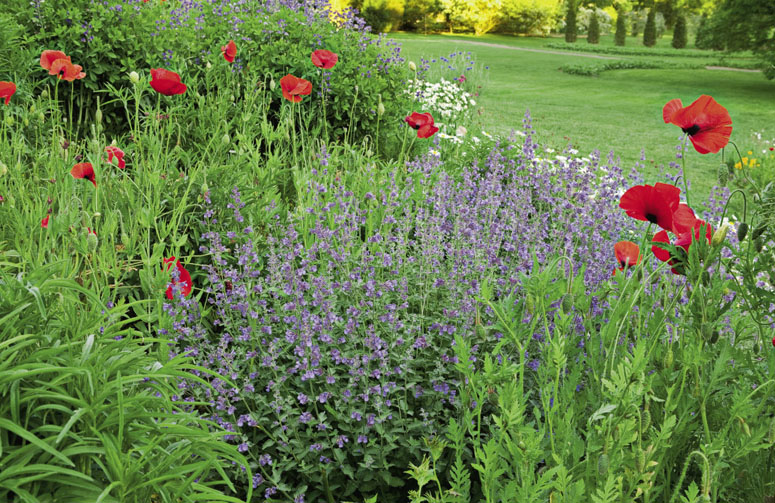
Nepeta racemosa ‘Walker’s Low’
Lamiaceae
catmint
A versatile group of plants that offer subtle but elegant colors and textures, together with aromatic foliage and a remarkably trouble-free experience for the gardener. For cats, of course, catmint, especially Nepeta cataria, provides a truly intoxicating experience.
Close cousins to mints, catmints have aromatic, opposite leaves, square stems, and tubular, two-lipped flowers. However, their roots are seldom as invasive. Commonly catmint foliage is gray-green; the flowers blue spotted with purple. Some species have pink, white, and lilac, even pale yellow blossoms.
Though flowers are individually small, they are borne in verticillasters that produce a more substantial effect. Valuable in several garden niches, catmints range in height from 1–4 ft. for beds and borders, rock gardens, or lining a path or bed. Traditionally rosarians planted catmint to hide the “knees” or stick-like canes of rose bushes. The soft colors and textures of catmints are an attractive counterpoint to the bolder colors and foliage of roses.
Tolerant of dry soils, heat, and full sun, catmints are excellent for xeriscapes, though ordinary garden conditions suffice. They struggle and may melt in the heat and humidity of southeastern US summers; provide early afternoon shade there. Cut back plants hard after their initial flush to promote rebloom. Outstanding for attracting butterflies and bees to the garden; deer resistant, and rarely troubled by insects and diseases.
Divide in spring or fall, or take spring or summer cuttings.
Nepeta govaniana
syn. Dracocephalum govanianum
• yellow
• mid- to late summer
• 1.5–3 ft. × 1.5–2 ft.
• sun, part sun
• Z5–9, HS
Yellow catmint. Himalayas, Pakistan, northern India. Branching stems with velvety, aromatic, gray-green leaves; open racemes of pale yellow, tubular, lipped flowers bloom over a long period. Available in United States primarily as seed; should be more readily available.
Nepeta grandiflora
• blue
• midsummer to midfall
• 24–36 in. × 9–12 in.
• sun
• Z4–9
Caucasus catmint. Caucasus Mountains, eastern and central Europe. Velvety, aromatic, silver-gray leaves and tall, showy spikes of lavender to violet flowers. The following are commonly available as cultivars:
‘Border Ballet’ displays deep violet-blue, almost purple flowers. Start from seed. 18–24 in.
‘Dawn to Dusk’ has soft pink flowers. 24–36 in. × 18–24 in.
‘Pool Bank’ has rich blue flowers, with purple-blue bracts. 30–36 in. × 24 in.
‘Wild Cat’ sports blue-violet flowers with purplish red calyxes. 3 ft. × 2 ft. Z5.
Nepeta racemosa
syn. N. mussinii
• purple, lavender
• midspring to early fall
• 9–12 in. × 12–18 in.
• sun, part shade
• Z4–8, HS
Catmint. Caucasus, northern Iran. This low-growing species forms spreading clumps of decumbent stems with hairy, ovate leaves, with heart-shaped bases and crenate margins. Pale to dark violet flowers, 0.5 in. long. Shear spent blooms to encourage later rebloom. Exceptionally drought tolerant; outstanding for xeriscapes. Self-seeds; may become invasive. Useful for rock gardens, border fronts, herb gardens, for lining paths or beds, and as a groundcover.
‘Little Titch’ has pale blue flowers. 6 in. high and wide.
‘Walker’s Low’ produces abundant crops of lavender-blue flowers; deadhead spent flower spikes routinely for continuous bloom from spring to fall. Sterile. Named for a place, and not its habit. 2007 PPA Plant of the Year. 2.5 ft. × 3 ft.

Nepeta racemosa ‘Walker’s Low’
Nepeta sibirica
syn. Dracocephalum sibiricum
• purple
• early to late summer
• 30–48 in. × 12–24 in.
• sun, part shade
• Z3–8, HS
Siberian catmint. Siberia. Upright with handsome, aromatic, soft gray-green foliage, and whorled clusters of rich blue flowers. Cold-hardiest catmint, but struggles with the mugginess of the southeastern United States. Well-drained soil is essential. Fast growing, good as a low hedge, in coastal gardens, and on sunny banks. Adapts well to containers.
‘Souvenir d’André Chaudron’ has violet-blue flowers. Sometimes sold as ‘Blue Beauty’. 12–18 in. high and wide.
Nepeta subsessilis
• blue
• midspring to early fall
• 1.5–2 ft. × 1–1.5 ft.
• sun, part shade
• Z4–8
Japanese catmint. Moist Japanese mountainsides. Mounds of aromatic, toothed, green leaves, and showy spikes of 2-in., bell-shaped, maroon-spotted, deep violet-blue flowers. Not as drought tolerant. Plant in borders, herb gardens, or naturalized plantings; outstanding for rain gardens.
‘Candy Cat’. Dense clusters of pale lavender-pink flowers. 2 ft.
‘Cool Cat’ has white-specked, lavender-blue flowers. 2–2.5 ft.
‘Sweet Dreams’ bears pink flowers with burgundy bracts. 18 in.
‘Washfield’ carries erect branching spikes of vibrant blue-violet flowers. 1.5 ft.
×faassenii strain, typically sterile and non-invasive, includes: ‘Blue Wonder’, with dark blue flowers. 1–2 ft. ‘Select Blue’. Long, tapered, gray-green leaves in neat mounds; long blooming. Vigorous and drought tolerant. 15 in. × 18 in. ‘Six Hills Giant’ displays 9- to 12-in.-long spikes of deep purple flowers. 3–4 ft.
‘Joanna Read’ (Nepeta sibirica × N. ×faassenii) has darker violet flowers than other nepetas, to 3 ft. Named for Pennsylvania plantswoman Joanna Read. Z3–8.
Solanaceae
cupflower
Although routinely cultivated as annuals, these petunia relatives perform as perennials in mild-winter climates. Winter hardiness varies, but the most cold-tolerant cupflowers overwinter successfully in protected sites as far north as zone 7, or Long Island, NY. South American in origin, cup plants offer attractive dense cushions of narrow leaves and prolific, long-blooming displays of small, cup-shaped, blue, purple, or white flowers.
Full sun, and reasonably fertile, moderately moist soil that drains well, suit these plants best; apply moisture-retaining mulch in hotter regions. Nierembergias struggle with heat and humidity, but cope well with dry heat, with irrigation. Pinch young plants for bushy, compact growth. Deadhead to prolong bloom; shear if flowering flags. Generally trouble free but susceptible to tobacco mosaic virus, slugs, and snails; deer resistant.
Mass cupflowers as a colorful groundcover, let them spill down a sunny south- or west-facing bank, tuck them into a rock garden, or use them to edge beds, borders, or paths. Nierembergias also shine as container plantings and in hanging baskets.
Propagate by seed, layering, or by stem cuttings.
Nierembergia gracilis ‘Starry Eyes’
• blue
• spring to fall
• 10 in. × 18 in.
• sun
• Z8–10
A Yucca Do Nursery introduction that has proven exceptionally tolerant of heat and humidity. Tight mounds of evergreen, linear foliage covered with upward-facing, light lavender, bell-shaped flowers all season.
Nierembergia scoparia
syn. N. frutescens
• blue, white
• late spring to fall
• 1–2.5 ft. high and wide
• sun, part shade
• Z7–10
Cupflower. Chile. Shrubby perennial that forms a dense mound of finely cut, stiff, 0.75-in., linear to spathulate leaves. Cup-shaped, pale blue flowers, to 1 in. across, cover plants for several months.
‘Blue Eyes’ has blue-centered, white flowers. 8–10 in. × 24 in.
‘Mont Blanc’ has yellow-eyed, white flowers. 6 in. × 12 in.
‘Purple Robe’ has violet-blue flowers. 6 in. × 12 in.
Other Notable Cultivars
‘Augusta Blue Skies’ is heat and humidity resistant; lavender-blue flowers. 8–12 in. × 24 in. Z9–11.
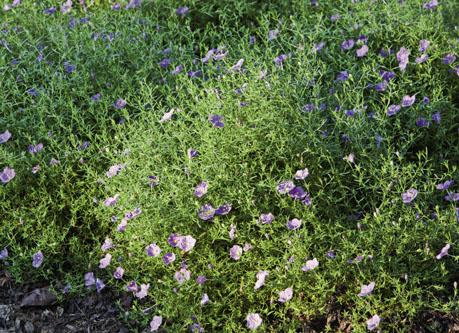
Nierembergia ‘Augusta Blue Skies’
Summer Splash cupflowers from Suntory are fast growing and heat resistant; the series includes: ‘Bouquet Blue’, with yellow-eyed, pale lavender flowers. 6–8 in. high and wide. Z8–11. ‘Bouquet White’ is white with yellow eye, 20–30 in. × 24 in. Z8–11. ‘Light Blue’ is pale blue with blue eyes, 20–30 in. × 24 in. Z9–11.
Asteraceae
Nippon daisy, Montauk daisy
Another genus whose classification has been a subject of debate among botanists: in the past, Nippon daisies, which all derive from a single species, have been included in Chrysanthemum or Leucanthemum; this confusion is evident in nursery catalogs (be warned!). The current consensus is that they deserve their own genus (Nipponanthemum).
Japanese N. nipponicum has naturalized well, particularly in the Montauk region of Long Island, NY, the source of its alternate common name. It is known chiefly as a seaside plant, and its tolerance of salt spray makes it an excellent choice for coastal gardens. However, it also thrives inland, although Nippon daisies are grown less often there.
Nippon daisies have much in common with Shasta daisies (Leucanthemum), but differ mainly in their late flowering season; perfect for fall gardens often short on fresh bloom. Easy to grow.
Best in full sun, in fertile, very well-drained soil, where these daisies are largely self-sufficient. Cut the old growth in late spring, almost to ground level to force strong new growth that will produce abundant bloom later. Left uncut the plants become leggy and ungainly, demanding sedums or low grasses as companion plants to camouflage their ugly “legs.” Suitable in mixed or perennial borders, among foundation plantings and to line walkways, or in dry, difficult areas where watering is impossible. They are superior additions to wildlife gardens where fall-berried shrubs are fine companions; an excellent nectar source for migrating butterflies.
Pests and diseases are seldom serious; if deer and rabbit damage occurs it is also minor.
Root cuttings of young growth, or divide older plants before spring growth commences.
Nipponanthemum nipponicum
syn. Chrysanthemum nipponicum, Leucanthemum nipponicum
• white
• late summer to late fall
• 1–3 ft. × 2–3 ft.
• sun
• Z5–9
Nippon daisy, Montauk daisy. Japan. Stiff branching stems, woody at the base, are clothed alternately with glossy, thick, dark green foliage, that often crowds into the upper portions; the lower leaves may drop prematurely. Toothed leaves, 3.5 in. long, are narrowly oval. The sparkling heads of white flowers may reach 3 in. across, with a central greenish yellow disk. They are held singly on unbranched stems and make fine cut flowers. Deadhead to extend bloom time.
Onagraceae
evening primrose, sundrops
Delicate though these flowers may appear, evening primroses are what ecologists describe as “pioneer plants.” That is, they move in to colonize disturbed sites quickly, and may become weedy if released into gardens. In naturalized areas or patches of poor soil in need of stabilization, this vigorous growth is an asset. When planted into beds, borders, or other designed areas of the landscape, however, care must be taken that their rhizomatous roots do not strangle their neighbors. Conscientious deadheading is essential to limit seeding about, filling the surrounding areas with volunteers. Generally pest and disease free; seldom browsed by deer.
The common names refer to a characteristic of many members of this genus: the flower buds open in the evening, often unfolding in a matter of seconds, to attract night-flying pollinating insects particularly moths. Pollinated by different insects, sundrops open during the day. The four-petaled blossoms are usually yellow, but may also be white, pink, purple, or red. The stigmas are four branched, forming a prominent X at each bloom’s center, an easy identifying mark of the genus.
Propagate by seed, or divide mature plants.
Oenothera berlandieri
syn. O. speciosa var. berlandieri
• pink, white
• spring to fall
• 8–12 in. × 3 ft.
• sun, part shade
• Z5–9
Mexican evening primrose. Texas, southern New Mexico, Mexico. The obovate, 1- to 3-in. leaves are evergreen into zone 8, deciduous farther north. Pink or white, cup-shaped flowers, to 1.5 in. across, are long blooming. Plants adapt well to infertile soils; drought tolerant and ideal as xeriscape plants. This aggressive spreader is useful as a soil stabilizer.
‘Siskyou’ bears prolific crops of fragrant, 2-in.-diameter flowers above small, dark green leaves, irregularly spotted purplish red.
‘Twilight’ has elongated, green-edged, dark bronze-purple leaves, and large, pale pink flowers.
Oenothera fruticosa
• yellow
• late spring
• 15–30 in. × 12–24 in.
• sun, part shade
• Z4–8
Sundrops. Native throughout eastern North America. Erect stems clad with 1- to 3-in. lanceolate leaves rise from basal rosettes. Terminal clusters of bright yellow flowers; individual blooms are short lived but flowers open in succession for up to two months. Seeds borne in distinctive, club-shaped capsules. Thrives on any average to moderately fertile, even poor, well-drained soil; tolerates dryish soils in hot summers.
‘Fyrverkeri’ (‘Fireworks’) sports purple, brown-tinged foliage on red stems; red flower buds open to bright yellow flowers. Superior to the species. Compact, to 18 in. tall.
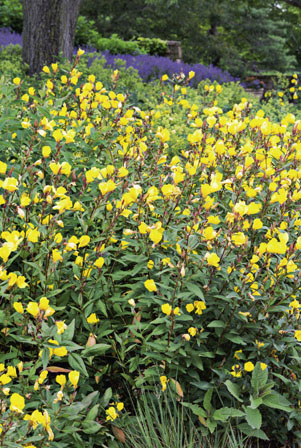
Oenothera fruticosa ‘Fyrverkeri’
Oenothera macrocarpa
syn. O. missouriensis
• yellow
• midspring to midsummer
• 0.75–1 ft. × 1–1.5 ft.
• sun
• Z3–7
Missouri evening primrose. Southern and central United States. Narrowly lanceolate leaves on sprawling stems. Mildly fragrant, usually upward-facing, bright yellow goblet flowers emerge from the leaf axils, followed by 2- to 3-in., winged seedpods. Adapts easily to average, well-drained soils including clays and dry, rocky ones; drought tolerant. Susceptible to root rot if poorly drained.
Oenothera speciosa
• white, pink
• early to late summer
• 0.75–2 ft. × 1–1.5 ft.
• sun
• Z4–9
White evening primrose, pink ladies. Southwestern United States, Mexico. Sprawling stems bear medium green, 1- to 3-in., narrowly lanceolate to oblanceolate leaves, sometimes lobed below. Showy, bowl-shaped, fragrant, 3-in. flowers are borne in leaf axils; they open in the evening, at first white but maturing to rosy pink. Seed capsules are oval, ridged, and 2 in. long. Self-seeding, plus spreading rhizomes can be aggressive. Tolerates light afternoon shade and drought. Cultural needs are similar to other species.
‘Pink Petticoats’ has yellow-centered pink blooms.
Other Notable Cultivars
‘Cold Crick’ seems to be a chance hybrid that is sterile and does not set seed. It is a clumping plant that does not spread. Typical bright yellow, cup-shaped flowers over a long period. Day blooming. 10–12 in. × 12 in. Z5–8.
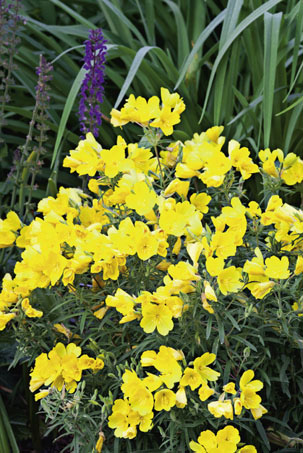
Oenothera ‘Cold Crick’
Boraginaceae
navelwort
Few woodland plants are more charming companions for spring-blooming bulbs. Navelwort’s bright blue, often white-eyed flowers with spreading petals are reminiscent of related forget-me-nots and hound’s tongue. Excellent shaded in wild gardens, along walkways, in rock gardens, for edging, or mass planting as groundcovers, navelworts are evergreen in mild-winter climates, semi-evergreen elsewhere. Provide humus-rich soil as might be found under deciduous trees, in part shade. Although navelworts tolerate short periods of drought, they are unsuitable for dry gardens.
Apart from slugs and snails, which dine on the young growth, pests and diseases are seldom serious. Navelworts resist deer and rabbits.
Divide carefully in spring, disturbing the roots as little as possible. Sow seed in spring.
Omphalodes cappadocia
• blue
• early spring
• 8–12 in. × 12–15 in.
• part shade, shade
• Z6–8
Navelwort. Turkey. Clumps spread slowly by rhizomes and become substantial over time. Basal tufts of 4-in., lightly hairy leaves, ovate to heart shaped and pointed at the tips; loose terminal clusters of up to ten white-eyed, azure flowers bloom above.
‘Cherry Ingram’ has bright blue flowers that mature to lavender. 12–18 in.
‘Joy Skies’ is long blooming into early summer. Arching, trailing stems with lance-shaped leaves; open, starry, azure flowers. 12 in.
‘Starry Eyes’ has white flowers with a sky-blue flare down the middle of each petal. 10 in.
Omphalodes verna
• blue
• spring
• 6–8 in. × 12 in.
• part shade, shade
• Z6–9
Blue-eyed Mary, creeping navelwort, creeping forget-me-not. Southern Europe. Named for Queen Marie Antoinette, this creeper spreads rapidly by underground stems. Its hairy, pointed, 1- to 3-in., oval leaves have conspicuous veins; evergreen in mild-winter regions. Useful in informal cottage gardens, in city courtyards, and on banks as well as along woodland edges.
‘Alba’ is white flowered.

Omphalodes verna ‘Alba’
‘Grandiflora’ has larger electric-blue flowers and coarse foliage. A fine groundcover under spring shrubs, especially rhododendrons. 6 in. tall.
Asparagaceae (Convallariaceae)
mondo grass
This Asian genus is valuable in the garden for its smooth, slender, grassy leaves that serve well as ground cover, as edgings along pathways, at the front of borders, or in rock gardens. Evergreen in mild climates, but becomes wind and frost damaged by severe cold. Mondo grass contrasts well with larger-leaved hostas, as well as delicately foliaged ferns and astilbes.
Ophiopogons are often confused with similar Liriope and share a common name, lilyturf. A singular difference is that liriope flower spikes are held above the leaves, in contrast to those of mondo grass that often are almost hidden among the foliage.
Very adaptable about soil, mondo grass does best where it is fertile and drains well. In cooler climates, a sunny spot is fine, but elsewhere part or light shade is preferable. Does not tolerate drought, but handles heat and humidity well. Avoid mulching black-leaved selections with dark-colored mulch as visual impact is lost, bright ferns contrast well. Seldom bothered by deer or rabbits, but slugs and snails may shred the leaves.
Easy care, mondo grass spreads slowly. As a groundcover, set the plants 8–10 in. apart (even closer if they are small) so they knit together quickly. Cut back almost to ground level in spring as new growth commences. In colder regions, foliage often becomes shabby in cold weather, especially where it is windy; don’t be afraid to cut back hard.
Propagate by dividing the roots in spring as new growth emerges, or start from seed sown as soon as it is ripe.
Ophiopogon japonicus
syn. Mondo japonicum
• white, lilac
• summer
• 8–15 in. × 12 in.
• sun, part shade
• Z6–11, HT
Mondo grass, dwarf lilyturf. Native in shaded woodlands of Korea and Japan. Rhizomatous and clumping with slender, grassy, 12-in.-long leaves, often curved. Short spikes of 0.25-in., bell-shaped flowers nestle among the foliage. Blue-black, 0.5-in., berry-like fruits follow. Good in coastal gardens. There are several notable cultivars:
‘Compactus’ is very small, reaching only about 2 in. Charming in troughs.
‘Kyoto Dwarf’ is also compact, about 2–4 in. tall.
‘Nana Variegata’ has short tufts of silver-rimmed, dark green leaves. 2–3 in.
‘Silver Dragon’ has leaves variegated with white. 12 in. ‘Variegatus’ is similar.
Ophiopogon planiscapus
• white, purple
• summer
• 8–15 in. × 12 in.
• sun, part shade
• Z6–11
Lilyturf, mondo grass. Japan, Korea. The species is seldom offered, in favor of the dramatic purplish black–leaved cultivars included here. Spreading clumps of evergreen, strap-shaped leaves rise from rhizomatous roots. Lavender-flushed white flowers in 2- to 3-in. racemes; small, deep blue-black berries follow.
‘Niger’ (‘Nigrescens’, ‘Black Dragon’, ‘Arabicus’) has near-black persistent foliage and short spikes of pinkish light purple to white flowers that nestle among the foliage. Purplish black berries. Contrast with silver- or gold-foliaged plants: wormwoods, lamb’s ears, or golden creeping Jenny. Spreads slowly. 6–8 in.
Ebony Knight (‘Ebknizam’) has evergreen, purple-black foliage; spikes of small lavender flowers and small black berries. Slow spreading; excellent in otherwise inhospitable dry sites.
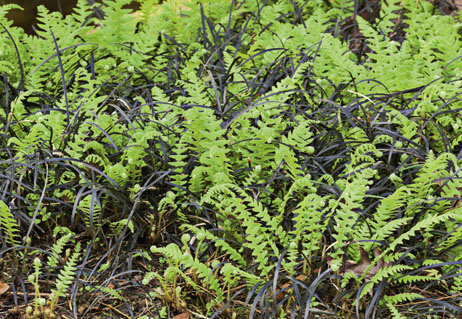
Ophiopogon planiscapus ‘Ebony Knight’, with ferns
Cactaceae
prickly pear
Cacti are considered plants of the southwestern American deserts, but opuntias are in fact indigenous throughout the United States, except northern New England. Characterized by their combination of broad, flat, fleshy pads (cladodes) and their armament of large spines, combined with smaller, easily detached, hair-like prickles (glochids), commonly prickly pears also offer large, showy flowers, and edible red or purple fruits. In ornamental landscapes they provide striking textural contrast, and a nearly impenetrable barrier when massed. Almost invulnerable to drought, prickly pears are an obvious choice for xeriscape plantings, and an effective groundcover for sandy or gravely sunny banks. Their simple, architectural form is interesting in container plantings. Be aware, however, that prickly pears shrivel in chilly regions at the onset of cold weather, and remain unsightly until they plump up again in spring. Resistant to rabbits and deer; attracts hummingbirds.
Providing very well-drained soils in an open location with full sun is critical. Opuntias are susceptible to few pests and diseases over most of their range, but persistently damp soils are lethal. In the southeastern United States, principally Florida and Louisiana, the larvae of an introduced moth, Cactoblastis cactorum, attacks prickly pears. This creature tunnels into the pads destroying them from the inside out; evidence of them should be immediately reported to your local Cooperative Extension.
Propagate by removing and rooting pads.
• pink, mauve
• mid- to late spring
• 6–12 in. × 1–6 ft.
• sun
• Z7–10
Beavertail cactus. California to Utah, south through Arizona. Gray-green pads, 1–6 in. × 2–13 in., with fancied resemblance to a beaver’s tail. Almost to completely spineless pads; clad with glochids. Brilliant 2- to 3-in., red-to-lavender flowers; 1-in., brownish gray, oval fruits follow.
Opuntia cacanapa
• yellow
• early to midsummer
• 3–4 ft. × 4–6 ft.
• sun
• Z7–10
Tiger tongue. Southwestern United States, northern Mexico. Chiefly available as the spineless (and glochid-less) selection ‘Ellisiana’. This forms a mound of erect, 6-in., gray-green, spineless pads. Large red fruits follow bright yellow flowers. A boon to gardeners with sensitive hands and skin.
Opuntia humifusa
syn. O. compressa
• yellow
• early summer
• 0.5–1 ft. × 1–3 ft.
• sun
• Z4–9
Eastern prickly pear. Eastern and central United States, north to southern Ontario. Forms jointed clusters of round-to-oval, flattened, succulent, green pads, 2–10 in. across. Showy bright yellow flowers, some with reddish eyes, are 2–3 in. in diameter with 8 to 12 yellow petals and a thick central boss of yellow stamens. Edible, red, egg-shaped fruits, to 2 in. thick, have a melon-like flavor. They ripen in late summer to fall; difficult to harvest. Well adapted to rock gardens, dry-stone walls, sandy slopes, and dry prairie plantings. Opuntia macrorhiza is very similar.
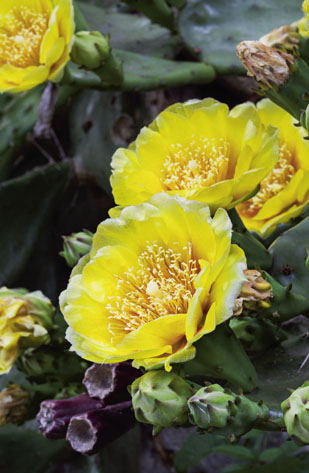
Opuntia humifusa
Lamiaceae
oregano
If you think oregano is useful only as a culinary spice, think again, for several species can also add savor to perennial gardens. As Mediterranean region natives, these plants thrive with little water and high heat, but cannot tolerate high humidity.
Erect or spreading stems carry opposite pairs of aromatic leaves; clusters of flowers are borne in whorls around the stems. Individual blossoms are tiny, two-lipped, mostly tubular, and protected by colorful bracts that remain attractive for several weeks. Oreganos do best in sunny spots in average or even poor soils that drain freely, preferably with an alkaline pH; dress plants with lime if soil is acid. Root rot may result from poor drainage. Little care is required, except for shearing back in early spring as new growth commences.
Ornamental oreganos are appropriate for mixed and perennial borders, in herb gardens, and as edgings in vegetable gardens; the lower growers are attractive in rock gardens and tumbling over walls. Good where water is scarce. Bees and butterflies flock to them; deer and rabbit resistant.
Propagate by seed or division in spring, or take cuttings of young basal growth in late spring.
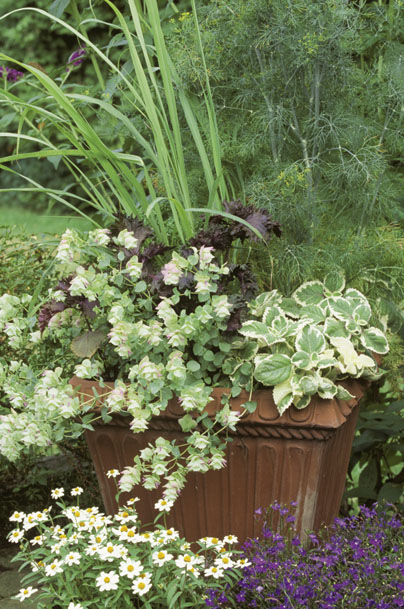
Origanum ‘Kent Beauty’ is a central player in this ornamental herb design
Origanum laevigatum
• purple
• mid- to late summer
• 1–2 ft. × 2 ft.
• sun
• Z5–9
Marjoram. Turkey, Cyprus. Wiry, upright or sprawling stems, often maroon, rise from woody rootstocks. Oval, dark green leaves, about 0.5 in. long with conspicuous veins, borne in opposing pairs. Tubular, 0.5-in., purplish pink flowers with darker bracts cluster at stem tips from midsummer on. Stems may flop with the weight of the flowers; stake at 6–12 in. with pea sticks, grow among stronger stemmed companions, or allow to tumble over a retaining wall. Appropriate with roses and summer perennials, especially in fragrance gardens.
‘Herrenhausen’ has increasingly deep maroon foliage as nights cool. Light purple flowers. 2 ft.
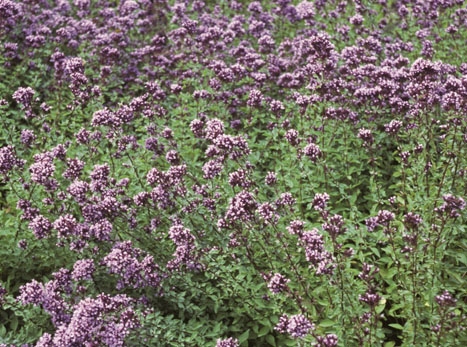
Origanum laevigatum ‘Herrenhausen’
‘Hopley’s Purple’ has bright purple flowers, large, 0.5-in. bracts, and purplish foliage that greens in summer. Lovely fresh or dried cut flower. 2 ft.
‘Pilgrim’ is upright with bluish green leaves; bright rosy flowers. 15–18 in.
Origanum libanoticum
• pink
• midsummer
• 12–18 in. × 18–24 in.
• sun
• Z5–10
Cascading ornamental oregano, hopflower oregano. Lebanon. Trailing wiry stems are embellished at the tips by hop-like whorls of pink-tipped, pale green bracts guarding tiny, pink flowers. Smooth, rounded leaves are bluish green. A fine subject to billow over and decorate walls and terraces, and for hanging baskets and window boxes.
Origanum rotundifolium
• pink
• early to late summer
• 9–12 in. × 12 in.
• sun, part shade
• Z5–8
Round-leaved oregano. Turkey, Armenia. Low mounds of aromatic, grayish green, rounded, 0.5-in. leaves, and nodding clusters of apple-green bracts that shelter small, pink flowers.
‘Kent Beauty’ has largely replaced the species in gardens. This beautiful mounding plant has rounded, 1-in., blue-green leaves with prominently white-etched veins, and abundant apple-green-bracted pink flowers in hop-like clusters. The bracts are often flushed with pink especially on the undersides. Use stems in fresh floral arrangements or cut before they brown for winter decoration. Plant in hanging baskets, on top of a wall, or in raised beds or containers.
Origanum vulgare
• pink, purple
• midsummer to fall
• 12–36 in. × 15–24 in.
• sun
• Z4–9
Oregano, pot marjoram, wild marjoram. Europe. The most widely used culinary oregano. Vigorous, spreading by rhizomes. Very aromatic, 1- to 2-in. leaves are rounded and fuzzy, green in the species. Loose, whorled clusters of small flowers in light pinks to deep pinks and purples, with leaf-like, purple-flushed bracts. Cultivars include:
‘Aureum’ (Golden Oregano) has golden foliage; pink flowers. Not as aggressive as the species. An attractive groundcover in rock gardens, or herb garden edgings. 4–6 in. tall.
‘Aureum Crispum’ has curly yellow leaves crisped along the edge.
‘Compactum’ is 2–4 in. tall.
subsp. hirtum (syn. Origanum heracleoticum) is Greek oregano, the subspecies with the strongest flavor. White flowers, hairy leaves and bracts. Greece and Turkey.
Crassulaceae
hardy dunce cap
Some plants provide the big effects—others, such as Orostachys, provide the small but unforgettable details. A genus of 13 small but exquisite succulents, these plants form compact rosettes of fleshy, scale-like leaves. As they mature, the original rosette extends slender stems that form new rosettes at their tips, creating a slowly expanding but typically compact colony. When a rosette has fully matured, usually after a period of years, its center bulges upward, forming a conical spike (or “dunce cap”) of smaller scales that finally covers itself with tiny flowers. The rosettes are monocarpic—i.e., they die after flowering just once, but a plant lives on through the younger offsets. An obvious choice for trough gardens and containers, this genus includes some of the cold hardiest of all succulents and provides gems for rock or gravel gardens too.
These designer dunce caps require very well-drained, preferably sandy soil, and prefer dry winters; cold, wet, winter soil is fatal. Water regularly, but avoid wetting the leaves. Orostachys tolerates light shade, but the rosettes are tightest and most attractive when grown in full sun. Mostly trouble free, except for a susceptibility to aphids and deer.
Propagate by detaching and replanting offsets.
Orostachys aggregatus
syn. Sedum aggregatum
• white, yellow
• late summer
• 3–6 in. × 3–12 in.
• sun
• Z5–8
Dunce cap. Native to Japan. Forms tight basal rosettes of oblong to oval, grayish green, 1-in., succulent leaves. Clusters of rosettes spread over time to 12 in. or more. Leaves turn purplish in fall. Tiny, white to pale yellow flowers. As a groundcover, plant at 12-in. intervals. Naturalizes where hospitable.
Orostachys furusei
• yellow
• late summer
• 3–6 in. × 6–12 in.
• sun
• Z6–10
Dunce cap. Asia. Basal rosette, to 4 in. high and wide, of succulent, oblong, lavender-gray leaves to 1 in. long. Thin, stolon-like branchlets emerge from leaf axils to produce offsets at their tips, and develop into clusters to 12 in. across. Tiny, yellow flowers held in 6-in. spikes, appear usually during the second or third year of growth.
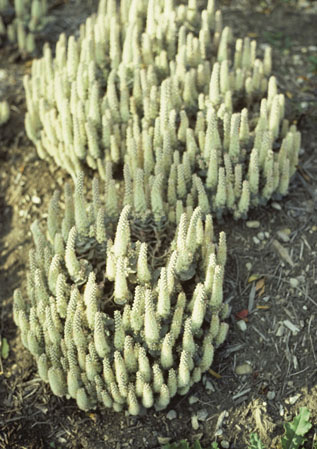
Orostachys furusei
Oxalidaceae
shamrock, sorrel
It is unfortunate that so many gardeners have had to battle with self-seeding, weedy oxalis, and have become gun-shy about even looking at some of the 800 or more species, many of which are highly garden worthy. Species are native across the world, with the exception of the Poles. North and South America, South Africa, and Brazil are home to many.
Species that have become the bane of many gardeners include yellow-flowered creeping wood sorrel (Oxalis repens), yellow wood sorrel (O. stricta), and creeping, or yellow sorrel (O. corniculata). All release their seeds explosively and are on numerous invasive exotic lists.
Mostly, leaves are divided into three more or less triangular leaflets that fold together at night. The solitary or clustered flowers are yellow, pink, or white, and also may close at dusk. Leaves have a sharply bitter taste due to sour oxalic acid.
For best effect, group shamrocks in the landscape. Most prefer a lightly shaded place, but tolerate sun well in regions where it is not too intense. Slightly acid, well-drained, average to fertile soil is perfect; dig in compost at planting time to help retain moisture. Shamrocks make superior indoor plants where there is plenty of light but not necessarily direct sun: windowsills, sunrooms, or greenhouses; a pre-made container soil mix is best. Do not overwater, but these are not desert plants either, so keep the soil damp. If foliage becomes shabby from drought or too much sun, pull affected leaves out with a sharp tug and keep watered; after a light feeding, the foliage will come back fresh and new. Water sparingly through short winter days.
In the landscape oxalis can be massed on a large scale, or used to edge paths and walkways. In summer borders, they blend well with coral bells, low hardy geraniums, and Sedum rupestre ‘Angelina’. Dark-foliaged types provide interesting foils for silver- and gold-leaved plants such as Hosta ‘Gold Edger’ or ‘Piedmont Gold’, Artemisia ‘Silver Mound’, or Tradescantia ‘Blue n’ Gold’ (‘Sweet Kate’). Interesting in large mixed containers with coleus, forced spring bulbs, or succulents. Other interesting species include O. crassipes, O. bowiei, and an adorable newcomer, O. palmifrons, that surely must become a winner.
Problems include rust, manifested by orange pustules on the leaves causing discoloration. Deer and rabbits rarely browse oxalis.
Increase by dividing the rhizomes or small bulb clumps as they become overcrowded.
Oxalis regnellii
• pink
• summer
• 4–8 in. × 12 in.
• sun, part shade
• Z6–11
Oxalis, purple shamrock. South Africa, South America. Often grown as a houseplant, this oxalis will also be fine outdoors within its zones; non-invasive. Small tubers multiply readily to form good-sized clumps in a couple of years. Rising from the tubers, slender, watery, 3- to 6-in. stems support green, tripartite leaves marked with a central triangular blotch. Flower stems are brittle, with two to four pink or white, funnel-shaped, 1-in. flowers. Blooms almost year-round indoors, and all summer in the landscape. Winter deciduous except indoors.
‘Atropurpurea’ has leaves purplish green above, but deep purple beneath.
‘Jade’ (‘Charmed Jade’, ‘Jroxfroja’) has olive-green leaves and white flowers.
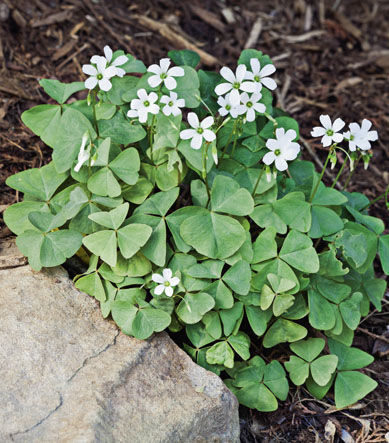
Oxalis regnellii ‘Jade’
‘Silverado’ (possibly a synonym for ‘Silver Shadow’). Olive-green leaflets conspicuously marked with silver. White flowers.
subsp. triangularis. Purple-and-black false shamrock, love plant, purple shamrock. The nomenclature of this plant is confused. Easy and clumping, this subspecies has triangular, dark purple leaflets irregularly and widely bordered with velvety black. Clusters of pale pink, 1.25-in. flowers. 8–10 in. Z6–10.
The Triangularis Group has received considerable breeding attention, resulting in notable strains: The Allure series includes unpatterned foliage: Burgundy (purple with pink flowers), Ebony (black with white flowers), Lavender (mauve pink with white flowers), Mahogany (brownish with pink flowers), and Silver (metallic jade with pink flowers). The Charmed Series includes plain-leaved Velvet (very dark purple with white flowers), Jade (pale pink-flushed white flowers), and Wine (plum colored leaves, pink flowers).
Oxalis tetraphylla
syn. O. deppei
• pink
• late spring to summer
• 4–6 in. × 6 in.
• sun, part shade, shade
• Z7–10
Good luck plant, lucky clover. Mexico. Arising from small, scaly bulbs, the bright green leaves of this charmer are composed of four triangular leaflets each about 2 in. long with rounded edges. Each leaflet may be accented with a purple-red chevron pointing toward the tip. Clusters of funnel-shaped, five-petaled, rosy pink flowers, yellowish at the throat, open wide in sun.
‘Iron Cross’ is notable for the dark burgundy cross-shaped blotch that marks from the base to about halfway along each leaflet.
Buxaceae
spurge
The most familiar species of this genus, Japanese pachysandra (Pachysandra terminalis) is a plant undone by its own popularity: it has become such a cliché of suburban American landscapes that many serious gardeners avoid it on principle. Nevertheless, it can be an invaluable problem solver. Indeed, for a shady or semi-shaded site in temperate, moist climates, Japanese pachysandra and Allegheny spurge, P. procumbens, have no equal when it comes to excluding weeds and providing neat, fast-spreading evergreen or semi-evergreen groundcovers. Their growth habit, the way in which they infiltrate the surface of the ground with a dense network of rhizomes, enables them to flourish on soils too shallow to support much else as long as moisture is adequate. As a result, they thrive even under shallow-rooted maples and other trees.
Japanese pachysandra won the favor of landscapers by its trouble-free nature; once established on a site, it requires almost no maintenance. Recently, however, it has fallen prey to fungal pachysandra leaf blight (Volutella pachysandricola), which if not addressed rapidly destroys even extensive plantings. Fortunately, the American species has so far proven immune.
Divide in spring or take softwood cuttings in early summer.
• white
• early spring to midfall
• 6–10 in. × 24 in.
• part shade
• Z6–9
Spurge. Sichuan, China. Evergreen, slow growing; forms small clumps that spread by underground stolons. Leaves somewhat glabrous, triangularly lanceolate with irregular serrated edges. Inconspicuous spikes of tiny white, mildly fragrant flowers borne in the leaf axils. Prefers shady, moist site. No reports of susceptibility to leaf blight. Still uncommon but gaining popularity.
‘Windcliff’, a Dan Hinkley introduction, is low growing. 4–6 in. tall.
Pachysandra procumbens
• white
• early spring
• 6–10 in. × 12–24 in.
• part shade, shade
• Z5–9
Allegheny spurge. Rich woods and rocky slopes of Kentucky, West Virginia, and western North Carolina to northwestern Florida and southern Louisiana. Clump forming with procumbent stems. Evergreen (semi-evergreen in colder regions), scalloped, pewter green, ovate leaves develop pale silver mottling that fades as leaves mature. Bottlebrush-like, 2- to 4-in. spikes of small, fragrant, white flowers. Avoid poorly drained, heavy clay soils. Handsome foliage for shady beds or borders, excellent groundcover for shaded areas, especially appropriate for woodland gardens. Less aggressive than Pachysandra terminalis, coexists with other woodland natives, a useful cover for spring ephemerals. No serious pest or disease problems.
‘Eco Treasure’ has more heavily variegated leaves.
‘Forest Green’ is variegated with silvery white blotches; heavier tufts of leaves on each stem. Good for gardens of the Mid-Atlantic region. 6–12 in. Z4–9.
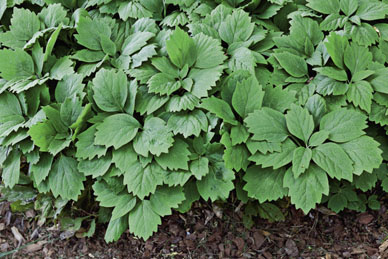
Pachysandra procumbens ‘Forest Green’
Pachysandra terminalis
• white
• early spring
• 6–12 in. × 12–18 in.
• part shade, shade
• Z5–9
Japanese pachysandra, Japanese spurge. Japan, north-central China. Evergreen, spreads vigorously by rhizomes. Ovate, 2- to 4-in. leaves borne in whorls at stem tips. Terminal, 1- to 2-in. spikes of tiny, scentless, white to pinkish flowers. Tolerates clay and dry soils, drought, dense shade, deer, and rabbits. Good air circulation discourages leaf blight; root rot, scale, and mites may be problems.
‘Green Carpet’ has deep green foliage.
‘Green Sheen’ has extra glossy, bright green leaves.
‘Variegata’ has gray-green to dark green leaves with irregular creamy-white mottling along the edges. Not as vigorous.
Paeoniaceae
peony
As close to foolproof as any perennial can be, peonies offer spectacular, fragrant bloom combined with handsome foliage, and a lifespan that may last half a century or more. The Chinese, who brought peonies into their gardens as early as the 7th century ad, first recognized the ornamental potential of this genus. Contemporary gardeners will find peonies useful when planted singly for adding substance as well as color to mixed borders, and fine material for low, informal hedges.
Peonies are unmatched as cut flowers. Shasta daisies, flax, and bearded irises all make good companions for them. Easy and generally pest free; susceptible to foliar diseases, botrytis blight, and phytophthora blight, especially where air circulation is poor. Deer and rabbit resistant.
Peonies are another genus that offers an embarrassment of riches; there are many hundreds of cultivars from which to choose. Fortunately, identifying those that suit your conditions and taste is a relatively simple process.
Garden peonies are commonly divided into three groups:
Herbaceous peonies behave as perennials, dying back to the ground every fall. The older cultivars, which descend from Chinese garden peonies, are mostly selections of the species Paeonia lactiflora. Many modern breeders continue to work within that group, but in the 20th century a number of hybrid groups, descended from crosses of two or more species, appeared; hybrids represent an increasing proportion of the new introductions. Herbaceous peonies form multi-stemmed clumps, 1.5–3 ft. high and wide, with shiny green leaves that persist throughout the summer. They bloom during the transition from spring into summer, with each individual cultivar blooming for an average of seven to ten days. Flower colors of herbaceous peonies range from white to yellow to coral to pink to red to maroon. There are no blues, and true yellows are rare: the species P. mlokosewitschii bears lemon-yellow flowers, and a handful of hybrids, including ‘Claire de Lune’, ‘Prairie Moon’ and ‘Goldilocks’, also have pale yellow flowers.
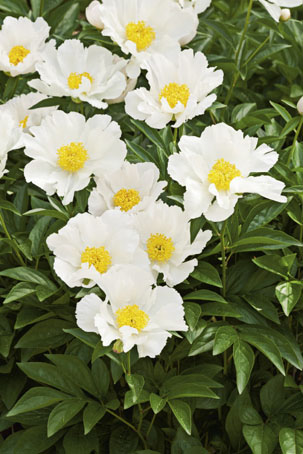
Paeonia lactiflora ‘Krinkled White’
Tree peonies, despite their name, are deciduous, woody-stemmed shrubs. A mature tree peony in full flower is one of the most dramatic sights of spring gardens, and provides a magnificent focal point in a mixed border. As shrubs, however, they are outside the scope of this guide.
Itoh peonies, or intersectional peonies, are crosses between herbaceous and tree peonies. These hybrids behave like herbaceous perennials, but exhibit the larger blossom type of their shrubby parent, with flowers 8–10 in. in diameter. They are outstandingly floriferous; mature plants may bear 30 to 50 blossoms apiece. Flower color range is similar except that the intersectionals include more bright yellows. Their height and spread is similar to that of herbaceous peonies, typically 2–3 ft. Disease-resistant foliage. Mostly hardy to zone 4.
Peonies are further categorized by their flower form:
Single. Flowers with a single ring of petals
Japanese/anemone type Flowers whose pollen-bearing stamens have become more or less transformed into staminodes or narrow petaloids, resulting in slightly fuller blossoms.
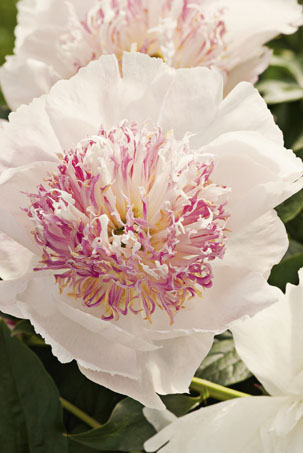
Japanese/anemone type Paeonia ‘Do Tell’
Semi-double. Flowers with more than one row of petals emerging from the crown of the flower; the central cluster of pollen-bearing anthers is visible during bloom.
Full double. Flowers with multiple rows of petals, with so many of the floral stamens and stigmas converted into petals that no trace of the flower’s sexual parts are visible.
Bombs. A type of double peony; the central petals form a globular cluster that rests on a “halo” of flattened outer “guard” petals; guard petals are often differently colored from the central petals.
Growers also commonly categorize herbaceous peonies by indicating when a cultivar blooms within the four- to five-week herbaceous peony season. Intersectional peonies have a prolonged period of flowering; individual plants typically remain in bloom for three to four weeks, peaking near the end of the herbaceous peony season.
Peony flowers are famous for their intoxicating fragrances, from sweet to citrusy and spicy. Not all peonies are fragrant; the perfume intensity varies markedly even among fragrant types. Double-flowered selections tend to be more fragrant than single ones; pink- or white-flowered types have more fragrance than red-flowered ones. A light but pronounced citrus or spicy fragrance is common among the intersectionals.
Paeonia lactiflora cultivars are mostly hardy through zone 2. Other species and many hybrids may be less cold hardy, but commonly overwinter successfully through zone 3. The intersectional peonies are hardy to zone 4.
Peonies require between 500 to 1000 winter chilling hours (between 32–40°F) to flower successfully; zone 8 is the southern edge of their range. Gardeners in warm regions find that early-blooming cultivars are best adapted to their climate; the onset of very hot weather in late spring causes the buds of late-blooming cultivars to abort. Furthermore, single or Japanese types generally perform better in such areas than do doubles. The intersectional peonies cope well with the combined heat and humidity of southeastern summers.
Most peonies prefer full sun. In zone 8 where the summer sun is intense, partial shade is beneficial. Several species tolerate moderate shade, especially P. anomala, P. mlokosewitschii, and P. obovata (P. japonica).
Paeonia anomala
• red
• late spring
• 18–24 in. high and wide
• sun, part shade
• Z2–7
Anomalous peony. Native to coniferous woods, dry grasslands, rocky hillsides, northern Russia through central Asia. Striking deep green leaves, deeply divided into long, narrow leaflets, on sturdy stems; foliage turns orange-yellow in fall. Upward-facing, sweetly perfumed, single, intense rose-red flowers to 3 in. wide, with central bosses of golden anthers. Provide well-drained, moderately fertile soil. More shade tolerant than Paeonia lactiflora types; good for woodland edges. Usually blooms about three weeks ahead of most garden cultivars. Reportedly resistant to botrytis. Good for rock gardens, borders, and among other shrubs in woodland clearings.
Paeonia brownii
• red
• late spring to early summer
• 8–20 in. × 12–18 in.
• sun, part shade
• Z5–7
Western peony. Native to chaparral, sagebrush, and pine forests from eastern Washington, south through the northern two-thirds of California; east to Utah, western Wyoming, and Idaho. Clusters of stems bear fleshy, twice-divided leaves with oval leaflets covered with white to blue, waxy powder. Flowers solitary at stem tips, pendulous, and single, with reddish brown petals edged with greenish yellow. Drought tolerant; intolerant of wet winters. Good for rock gardens or xeriscapes.
Paeonia californica
• red
• late winter to early spring
• 12–18 in. × 12 in.
• sun, part shade
• Z8–10
California peony. Native to southern coastal range and Baja California. Leaves deeply lobed, 4 in. long, dark green on top, paler underneath. Adapted to warm, dry climates; winter rains stimulate its growth cycle; 2-in., cup-shaped, nodding, maroon flowers appear in midwinter. Summer dormant; requires very well-drained soil as summer moisture causes root rot. Best for the semi-arid regions and xeriscapes.
Paeonia mlokosewitschii
• yellow
• late spring to early summer
• 18–24 in. high and wide
• sun, part shade
• Z4–9
Golden peony, Molly-the-witch. Caucasus Mountains. Soft blue-green leaves, each with three to seven round-tipped leaflets; emerging foliage is purplish, and retains purple margins, stems, and petioles well into growing season. Early-blooming, pale yellow, shallowly cupped, 3- to 5-in. flowers are single; yellow anthers cluster around central yellow-green carpels (ovaries). Mildly fragrant, shade and drought tolerant, prefers fertile, well-drained, average to moderately moist soil. When seeds ripen, the enclosing receptacle splits, exposing a shiny red or pink interior, set with scarlet and shiny blue-gray seeds. A superb accent plant in borders, cottage gardens, or at woodland edges.
Paeonia obovata
• white, red, purple
• late spring to early summer
• 1–2 ft. high and wide
• sun, part shade
• Z5–8
Woodland peony. Native to woodlands from Siberia through Manchuria, northern China and Japan. Gray-green leaves divided into oval to broad-elliptic leaflets, with terminal leaflets obovate. Single, cup-shaped flowers are rose-purple centered with yellow stamens; mildly fragrant; midseason. Receptacles split when seeds ripen in late summer, revealing red interiors studded with glossy black seeds. Blends well in bright woodland settings with hostas, astilbes, and other woodland flower and foliage perennials. Single, white-flowered Paeonia japonica is now considered a variant of P. obovata.
‘Alba’ has white flowers.
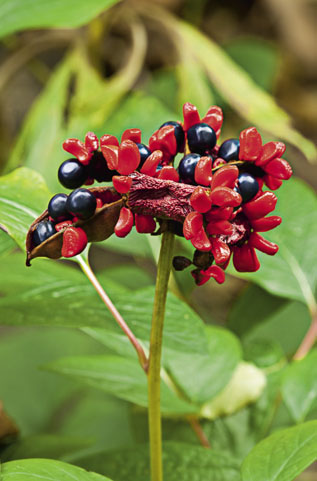
Fruiting head of Paeonia obovata
Paeonia tenuifolia
• red
• mid- to late spring
• 12–24 in. × 9–18 in.
• sun, part shade
• Z4–8
Fernleaf peony. Southeastern Europe, Turkey, Caucasus. Persistently attractive foliage is feathery, deeply divided, and lobed. Midseason; 2- to 3-in., crimson flowers. Provide rich, moderately moist, well-drained soil. Well adapted as accent plants in perennial borders, for low hedges, and as edgings along walkways.
Papaveraceae
poppy
A good news, bad news genus, poppies offer glorious flowers and robust growth, two qualities that have made them traditional garden favorites. First cultivated ornamentally roughly 7000 years ago in Mesopotamia, withered poppy blossoms have been found in Egyptian tombs. On the negative side, several perennial poppies, including Oriental poppies, become summer dormant. Soon after spring bloom time, the foliage becomes unsightly before disappearing altogether, leaving a gap in the border. Partner poppies with expansive, later-blooming perennials to fill the hole, or plug in summer-blooming annuals. Oriental poppies, the showiest and most popular of the perennial species, have a short season of bloom: this lasts but a week or two, though at their peak these flowers eclipse any others in the garden.
Species poppies have four to six petals, commonly red or orange, often with a black blotch at the base, encircling a knot of stamens and a compound pistil. Cultivars and garden hybrids include many double forms and a color palette of oranges, reds, yellows, lilacs, and purples, as well as white. Fertilized flowers display characteristic salt cellar–like, bulbous seed capsules; when ripe and shaken by the wind, tiny seeds escape through pores just below their circular caps. Basal clumps of alternate, commonly petioled, pinnately divided leaves, stem leaves sessile. Foliage and stems are usually hairy.
Native to open, sunny habitats on rocky hillsides and colonizers of disturbed soils, poppies thrive as agricultural weeds. In cultivation they prefer fertile, humus-rich, moderately moist, well-drained soils in full sun. Where summers are hot, provide light afternoon shade; poppies thrive in cool summer areas and struggle with southern heat and humidity. They strongly resent root disturbance and once established should not be moved.
The pharmaceutical potency of poppies varies with the species, but common sense dictates avoiding consumption. They are handsome as cut flowers; seal the stem ends with a flame immediately after harvesting.
Propagate by seed sown directly or in peat pots. Increase cultivars by root cuttings.
• orange, white, yellow, red
• late spring to early summer
• 6–10 in. × 6–8 in.
• sun
• Z3–7, HS
Alpine poppy. Mountains of western and central Europe, Balkans. Low rosettes of fern-like, olive-green leaves; satiny, cup-shaped flowers, 1–3 in. wide carried on upright stems in assorted colors. Short lived in zone 5 to 7, but a self-seeding annual or biennial elsewhere. Best adapted to troughs, rock gardens, and cottage gardens; drought tolerant. Deadhead to prolong bloom.
Papaver atlanticum
• orange, red
• spring to fall
• 12–24 in. × 9–12 in.
• sun, part shade
• Z5–10
Atlas poppy, Atlantic poppy. Morocco. Low rosettes of hairy, 1-in.-wide, blue-green leaves to 4 in. long. Flowers to 3 in. across, followed by club-shaped seed capsules. Drought tolerant; requires well-drained soil. Reblooms, without summer dormancy; reseeds freely. Rock gardens, containers, gravel gardens, or xeriscapes.
‘Flore Pleno’ has semi-double apricot flowers.
Papaver nudicaule
• orange, pink, red, yellow, white
• late spring to early summer
• 12–24 in. × 9–12 in.
• sun
• Z2–7, HS
Iceland poppy, Arctic poppy. Mountains of Asia, Arctic regions. Basal clumps of pinnately lobed, blue-green leaves. Solitary flowers top naked stalks; delicately scented, saucer shaped with crinkled petals, to 4 in. across. Short lived; prefers cool summers, elsewhere best treated as winter annuals. A rock-garden gem, handsome in containers. Susceptible to powdery mildew.
Wonderland Mixture offers flowers in shades of yellow, orange, white, and red.
Papaver orientale
• red, orange
• late spring to early summer
• 40 in. × 30 in.
• sun
• Z3–8, HS
Oriental poppy. Mountain meadows and screes of Armenia, northeast Iran, Turkey. Bristly, serrate, grayish green leaves to 12 in. long are pinnately dissected into lance-shaped segments. Summer dormant shortly after bloom. Single, 4- to 6-in. flowers are orange or red blotched with blackish purple at the base of each crepy, ruffled petal; large, black seedpods follow. Drought tolerant once established. Very long lived.
Other Notable Cultivars
Many cultivars are hybrids resulting from complex crosses with other species, particularly Papaver orientale and very similar but slightly taller P. bracteatum. The following notable selections are all distinguished by dark blotches at the bases of the four petals.
‘Beauty of Livermere’ has 4- to 6-in., scarlet flowers. 4 ft.
‘Patty’s Plum’ displays plum-purple flowers, 4–5 in. across.
‘Pink Ruffles’ has 4- to 6-in., pink flowers with deeply fringed petals. 24 in.
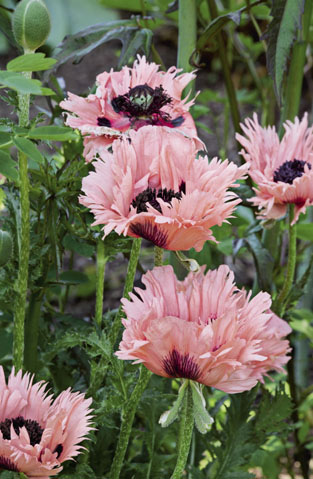
Papaver orientale ‘Pink Ruffles’
‘Royal Wedding’ bears 5- to 8-in.-wide, white flowers that sway majestically above 30- to 35-in. plants.
‘Salmon Glow’ displays salmon, many-petaled, almost double flowers. 30 in.
Liliaceae
St. Bruno’s lily, paradise lily
This European genus of just two species is relatively unknown in US gardens, but tubers and seed are sometimes available through bulb specialists and bulb societies. Closely related to St. Bernard’s lily (Anthericum), some taxonomists place it with asphodels in the Asphodelaceae, while others feel it belongs with asparagus in the Asparagaceae. Either way, St. Bruno’s lilies are graceful additions to collections of bulbous plants and are unusual additions to rock gardens and flowerbeds.
Plant tubers 2 in. deep. Chill or freeze moist seed prior to sowing; be patient, germination is slow.
Paradisea liliastrum
syn. Anthericum liliastrum
• white
• late spring to early summer
• 1–2 ft. × 1 ft.
• sun, part shade
• Z5–8
St. Bruno’s lily, paradise lily. Native to alpine meadows and grasslands of the European Alps and the Pyrenees. Regrettably seldom offered for sale, St. Bruno’s lily is well worth seeking. Growing from short tubers, 1-in.-wide, linear basal leaves grow to 2 ft. or so long, making handsome clumps. Graceful, one-sided, loose terminal racemes of 15 or more delicate white flowers rise on erect scapes above the foliage. Sweetly fragrant blooms are funnel shaped with six free tepals (petal-like), 1–2 in. in length, highlighted with a green spot at their tips. Easy to grow in average fertile soil amended with compost, perhaps among shrubs or in flower borders. Maintain moist soil in sunny spots. Divide the tubers in fall or start from seed. Portugese Paradisea lusitanica may reach 4–5 ft., with flowers on both sides of the stem.
Melianthiaceae
Paris
Unusual and fascinating, Paris is closely allied with trilliums and usually needs similar growing conditions. Different, though similar, species are becoming more available as they become better known. Both genera have been moved from the Liliaceae to the Melianthiaceae, but may be found in the literature under either.
Grown for their unique and curious flowers, these appear like spiders’ legs or cat whiskers, yellow and radiating from the center above a whorl of leaflets. Each may last for up to three months, and if pollinated produces poisonous, blue-black or red berries. The handsome dark green leaves, arranged symmetrically in whorls, are ovate and pointed, with netted venation.
Select or order container-grown plants, rather than dried rhizomes that are sometimes offered and seldom revive. Best in woodland conditions, with moisture-retaining, humus-rich soil. These elegant plants are most suitable in light or dappled woodlands or wild gardens, massed perhaps with related trilliums, Solomon’s seals, and ferns. Paris quadrifolia demands sweet alkaline soil, as is found in their native habitat.
Propagate from seed as soon as it ripens in fall. Divide rhizomes in fall.
Paris polyphylla
• yellow green
• summer
• 1–2.5 ft. × 1.5 ft.
• part shade, shade
• Z5–8
Multi-leaf Paris. Chinese Himalayas. Erect and smooth, unbranched stems rise with a topknot of leaflets arranged in a whorl. Short flower stalks rise above, bearing solitary flowers with a leafy collar of four to six lanceolate sepals and eight thread-like petals. Yellow stamens surround a central, knoblike, maroon stigma. Red berries follow in fall. Shorter Japanese Paris tetraphylla is similar, but leaves and flower parts are in multiples of four.
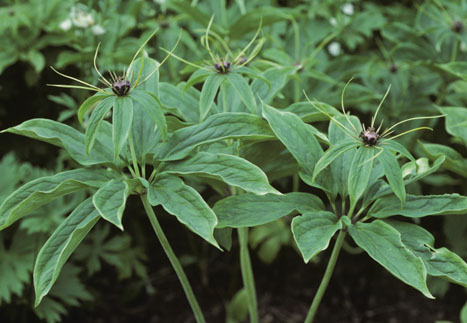
Paris polyphylla
Valerianiaceae
patrinia
This genus is a close cousin of garden heliotrope or common valerian. Most patrinias are indigenous to grassy mountain habitats of eastern Asia and Japan where they thrive in cool, humus-rich soil. Several species are considered important in homeopathic medicine and have long been used for various ailments. The roots are especially valued for their antibacterial and anticoagulant properties.
Patrinias make low mounds or clumps of leaves with wide sprays of attractive small flowers above. Inflorescences rise on wiry stems, very long-lasting bloom. Best in humus-rich soil; avoid overly fertilized sites that produce too much leafy growth at the expense of flowers. Drainage must be adequate; the roots rot out with wet feet in winter. Flower sprays are attractive cut, fresh or dried. Allow the spent stems to remain in the garden for winter interest. Little maintenance is necessary; easy to grow.
Butterflies and insects flock to the flowers for their nectar, but deer and rabbits seem to ignore the plants; slugs and snails may be a problem. Regrettably, it has been reported that patrinias are alternate hosts for fungal daylily rust; remove and destroy infected plants immediately.
Patrinias mix well in beds and borders with other perennials, annuals, and shrubs, and in cottage gardens. Ideal on the edge of woodlands; low species make fine groundcovers.
Increase by seed sown in containers in fall, or divide clumps in spring.
Patrinia gibbosa
• yellow
• late spring to midsummer
• 12–24 in. × 12 in.
• sun, part shade
• Z5–8, HT
Dwarf patrinia. Japan. Long blooming, with minute, acid-yellow, five-lobed flowers arranged in loose eye-catching sprays, 3–4 in. across, above the foliage mass. Broadly ovate, divided, 5- to 6-in. leaves are rimmed with jagged teeth. Deadhead to prevent self-seeding. Appropriate in cottage gardens and mixed borders.
Patrinia scabiosifolia
• yellow
• midsummer to fall
• 4–5 ft. × 2 ft.
• sun
• Z4–9, HT
Golden lace, golden valerian, camel’s cover. Korea. Basal rosettes of foliage, similar to those of pincushion flower, to about 2 ft. Erect, slender, and branching stems, meagerly furnished with ovate, fern-like, divided leaves, rise way above and terminate in numerous umbel-like sprays of very small, fragrant (some say odorous) flowers. Well-drained, average soil is fine; nutrient-rich soil promotes lush, floppy growth. Tolerates dry soil, but irrigation during droughts may extend bloom time. Attracts assorted bees and other pollinating insects. The young leaves and stem tips have been used as a pot herb.
‘Nagoya’. Clumps of deeply divided leaves are compact, mostly less than 15 in. Flower stems with pinnately divided, toothed leaves, rise to 2–3 ft.
Patrinia triloba
syn. P. palmata
• yellow
• mid- to late summer
• 8–24 in. × 6–12 in.
• sun, part shade, shade
• Z5–8
Patrinia. Grassy hills of Japan. Lobed like a hand, the fresh green leaves are irregularly cut, toothed, and 2–4 in. across, and grow into spreading mats. Panicles up to 4 in. wide, of cup-shaped, five-lobed flowers each only 0.25 in. across, perch atop wiry, branching, reddish brown stems. Not every nose finds the flowers fragrant. Prefers cool moist soils.
var. palmata has spurred flowers. Leaves take on reddish tones in fall.
Patrinia villosa
• white
• summer to fall
• 2–3 ft. × 1 ft.
• sun, part shade
• Z6–11, HS
White patrinia. Japan, eastern Asia. Clumping mounds of foliage arise from stoloniferous roots. Toothed, ovate leaves, simple or divided, up to 6 in. long. Loose clusters of small, white flowers are borne on erect stems. A good “see-through” plant, reminiscent of a white, tall verbena (Verbena bonariensis). Good for cutting, fresh and dry; persistent seedheads. Good in cottage gardens and borders; naturalizes in rich soil.
Saxifragaceae
This genus is composed of just two very similar species. They hail from Asia and have large, handsome, palmately lobed leaves. Partly shaded sites are preferable, where soil is woodsy, humus-rich, and remains damp for most of the season. Although not widely offered in the marketplace, they are cousins to better-known saxifrages, astilbes, and coral bells.
Peltoboykinias are perfect as bold features in lightly shaded woodlands, perhaps as a textural counterpoint to large ferns. The compound leaves are shield-like (“pelte” is from the Greek for “a shield”) and eye-catching wherever they are grown. Reddish bronze at first, they mature to green as the season progresses. Considered resistant to deer browsing. Easy.
Propagate by seed or division.
Peltoboykinia tellimoides
syn. Boykinia tellimoides
• yellow green
• early summer
• 20–36 in. × 24 in.
• part shade
• Z6–9
Yawato-so. Native to high woodlands of eastern Asia. Fairly aggressive, short, creeping rhizomes give rise to mostly basal, umbrella-like leaves on 1- to 2-ft.-long petioles. The leaves are peltate (attached to the stem at the middle), rounded to heart-shaped, with 7–13 shallow, toothed lobes. Best in cool-summer regions. Although grown primarily for its foliage, the small, creamy yellow–green flowers, bell shaped and borne in clusters, are quite interesting. Japanese Peltoboykinia watanabei is similar with very deeply cleft, longer-lobed leaves, and small, yellow flowers.
Plantaginaceae
beardtongue
A treasure trove for gardeners who favor North American natives, the genus Penstemon includes over 300 species, only one of which originated outside this continent. Ranging from coast to coast, and from the Arctic tundra to the mountains of Guatemala, penstemons have achieved their greatest diversity and splendor in the western United States. Yet we owe the domestication and hybridization of these plants to the late 19th-and 20th-century European plant breeders. The recent quest for water-conserving gardens, however, has brought increased attention to drought-tolerant Western penstemons; many are available now, especially from regionally focused nurseries.
Not surprisingly, such a large group of plants offers great variety. Penstemons range in height from 1–2 in. to 7-ft. giants. Leaves are alternate; funnel-shaped or tubular flowers are borne typically in spikes. Flower color ranges from white, to blue, violet, purple, pink, magenta, red, and occasionally yellow. Individual blooms are two lipped like a gaping mouth, from which protrudes a long, frequently hairy staminode—the source of the common name, beardtongue. Attracts a variety of pollinators including butterflies and hummingbirds; deer resistant.
Most penstemons are “pioneer” plants, adapted to colonizing disturbed soils. They tolerate and favor nutrient-poor, very well-drained, even gritty soils; consistently moist conditions with poor drainage commonly cause root rot. Mulch with gravel or leave soil bare; avoid moisture-retaining, organic mulch, such as ground bark. Seldom browsed by deer or rabbits. Some species of penstemons are somewhat demanding outside their native habitats; those listed below are among the easiest to grow.
Propagate by seed, division, stem cuttings, or layer species with prostrate stems.
Penstemon barbatus
• orange-red
• late spring to early summer
• 1.5–3 ft. × 1–2 ft.
• sun
• Z4–9
Beardtongue. Rocky slopes and open woodlands from Utah to Arizona, east into Colorado. Clump forming with evergreen, oblong to ovate basal foliage, and clasping, willow-like stem leaves, 2–6 in. long. Terminal racemes of tubular, 2-in., orange-red flowers; deadhead to extend flowering. Tolerate shallow, rocky soils. Good for sunny, dry borders and rock gardens, naturalized in cottage gardens and meadows, open woods.
‘Jingle Bells’ (var. coccineus ‘Jingle Bells’) has scarlet flowers. Grow from seed.
‘Rubycunda’ has slightly fragrant, scarlet flowers with contrasting white throats.
Penstemon cardinalis
• red
• midsummer
• 24–30 in. × 24 in.
• sun
• Z5–9
Cardinal beardtongue. Southern New Mexico, west Texas. Rosettes of large, evergreen, deep green leaves; ruby-red, tubular flowers dangle from upright stems. Withstands intense sun, but tolerates very light shade. Exceptionally drought tolerant once established; will succeed in very well-drained soil in moister climates. Best for rock gardens or dry borders; a premier hummingbird plant.
Penstemon davidsonii
• blue, purple
• midsummer
• 2–5 in. × 12 in.
• sun, part shade
• Z6–8
Davidson’s penstemon. Mountains of West Coast from California through British Columbia. Dense mats of creeping, woody stems with small, leathery, evergreen, oval leaves. Broad, tubular flowers, 0.75–1.5 in. long and blue-lavender to purple, rise on very short stems. Sensitive to summer drought; best where snow cover is reliable, or protect with evergreen boughs in winter (extends hardiness through zone 5). Unusual, handsome groundcover for rock gardens, sunny, sandy, or gravelly banks, or dry borders.
var. menziesii ‘Microphyllus’ is compact (2 in. × 10–12 in.) and hardier with small, more finely textured, evergreen leaves that turn burgundy color in winter. Z4.
Penstemon digitalis
• white
• midspring to early summer
• 3–5 ft. × 1.5–2 ft.
• sun
• Z3–8
Beardtongue. Native to prairies, fields, woodland edges in eastern and southeastern United States. Recommended as easy and reliable for gardens from the Midwest to the Atlantic coast and Pacific Northwest by the American Penstemon Society. Clump forming with elliptical basal leaves, becoming lanceolate to oblong higher up the stems. Panicles of white, tubular, 1- to 1.25-in. flowers. Provide average, dry to moderately moist, well-drained soil; resents wet, poorly drained ones. Striking massed in sunny borders, wild gardens, prairie plantings, or well-drained rain gardens. Generally trouble free if drainage is adequate.
‘Husker Red’ has non-fading, deep burgundy foliage, and white or blush-pink flowers. Compact at 2–3 ft. × 1–2 ft.
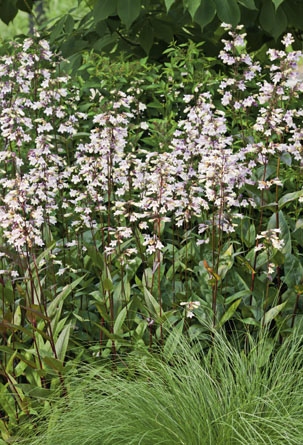
Penstemon digitalis ‘Husker Red’
‘Mystica’ foliage emerges green, becoming dark maroon-red during the summer, and blazing red in the fall. Clusters of lavender-pink flowers. 30 in. × 20 in.
• blue
• late spring to early summer
• 12–18 in. × 12–18 in.
• sun
• Z6–10
Foothill penstemon. Grasslands, chaparral, and open woodlands of California’s mountain foothills. Clump forming, with narrow, lanceolate to linear stem leaves, 2–4 in. long, and 1.5-in. tubular, gentian-blue flowers in terminal racemes on erect, spreading stems. Remove spent flowering racemes to prolong bloom time. Sunny, dry borders, rock gardens, and dry, rocky banks and slopes.
‘Electric Blue’ has flowers of more intense, uniform blue than the species.
Penstemon pinifolius
• red
• late spring to early summer
• 10–12 in. × 12–18 in.
• sun
• Z4–9
Pineleaf beardtongue. Arizona, New Mexico, northern Mexico. Forms low, bushy mound of needle-like foliage, evergreen where winters are mild. Constricted, tubular, orange-red flowers with fringed mouths borne over two-month season. Cut back hard as growth resumes in early spring to remove old woody growth. Glorious in rock gardens, walls, or troughs; very drought tolerant, a natural for xeriscapes.
‘Magdalena Sunshine’ has yellow flowers. Z5–9.
Other Notable Cultivars
Hybrids commonly offer a greatly prolonged season of bloom and a wider color range; superior in the border.
‘Blackbird’ bears raspberry-purple flowers; deep green leaves. 18–24 in. × 12–18 in.
‘Blue Midnight’ has large, deep blue-purple flowers with white, burgundy-streaked throats. 30 in. × 36 in. Z6–9.
‘Dark Towers’ has abundant pale pink flowers, above non-fading, deep burgundy foliage. 18–36 in. Z3–8.
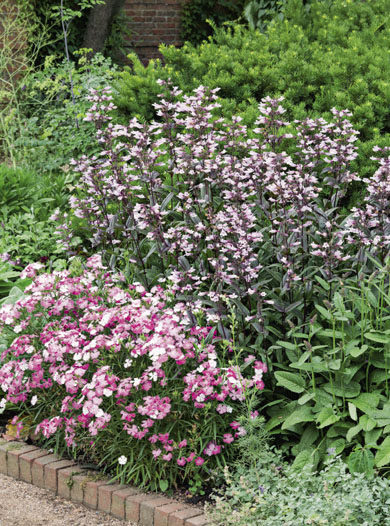
Penstemon ‘Dark Towers’ with Dianthus barbatus
‘Elfin Pink’. Broad mats of glossy foliage; 12- to 18-in. spikes of salmon-pink flowers. Sun, partial shade. Z4–9.
‘Prairie Dusk’. Tubular, rose-purple flowers on 20-in. stems. Deadhead for long bloom.
‘Red Riding Hood’ bears vivid, coral-red flowers from late spring through summer. 24–30 in. × 18–24 in. Z5–8.
Lamiaceae
Russian sage
One species of this genus has made its way into gardens, but this singularity has made a big impact. A premier textural plant, Russian sage’s finely cut, silvery foliage glistens in the summer sun, and combined with its long-blooming clouds of tiny, blue flowers introduces an impression of lightness to the heaviest garden border. A cooling contrast to dazzling summer annuals, this plant is also remarkably tough and carefree.
Russian sage thrives on well-drained, poor soils; once established it shrugs off all except the most prolonged summer droughts. To promote compact growth, prune stems back hard into woody bases, but only after 1 in. or so of new spring growth has emerged; left uncut this plant sprawls untidily; too much fertilizer and irrigation encourages soft growth and sprawl. Like many aromatic plants, Russian sage resists deer and rabbits as well as most insect pests.
Propagate by softwood or semi-hardwood cuttings. Low-growing stems may layer themselves.
Perovskia atriplicifolia
• blue
• midsummer to midfall
• 3–5 ft. × 2–4 ft.
• sun
• Z5–9
Russian sage. Himalayas, western China. A subshrub commonly grown as an herbaceous perennial. Aromatic, deeply divided, silver-green leaves with toothed edges clothe stiffly upright, square, silver stems, woody at the bases. Light blue, tubular flowers are two lipped, borne in tiers of whorls in branched, terminal panicles 12–15 in. long.
‘Blue Spire’ has larger flowerheads than the species. 4 ft. tall.
‘Filigran’ is sturdier and more upright; especially fine, lacy foliage.
‘Little Spire’ is compact, 2–3 ft. tall.
‘Longin’ is similar to ‘Little Spire’ but more upright with larger, less-dissected leaves. 3–4 ft.
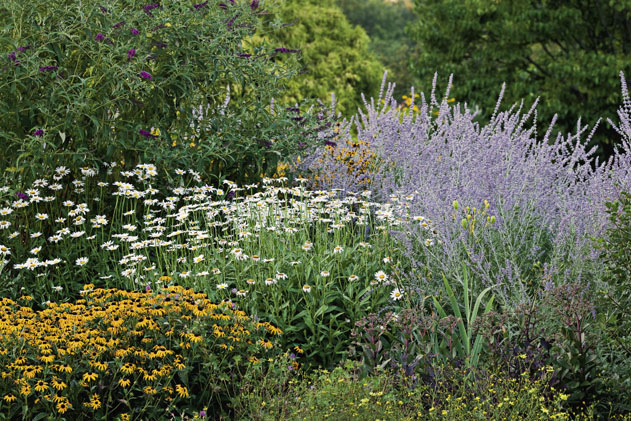
Hazy blue Perovskia atriplicifolia shines with Shasta daisies and Rudbeckia in this fall garden
Polygonaceae
smartweed, knotweed
Because this genus includes notable invasives such as mile-a-minute weed (Persicaria perfoliata) many gardeners avoid persicarias altogether. Yet among the 50–80 species, a number have considerable ornamental value, and are controllable. Smartweeds usually have fleshy stems, jointed at swollen nodes, and clothed with simple, alternate, conspicuously veined leaves; the leaf bases sheath the stems. Small, long-lasting flowers collect in spikes or panicles, followed by reddish brown fruits.
Plant smartweeds in moist soil in sun or part shade. Take precautions against hungry slugs and snails. Deer and rabbits are seldom troublesome.
Divide in spring or fall, or sow seed in containers.
Persicaria affinis
syn. Polygonum affine, Bistorta affinis
• rose
• summer to fall
• 6–10 in. × 12–24 in.
• sun, part shade
• Z3–7
Himalayan fleece flower, Himalayan knotweed. Afghanistan to Nepal, Tibet, India. Creeping stems make wide evergreen mats of dark, 2- to 6-in., elliptic to lanceolate leaves that may display bronzy fall color. Dense, 2- to 3-in. spikes of rose-pink, 0.25-in. flowers lighten as they mature. Drought tolerant.
‘Border Jewel’ (‘Himalayan Border Jewel’). Light pink flowers on red stems, in 2-in.-long spikes; excellent red fall color. 4 in. × 12 in. Z3–8.
‘Donald Lowndes’ has double, pale to dark pink flowers. 8–10 in. Z5–8.
‘Superba’ (‘Dimity’). Upright, dense, 4-in. pokers of rosy red flowers that mature pink. 12 in. Z3–9.
Persicaria amplexicaulis
syn. Polygonum amplexicaule, Bistorta amplexcaulis
• red
• summer to fall
• 4–6 ft. × 3 ft.
• sun
• Z4–7
Bistort, mountain fleece. Himalayas. Vigorous but not invasive, this clumping species has clasping, slightly puckered, pointed, lance-shaped leaves to 10 in. long. The leaves have conspicuous midribs; downy with hairs beneath. Slender, bell-shaped, red-to-purple or white flowers crowd into long-stemmed, slim, 4-in.-long spikes.
‘Alba’ has slender tapers of white flowers on erect stems. Beautiful foliage. 3.5 ft. × 3 ft. Z6.
‘Atrosangiunea’ produces bottlebrush spikes of rosy flowers, well above the leaves. 4 ft. Z6.
‘Firetail’ (‘Speciosa’). Erect, 5- to 6-in. pokers of bright red flowers. 3–4 ft. Z4–7.
‘Golden Arrow’. Tassel-like crimson flower spikes contrast with 10-in., yellow-green foliage. Vigorous. 2–3 ft. Z4–7.
‘Inverleith’ presents stubby crimson spikes and handsome narrow foliage. Best in part shade. Compact at 18 in. Z5.
Persicaria bistorta
syn. Polygonum bistortum
• pink
• late spring to midsummer
• 18–30 in. × 30 in.
• sun
• Z3–8
Snakeweed, bistort. Europe, Asia. Vigorous and clumping with mostly basal leaves, undulating at the margins with a white midrib, 4–12 in. long. Dense, 2- to 3-in.-long bottlebrushes of 0.25-in., pink bells rise well above the foliage. A good cut flower; valuable in damp garden sites. Foliage sometimes used as a green vegetable. Deadhead to avoid self-seeding.
‘Superba’ forms clumps of dark, puckered foliage, with dense, cattail-like spikes of pink flowers. 2 ft. high and wide. Z4.
Persicaria microcephala
• white
• summer to fall
• 1.5–2 ft. high and wide
• sun, part shade
• Z6–8
Bistort. China. Non-aggressive, with beautiful heart-shaped foliage and clusters of small, white flowers at the tips of arching stems. The species is seldom grown, outshone by garden-worthy cultivars. Best in cool-summer climates; high temperatures causes vibrant foliage color to fade. Moist soil for best results.
‘Red Dragon’ has dark wine-colored foliage marked with purple, silver, and green chevrons. Tiny, white flowers cluster at the tips. Clumping. 3–4 ft. Z5–9.
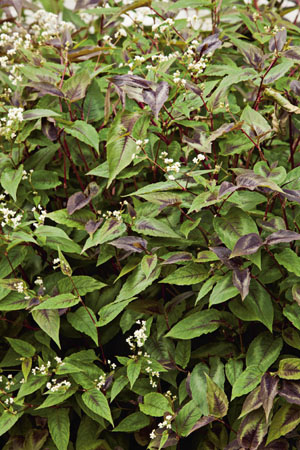
Persicaria microcephala ‘Red Dragon’
‘Silver Dragon’ has silvery leaves, centered and margined with red. Clusters of tiny, white flowers. 2 ft. × 3 ft. Z5–9.
Persicaria virginiana
syn. Polygonum virginiana, Tovara virginiana
• pink, red
• late summer
• 12–30 in. × 12 in.
• sun, part shade
• Z4–8
Tovara. Eastern and midwestern United States. Upright with short-petioled, oval, green, 3- to 10-in. leaves marked with dark green. Slender, whip-like spikes of greenish white or pink-tinged flowers that age to red, rise above the foliage. Invasive in good conditions; tolerates dry, root-ridden soil if kept watered until established.
‘Painter’s Palette’ has thin-textured leaves evenly splashed and striped with creamy yellow and accented with a reddish brown chevron. Invasive, but spectacular facing down hemlocks or other evergreens in controlled sites.
‘Variegeta’ has variegated ivory-and-cream foliage.
Asteraceae
butterbur
Native to temperate and subarctic regions of the Northern Hemisphere, these robust plants typically inhabit moist, shady sites. Their bold, outsized foliage is their chief attraction, used to add a flamboyant, even tropical-looking, air to gardens in cold climates. The thick, creeping rhizomes are energetic colonizers—butterburs should be handled with care, as they prove invasive in wetlands or along stream banks; in such settings confine the plants to containers or large, sunken tubs. No pest or disease problems apart from slugs; deer resistant.
Divide, or sow seed.
Petasites japonicus
• white, yellow
• early spring to midspring
• 2–3 ft. × 2–5 ft.
• shade, part shade
• Z5–9
Butterbur, sweet coltsfoot. Korea, China, Japan. Dense clumps of slightly toothed, kidney-shaped leaves 16–32 in. across, woolly beneath. Before the foliage emerges, large, dense, bouquet-like corymbs of fragrant, yellowish white, daisy-like flowers appear on 6-in. scapes, framed by large, pale green bracts; they are showy and intriguing rather than beautiful.
‘Giganteus’ (var. giganteus) is larger in all its parts. Leaves 48 in. across. 4–7 ft. Z6–8.
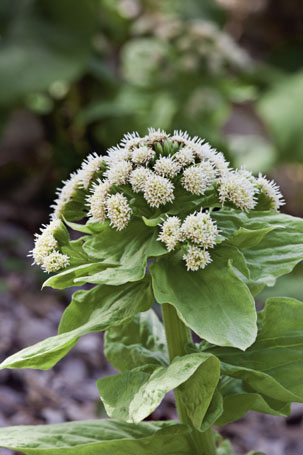
Bloom of Petasites japonicus var. giganteus
‘Variegatus’ has dark green leaves, splashed and streaked with yellow.
Lamiaceae
phlomis, Jerusalem sage
Phlomis is a genus of sage-like plants grown both for their attractive foliage and eye-catching flowers. Large leaves are corrugated, and covered with white or grayish woolly hairs. The typical mint family flowers are two lipped, the upper providing a protective hood over the three-lobed lower. Lavender-pink, yellow, or white flowers are arranged in dense, several-flowered verticillasters.
Drought-resistant phlomis prefers a sunny spot where soil is fertile and drains well. They are sensitive to extreme temperature fluctuations such as those often experienced in the eastern United States, particularly in the hot, humid Southeast; they do not enjoy muggy conditions. Cut to the ground before spring growth emerges. Easy care, but leafhoppers may be troublesome. Eminently suitable for wildlife gardens, where they attract birds, butterflies, and bees; resistant to both rabbits and deer. In beds and borders phlomis provides architectural impact and color over a long season.
Divide in spring, or take soft cuttings of young growth.
Phlomis cashmeriana
• lilac pink
• midsummer
• 2–4 ft. × 2 ft.
• sun, part shade
• Z5–9
Kashmir sage. Native to drier areas of Kashmir and the Western Himalayas, this species is impressive in dry gardens where humidity is low. Upright, stately plants clothed with pairs of soft, gray-woolly leaves. Basal leaves are 4–10 in. long, stem leaves smaller. Numerous bold verticillasters of 1-in., deep lavender-lilac flowers on the upper stems. Sculptural seedheads maintain winter interest. Good as cut flowers; dried stems are attractive in winter bouquets.
Phlomis fruticosa
• yellow
• early to midsummer
• 2–4 ft. × 3 ft.
• sun
• Z6–10
Jerusalem sage. Eastern Mediterranean. Widely grown in California, this underused plant should gain acceptance elsewhere. Bushy plants, often woody below, are covered with coarse, elliptical to lanceolate, 2- to 3-in., gray-green leaves, white-woolly with hairs beneath; hairy stems appear slightly yellow. Flower buds cluster in tight, tiered whorls in the upper leaf axils and open to hooded, butter-yellow, 1- to 1.25-in. blooms. In cool climates Jerusalem sage is dormant in winter, but erupts from the base in spring. Attractive in borders with ‘Big Blue’ sea holly, lavender, or salvias.
Phlomis russeliana
syn. P. viscosa hort.
• yellow
• late spring to early fall
• 3–4 ft. × 2.5 ft.
• sun
• Z3–9
Jerusalem sage, sticky Jerusalem sage. Syria, Turkey. Evergreen, with sage-green foliage, softly fuzzy beneath. Ovate basal leaves, heart-shaped at the base, may reach 6–8 in. long. Smaller upper-stem leaves have scalloped or undulating rims. Ball-like clusters of pale yellow, hooded, 1- to 1.5-in. flowers arranged up the stem, topiary like.
Phlomis tuberosa
• pink
• early to late summer
• 2–5 ft. × 3 ft.
• sun, part shade
• Z5–8
Tuberous Jerusalem sage. Central and southeastern Europe to central Asia. Bushy, with vigorous, upright stems arising from tuberous roots. Arrow-shaped, crumpled, 8- to 10-in. leaves are variably hairy, coarsely toothed along the margin, and decrease in size as they ascend deep purple stems. Deep purple calyces contrast well with pink, 1-in. flowers.
‘Amazone’ (Sage-leaf Mullein) has rosy-mauve flowers on burgundy stems. Mostly evergreen; toothed leaves, grayish with downy hairs. 4–5 ft. Z5.

Phlomis tuberosa ‘Amazone’
Polemoniaceae
phlox
“Essential” means indispensable, but it also indicates that anything labeled this way is of the essence—as a perennial for American gardens, phloxes qualify in both respects. The genus is almost entirely native to this continent, from the edge of the Alaskan tundra to the Gulf Coast of Florida.
Phlox leaves, typically entire and generally lanceolate or linear, are borne in opposing pairs; tubular, often fragrant flowers flare into five lobes at their mouths. Individual flowers, though modest in size, are abundant, grouped in large panicles or solitary in blankets that almost hide the foliage. The color palette is inclusive, lacking only yellow, unmixed oranges, and true blues to complete the spectrum.
Phlox fanciers can enjoy bloom from midspring through early fall by growing different species; summer phlox (Phlox paniculata) have a particularly generous bloom time that may extend over two months with assiduous deadheading. Creeping phloxes serve as groundcovers in rock gardens and on sunny banks, compact species decorate the front, and tall phloxes shine as border backdrops; several contribute to cottage and cutting gardens. The species are appropriate in native, wild, and meadow gardens, and sometimes in open woodland gardens. Many excellent cultivars and hybrids are offered in nurseries, with more arriving annually.
The cultural requirements of phloxes vary between species, but most prefer sunny or lightly shaded sites, with six hours or so of direct sunlight daily (P. divaricata, described below, is the exception). Creeping and mat-forming types prefer leaner, very well-drained, even gritty soils; upright border and meadow phloxes require moderately moist, fertile, humus-rich soils. Few species thrive in high heat and humidity; timely irrigation is usually critical for good flowering.
Carefully select the phlox species suited to your climate, soil, and conditions. Fungal root rot may be a problem, but some species are resistant. In hot, dry conditions spider mites are serious; susceptibility to powdery mildew varies and it is wise to select resistant species and cultivars. Thinning to increase air circulation is also helpful. Butterflies and hummingbirds flock to phlox; deer and rabbits devour them.
Other reliable and attractive species include P. bifida, P. nivalis, P. adsurgens, P. pilosa, P. ×procumbens, and numerous hybrids that are well worth seeking out.
Divide cultivars in spring or early fall, or take stem cuttings in early midsummer. Start species from seed.
• white, pink, purple
• early to midsummer
• 24–30 in. × 18–24 in.
• sun, part shade
• Z3–8
Carolina phlox, summer phlox, thickleaf phlox. Native to woodland edges and openings from North Carolina to southern Illinois, and south to the Gulf of Mexico. Groups of slender, erect, red-streaked stems with leathery, oval leaves. Loose, dome-shaped clusters of fragrant, lavender to pink flowers. Prefers moisture-retentive but well-drained soil. Powdery mildew resistant.
‘Gypsy Love’ (syn. Phlox carolina var. angusta ‘Gypsy Love’) has fragrant, bright pink flowers from late spring. Lustrous foliage. 24 in. × 18 in.
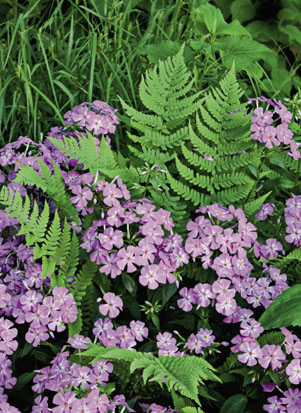
Phlox carolina ‘Gypsy Love’
‘Miss Lingard’, often listed as a P. carolina cultivar, is probably a hybrid with P. maculata. Showy clusters of fragrant, white flowers in early summer with intermittent rebloom. Outstanding resistance to powdery mildew. 2–3 ft. × 2–3 ft.
‘Kim’ has bright pink flowers in summer to autumn. 12–18 in. × 12–24 in.
Phlox divaricata
• blue
• mid- to late spring
• 9–12 in. high and wide
• part shade, shade
• Z3–8
Woodland phlox, wild sweet William. Native to rich woods, fields, and streamsides throughout central United States northward into Quebec. Spreading mounds of sticky, hairy stems clad with 1- to 2-in., lanceolate to elliptic leaves. Sprawling stems root at the nodes to establish spreading colonies. Fragrant, 1.5-in., blue, lilac, or pink flowers in loose clusters at stem tips. Provide humus-rich, moderately moist, well-drained soil; mulch in summer. Susceptible to powdery mildew—cut back stems after flowering to force clean, healthy new growth; watch for spider mites and rabbits; mostly deer tolerant. Shallow-rooted, woodland phlox makes a good cover for early spring bulbs. Lovely in native and woodland gardens, rock gardens, and shady borders where foamy bells, hostas, and lungworts are appropriate companions.
‘Chattahoochee’ has fragrant, maroon-eyed, bluish lavender flowers. Probably a hybrid. Rabbit and deer resistant.
‘Eco Texas Purple’ has violet-purple flowers with reddish centers.
‘Fuller’s White’ is white flowered.
‘London Grove’ has powder-blue flowers.
‘Montrose Tricolor’ has silvery-mauve flowers; foliage striped and edged white and pink.

Phlox divaricata
Phlox glaberrima
• pink, purple, white
• midspring to late spring
• 2–4 ft. × 2–2.5 ft.
• sun, part shade
• Z3–8
Smooth phlox. Wet woods, meadows, and prairies throughout southeastern United States. Similar looking to Phlox paniculata but spring blooming and very resistant to powdery mildew. Upright stems bear thin, 5-in., lanceolate leaves. Fragrant, tubular, and five-lobed flowers, to 1 in. across, congregate in large, pyramidal clusters at stem tips. Tolerates moister soils than other species. Seldom needs staking, deadhead to prolong bloom; mulch in summer. Watch for spider mites, especially in hot, dry weather. Deer tolerant. A gem for spring borders, meadow plantings, and cutting gardens.
‘Morris Berd’. White-eyed, rose-pink flowers. Long blooming. 18–24 in.
‘Triple Play’. Creamy white–edged leaves; pink-lavender flowers. 1 ft. × 2 ft.
Phlox maculata
• pinkish purple
• early summer to late summer
• 2–3 ft. × 1–2 ft.
• sun, part shade
• Z3–8
Meadow phlox, wild sweet William. Moist meadows, low-lying woods and riverbanks throughout eastern United States. Rhizomatous clumps of upright, red-spotted stems with dark, thin, finely toothed, lanceolate leaves to 5 in. Sweetly scented, tubular five-lobed flowers to 0.5 in. across, carried in 10- to 12-in.-long, cylindrical panicles at stem tips. Thrives in average, moderately moist, well-drained soils in airy, open positions. Intolerant of drought; apply a summertime mulch. Resists powdery mildew; spider mites attack especially in hot, dry conditions. Seldom needs staking; deadhead to prolong bloom. Spreading rhizomes and self-seeding may result in large colonies. Good for summer borders, cottage and meadow gardens, and cut flowers.
‘Natascha’ has bicolored pink-and-white, very fragrant flowers. Compact. 2 ft.
‘Omega’ is white, accented with a pale pink eye.
Phlox paniculata
• various
• midsummer to early fall
• 3–6 ft. × 1–3 ft.
• sun, part shade
• Z4–8
Summer phlox, border phlox. Open woods, meadows, and moist roadsides from central New York to Missouri and Kansas, south to North Carolina, Tennessee and Louisiana; naturalized in other regions as garden escapees. Somewhat demanding, but glorious when its needs are met. Clumps of stiff stems, unbranched below, clothed with 1-in.-wide, ovate to ovate-oblong leaves to 6 in. long; rounded, 4- to 6-in. panicles of fragrant, tubular, five-lobed flowers. Self-seeds, producing mostly magenta flowers; cultivars bloom in shades of white, coral, pink, red, lavender, and violet; often bicolored with contrasting eyes.
Provide good air circulation, and protect from intense midday sun to avoid foliage yellowing. Maintain soil moisture with summer mulch; few cultivars embrace heat and humidity. Stake taller types early, at 6–8 in., to prevent flopping; extend bloom time with routine deadheading. Powdery mildew is the curse of summer phlox; seek resistant selections.
There are hundreds of cultivars; the following are resistant to powdery mildew and mites, and have notably fragrant flowers:
‘Delta Snow’ has 1-in.-wide, purple-eyed, white flowers. Exceptional heat tolerance; good for areas with high humidity. 2–4 ft. × 2–3 ft.
‘Nora Leigh’ has light green foliage irregularly margined with cream. Dark pink–eyed, white flowers. 30 in.
‘Orange Perfection’ has 1-in., salmon-orange flowers with magenta eyes. 36 in. × 20 in.
‘Peppermint Twist’ has flowers like 1.25-in.-wide pinwheels of pink and white. Very compact. 16 in. × 12–15 in.
‘Robert Poore’ has deep magenta flowers on 3- to 5-ft. stems.
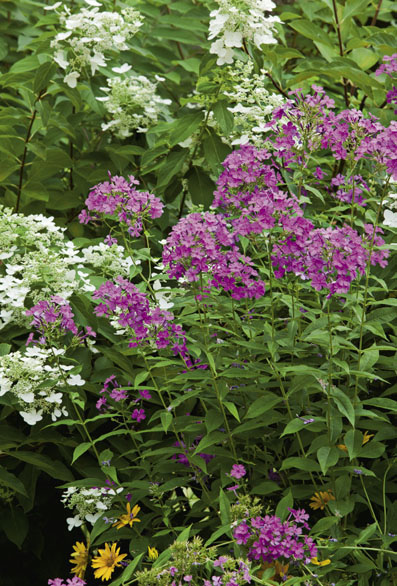
Phlox paniculata ‘Robert Poore’
‘Shortwood’ ranked most resistant to powdery mildew at Chicago Botanic Garden trials. Hot-pink flowers with darker pink eyes. 42–48 in. × 24–30 in.
Phlox stolonifera
• lavender, white
• late spring to early summer
• 6–12 in. × 9–18 in.
• sun, part shade
• Z5–9
Creeping phlox. Woodlands and stream banks of southern Appalachians. Creeping stems form 3-in.-high mats of oblong to oval, 3-in.-long leaves. Fragrant, 0.75-in. flowers are commonly lavender but sometimes white, borne in loose clusters. Tolerates light shade, deer, and some drought; vulnerable to rabbits and powdery mildew. Good groundcover for native, shade, and woodland gardens, border fronts and rock gardens, a good “cover-up” for fading spring bulbs.
‘Blue Ridge’ has violet-blue flowers.
‘Bruce’s White’ is vigorous with fragrant, white flowers.
‘Home Fires’ has dark pink flowers.
‘Sherwood Purple’ has medium purple flowers.
Phlox subulata
• pink, purple, white
• early to midspring
• 3–6 in. × 1–2 ft.
• sun
• Z3–9
Moss phlox. Native to dryish, rocky soils in open woodlands and slopes from Michigan, Ontario, and New York, south to Tennessee and North Carolina. Spreading carpets of semi-evergreen, 1-in., needle-like leaves are blanketed with loose cymes of fragrant, 0.5- to 0.75-in. flowers by midspring. Provide humus-rich soil in full sun in cold climates, and dappled midday shade where sun is intense. Prone to spider mites, but powdery mildew resistant; shear after flowering to stimulate modest rebloom. Deer resistant, beware of rabbits. Showy in rock gardens and for edging, good groundcover for sandy, sunny south- or west-facing banks. Cultivars include:
‘Allegheny Smoke’ has pale, grayish blue flowers.
‘Dirigo Arbutus’ has lavender flowers with darker eyes.
‘Red Wings’ has rose-red flowers with darker red eyes.
‘Snowflake’ is compact with white flowers.
Other Notable Cultivars
×arendsii (Phlox divaricata × P. paniculata) is a large group of hybrids from the Arends Nursery. At their best they combine the compact habit of woodland phloxes, and the large flowerheads of summer phloxes; early to mid summer bloom. Outst anding examples with mildew resistance include: ‘Ping Pong’, with large clusters of mildly fragrant, red-eyed light pink flowers. 1.5–2 ft. × 1–1.5 ft. Z3–8. ‘Sabine’ has soft, bluish pink, fragrant flowers. 20 in. Z4–8.
Spring Pearl Series bears domed flower clusters, often but not uniformly fragrant, in white, pink, fuchsia, magenta, and bicolors; all cultivars have feminine names, e.g., ‘Miss Jill,’ ‘Miss Karen,’ ‘Miss Margie,’ and ‘Miss Mary’. Compact at 16–24 in. × 14–18 in. Z4–8.
Xanthorrhoeaceae
New Zealand flax
With their long and broad, colorful, sword-shaped leaves, borne in fountain-like clumps, New Zealand flaxes are popularly described as “ornamental grass on steroids.” These reach head high or even more, and do have the look of a Pennisetum or a Miscanthus, albeit bigger, bolder, and more assertive. Species phormium leaves tend to a darkish green, sometimes with colored edges and central ribs; cultivars range in color from light green through pink to deep russet-bronze. Variegated selections have leaves striped in contrasting shades of green, red, bronze, pink, and yellow. Branching clusters of bright red or yellow, curving, tubular flowers top stalks that can double the height of the foliage; rich in nectar, they are a magnet for hummingbirds and other pollinators. Unfortunately, flowering is uncommon in specimens cultivated in cooler regions.
Long a fixture in Californian gardens, a host of new cultivars and hybrids of New Zealand flaxes have, in the last few decades, begun to appear in nurseries and ornamental landscapes across the country. Although long lived, these plants are cold sensitive; cultivate them in containers north of zone 8 and overwinter indoors. Display these on terraces or plunged in beds over the summer.
In cooler climates, give phormiums a spot with full sun; elsewhere, avoid intense sun and provide partial shade to prevent bleaching of the foliage. Moist, well-drained soil is ideal; wintertime wet will surely prove fatal in zone 7. In the South, phormiums embrace wetness and are good plantings for streamsides and pond edges; moderately drought tolerant once established. Successful in coastal gardens. Generally trouble free, but susceptible to mealybugs and leaf spot. Deer resistant.
Eye-catching phormiums are effective as focal points in borders or beds, where they contrast well with the lower-growing, delicate-textured foliages of hardy geraniums and coreopsis. The strong, simple form of phormiums makes them dramatic architectural elements for urns and other containers.
Propagate by division or by seed.
Phormium colensoi
syn. P. cookianum
• yellow, orange
• early to late summer
• 4–7 ft. × 10 ft.
• sun, part shade
• Z8–11
Mountain lily. New Zealand. Highly variable species with many heights and foliage colors. Broad, sword-shaped leaves to 7 ft. long. Orange or yellow flowers borne on 6- to 7-ft. scapes with twisted, pendulous seed capsules, to 8 in. long. Species uncommon in commerce, but represented in nurseries by many cultivars, including:
‘Blondie’, a weeping form with narrow, slightly twisting, creamy-yellow leaves edged with green. Protect from intense sun. 2–3 ft. × 3–4 ft.
‘Cream Delight’ has red-rimmed, green leaves, with a creamy-yellow mid-stripe. 2–3 ft. × 4–6 ft.
‘Tricolor’ displays 2.5-in.-wide, arching leaves with a broad, green, central band flanked by yellow stripes and red margins. 4 ft. × 6 ft.
Phormium tenax
• red
• summer
• 10–15 ft. × 3–6 ft.
• sun, part shade
• Z9–11
New Zealand flax. New Zealand, Norfolk Island. Upright clumps of rigid leaves to 10 ft. long; brilliant red flowers on scapes to 15 ft. Numerous cultivars include:
‘Atropurpureum Compactum’, burgundy-bronze leaves, red flowers. 5 ft. × 3 ft.
‘Tiny Tiger’ (‘Aurea Nana’) has gray-green leaves edged in creamy white; yellow flowers. 2 ft. × 3 ft.
‘Limelight’ has bright lime-green leaves; abundant bronzy flowers. 5 ft. × 6 ft.
Other Notable Cultivars
The following are of more manageable size for most residential gardens. Z8–11.
‘Apricot Queen’ has apricot-colored young foliage that matures to pale yellow, margined with green; red flowers. 3–4 ft. × 3–5 ft.
‘Black Adder’ has dark, almost black foliage. More vigorous than ‘Platt’s Black’. 3–4 ft. × 3 ft.
‘Pink Stripe’ has grayish bronze leaves edged with pink. 3 ft. × 4–6 ft.
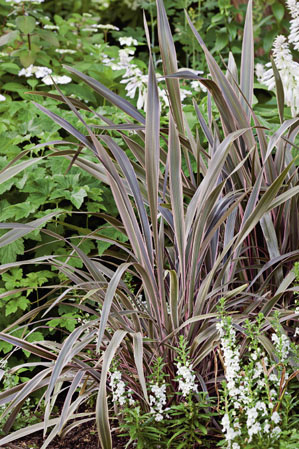
Phormium ‘Pink Stripe’
‘Rainbow Maiden’ has salmon-pink to coral-red leaves flanked by narrow, bronze-green margins; red flowers. 2–3 ft. high and wide.
Scrophulariaceae
Cape fuchsia
Despite the common name, these plants are not actually fuchsias but, rather, relatives of foxgloves and snapdragons. Both species in the genus are fast growing, suckering perennials with shrubby bases that originated in southern Africa, where they inhabit wet slopes and streamsides. Breeders have created a number of hybrids.
Cape fuchsias have nodding, tubular flowers, flared at the mouth into five short lobes; borne in long, terminal panicles, the individual blossoms hang down like Christmas tree ornaments. The opposite (alternate above), dark green leaves are lance shaped to oval, evergreen in mild climates, and carried on slender stems. Flowers appear in flushes over a long season, and attract butterflies and other insects as well as hummingbirds.
Provide average, well-drained but moisture-retentive soil for Cape fuchsias. Amend it with organic matter at planting time. Most do best in sun, except where it is overly intense, where a little shade is advisable. Be alert for weevils. Resists deer and rabbits.
Suitable for shrub borders, in wildlife gardens, or mixed with perennials and annuals in borders. Many make excellent subjects for hanging baskets and window boxes. Where winters are cold, grow in containers and move indoors through the cold months. Outdoors, site on a sunny south-facing wall; protect with thick, dry, organic mulch where winter hardiness is questionable. Prune in early spring; trim after flushes of bloom to keep plants bushy, compact, and floriferous.
Sow seed, or take stem or tip cuttings of young growth in spring. Detach rooted stolons.
Phygelius aequalis
• red
• early summer to fall
• 3 ft. × 1.5 ft.
• sun
• Z7–9
Riverbell. Beside streams, and among rocks in southern Africa. Evergreen, with multiple upright stems bearing ovate, undivided leaves, toothed along the edges. One-sided spikes of pendent, yellow-throated, red flowers with prominent red stamens. Best seen from below. Keep well watered in summer.
‘Yellow Trumpet’ is best known, and has pale, butter-yellow flowers and light green foliage.
Phygelius capensis
• red
• summer to fall
• 3–4 ft. × 2–3 ft.
• sun, part shade
• Z8–9
Cape fuchsia, Cape figwort. Southern Africa. Upright, ridged stems with pairs of opposite, ovate leaves rimmed with tiny teeth, to 3.5 in. long. Panicles of pendent, tubular, orange-red flowers with yellow throats are borne around the stem.
‘Coccineus’ is scarlet flowered.
Other Notable Cultivars
Hybrids of the two species fall under the classification of Phygelius ×rectus. They bear flowers all around the stems rather than on one side only; considered more tolerant of inclement summer weather. This is a sampling:
‘African Queen’ (P. aequalis × P. capensis ‘Coccineus’) has lemon-throated, apricot-orange flowers. 3 ft. Z7–9.
‘Cherry Ripe’ has cherry-red flowers. Great in containers. 20 in. Z6–10.
‘Croftway Snow Queen’ (‘Croftshoque’), from the Croftway Series, is extra floriferous; dense spikes of pure white flowers from spring on. Similar ‘Croftway Yellow Sovereign’ (‘Crofyelsov’) displays creamy-yellow trumpets on strong stems. Compact, 18–36 in. Z7–9.
‘Funfare Orange’, from the Funfare Series. Abundant dusty orange flowers on arching stems. 24–36 in. Z7–11. ‘Funfare Wine’ has fuchsia-pink flowers. 16–18 in. Z7–10.
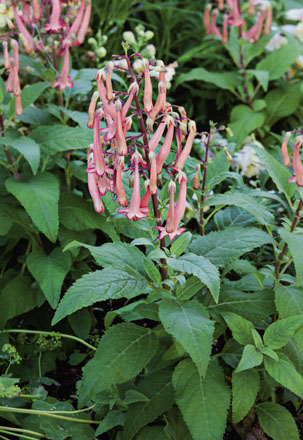
Phygelius ‘Funfare Orange’
‘Pink Elf’ spreads slowly. Maroon stems carry thick clusters of shrimp-pink flowers, yellow at the throat. Compact 24 in. Z7–9.
‘Sunshine’. Bright red at the mouth, burnt orange trumpets are set off by lime-colored foliage. Part shade in hot regions. 3–4 ft. Z7–9.
Lamiaceae
obedient plant, false dragonhead
These hardy perennials are “obedient” in the sense that if you twist one of the blooms on the showy flower spikes right or left, up or down, they will hold that position; this quality has endeared them to children and floral designers. Physostegias are far less obedient in the garden, however, where their tenacious, rhizomatous roots spread aggressively, often outgrowing their allotted spot. Smart gardeners site physostegias where their roaming tendencies are an asset, or with their roots confined in containers; less aggressive cultivars are available.
The genus of 12 species is native to North America. They grow wild throughout the contiguous 48 states, except in California, Arizona, Nevada, and Colorado. Outside the latter regions they flourish with little extra care in cultivation. Though they display opposite, sessile, toothed leaves and square stems common to the mints, the flowers more resemble those of snapdragons or foxgloves, borne typically in terminal spikes. Deer resistant.
Propagate by seed, division, or stem cuttings taken in spring.
Physostegia correllii
• pink
• midsummer
• 4–6 ft. × 1.5–3 ft.
• sun
• Z7–9
Correll’s false dragonhead. Wet sites in southeast Texas and Louisiana, but rare or endangered in the wild. Rhizomatous clumps of stout, tall stems with leaves that diminish in size as they ascend. Stems topped with spikes of 1-in., dark-purple-flecked, mauve-pink flowers. This water-loving perennial requires consistently moist soil; a good choice for wet meadows, streamsides, and rain gardens in mild regions.
Physostegia virginiana
syn. Dracocephalum denticulata, D. virginiana
• pink, white
• early to late summer
• 3–4 ft. × 2–3 ft.
• sun
• Z3–9
Obedient plant. Native to moist prairies and stream banks from Montana and New Mexico, east to the Atlantic coast, as well as Canada from Manitoba eastward. Rhizomatous clumps of erect, stiff stems with 1.5-in.-wide, lanceolate leaves, to 5 in. long. Tubular, 1-in. flowers in white, lavender, or purplish pink often accented with darker dots, stripes, or swirls; flower spikes to 10 in. long. Best in average, moderately moist, well-drained soil, but tolerates clay; staking often necessary on rich soils. Cut to 6 in. in early spring for sturdy, compact growth, less in need of support. Attracts hummingbirds. Provides late-season bloom to wildflower, prairie, meadow, and rain gardens; plant this aggressive spreader in confined gardens with caution. No serious pests, but occasionally attacked by fungal rusts.
‘Miss Manners’ is clumping and non-spreading; does not require staking. Pure white flowers in long, dense spikes are sterile (no viable seed). Superior to roving ‘Summer Snow’. 2–2.5 ft. Similar ‘Pink Manners’ has white-throated, lavender-pink flowers.
‘Variegata’ has lovely cream-edged leaves, for long interest. Lilac-pink flowers, 2–3 ft. Z4–9.
‘Vivid’ has rich pink flowers. May spread. 1–2 ft.
Campanulaceae
balloon flower, Chinese bellflower
This single-species genus has a wealth of fine cultivars, standbys of perennial gardens. Platycodon contributes reliable color to border fronts, rock gardens, and container plantings.
Balloon flower requires well-drained, organic-rich loam; wet or poorly drained soils encourage root rot. Slow to establish but long lived. Emerges from dormancy late in spring; leave old stems through winter to prevent accidental early disturbance. In early summer, cut young stems back by half to promote compact growth and avoid the need for staking; deadhead to extend flowering. Tasty morsels for slugs, snails, and rabbits, but otherwise problems are few; deer resistant.
Propagate by seed. Division is tricky; fleshy, fragile roots are easily damaged during transplanting.
Platycodon grandiflorus
• blue
• early to late summer
• 1–2.5 ft. × 1–1.5 ft.
• sun, part shade
• Z3–8
Balloon flower. China, Manchuria, Japan. Clumps of tall stems clothed with toothed, ovate to lanceolate, blue-green leaves, to 2 in. long. Flower buds puff up like balloons before opening into upward-facing, bell-shaped flowers with five pointed lobes, 2–3 in. in diameter. Blooms all summer.
f. apoyama ‘Fairy Snow’ is compact at 10 in.; large, white, blue-veined flowers.
‘Albus’ has large, white flowers. 24–30 in.
‘Fuji Blue’ has large, deep blue flowers. Similar ‘Fuji Pink’ has pale pink flowers, with darker veining.
‘Hakone Blue’ has double, blue flowers veined with white. ‘Hakone White’ is a double white. 18–24 in.
‘Sentimental Blue’ is dwarf, forming neat, low mounds, 6–8 in. × 18–24 in., with full-sized blue flowers.
Astra Hybrid Seed Strain offers dwarf plants with 2- to 2.5-in. flowers in white, pink, or blue. 3–6 in. Z5–8.
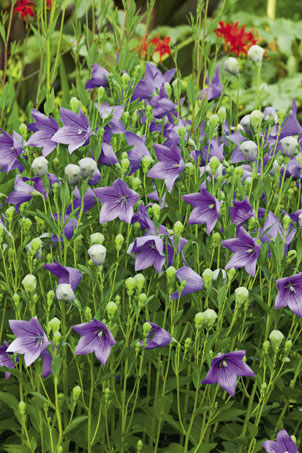
Platycodon grandiflorus
Berberidaceae
May apple
These rhizomatous woodlanders are found growing in large colonies or drifts in eastern Asia and eastern North America. They are ideal for damp shady borders and woodlands, and the fast-spreading types make splendid deciduous, seasonal groundcovers. Some are early deciduous, shedding their foliage in response to hot weather.
May apples have one or two large, peltate, palmately lobed leaves that emerge in spring, and are often decorated with dark markings. Flowers, solitary or clustered, are cup shaped with six to nine waxy petals in white or pink, but sometimes dark red. The egg-shaped fruits that follow contain lots of seeds that ripen toward the end of summer. The fruits are edible, but the rest of the plant is toxic to mammals, including deer and rabbits. Ongoing research explores if cancer-fighting drugs can be extracted from the plants, especially Podophyllum hexandrum.
Best in shaded or partly shaded places, may apples thrive where soil is high in moisture-retaining humus. Droughty soil promotes an early summer onset of dormancy.
Sow seed as soon as ripe; divide in spring or late summer.
Podophyllum hexandrum
syn. Sinopodophyllum hexandrum, P. emodi
• pink, white
• late spring to midsummer
• 18–24 in. × 24 in.
• part shade, shade
• Z5–8
Himalayan May apple. Himalayan mountains of northern India to China. Folded, umbrella-like leaves push through the soil behind the flower bud and unfurl over the next few weeks simultaneously with the bloom. Leaves are deeply lobed, about 10 in. across, with black, purple, and brown markings. Single, waxy, cup-shaped, 1- to 2-in. flowers between the leaves, open wide on sunny days and face outward rather than nodding as in other species. Fruits, 2 in. long and bright red when mature, nod on short stems. Does not have running roots; slow to spread into colonies.
Podophyllum peltatum
• white
• spring
• 8–18 in. × 18–24 in.
• part shade, shade
• Z3–9
May apple, American mandrake. Native to northeastern woodlands from Ontario and Quebec to Texas and Florida. Horizontal rhizomes spread widely and give rise to both sterile and fertile stems that emerge from the ground like unopened umbrellas. Sterile stems are 12–15 in. in height and topped by a lustrous green, 12-in.-wide, canopy-like leaf with five to nine toothed lobes. Fertile stems have a pair of similar but smaller leaves; in the crotch between them a short stem carries a solitary, slightly nodding, cup-shaped 2-in. flower. The fragrant blooms are usually white or pink, but are often hidden from view by the bold leaves. Egg-shaped, edible, 2-in.-long fruits follow, green at first but maturing to yellow by late summer; these are a favorite food for box turtles and other wildlife. Fast growing and drought tolerant when established. Valuable to Native Americans as an ingredient in remedies for female complaints.
• dark red
• late spring
• 24–30 in. × 24 in.
• part shade, shade
• Z6–9
Chinese May apple. China, Taiwan. A pair of large, bold, glossy leaves with five to nine pointed but shallow lobes. Clusters of five to nine brilliant red flowers nestle between the leaves; the fruits that follow ripen to bright yellow. The flowers have a strong and putrid odor that dissipates as time passes, probably after the flowers are pollinated by flies. Seed remains viable for only a short time and should be sown quickly. Clump forming.
Other Notable Cultivars
The following hybrids are commonly known as “Asian may apples”:
‘Kaleidoscope’ has dramatic 18-in.-wide, hexagonal leaves, boldly mottled with rings of maroon and silver. A single, burgundy-red flower appears between and below the leaves in late spring and early summer, followed by a fleshy yellow fruit. 18–24 in. Z6–8.
‘Spotty Dotty’ has large, lobed, umbrella-like, chartreuse leaves, dappled and mottled with chocolate. As the season progresses they green up but retain their lighter spots. In spring, five or more ruby-maroon flowers cluster between the leaves. Slow to spread but a wonderful accent plant in shade. 15–18 in. Z6–9.
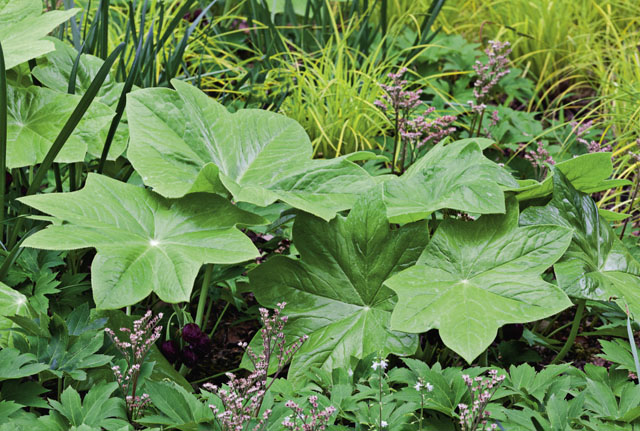
Podophyllum pleianthum
Polemoniaceae
Jacob’s ladder
Native to cool temperate regions of the Northern Hemisphere, the Arctic, and the Andes of South America, this genus of some 30 species includes several garden-worthy ornamentals. Jacob’s ladders are especially fine in shaded, woodland areas. They produce basal clumps of distinctive, bright green, ladder-like, odd-pinnate leaves divided into broadly lanceolate or oval leaflets; stem leaves become progressively smaller as they climb the upright or decumbent stems. Flowers are clustered or solitary, borne at the stem tips and in upper leaf axils. In shape the blooms vary: cup shaped and open, bell shaped, tubular, or trumpet shaped, flaring at the mouth. Most species have blue flowers, but some are pink or yellow.
Provide a moisture-retentive, humus-rich but fast-draining soil; many types falter in heavy clay. Jacob’s ladders do best in part to lightly dappled shade, in regions with cool-summer climates; full sun is acceptable only where light levels are poor. Some become summer dormant. Maintenance is low; cut back self-seeding species after flowering for neatness, to encourage rebloom later, and to discourage excessive self-seeding. Jacob’s ladders are susceptible to slugs and snails, and are sometimes attacked by powdery mildew, especially if allowed to dry out. Deer and rabbits seldom browse them.
Plant polemoniums at the front of shady beds and borders and in rock gardens; the larger species are appropriate for midborder. They are popular in cottage gardens too, where they assort well with foxgloves, hardy geraniums, and spiderworts. Under deciduous trees Jacob’s ladders mix well with ferns, primroses, and epimediums. Their flowers are visited regularly by bees and butterflies, and sometimes by hummingbirds; appropriate for wildlife gardens.
Increase by seed sown in spring or fall, or divide established plants in spring.
Polemonium caeruleum
• blue
• late spring to early summer
• 12–36 in. × 12–15 in.
• sun, part shade
• Z4–9, HS
Jacob’s ladder, Grecian valerian, charity. Western North America, Europe, northern Asia in mountain regions. This erect clump former develops a basal mound of foliage about 24 in. high and wide. Ladder-like leaves have elliptic, odd-pinnate leaflets 0.75–1.5 in. long, which grow smaller toward the stem tips. Loose, terminal and axillary clusters of fragrant, 1.5-in., cup-shaped, deep blue flowers are carried on branched stems. Leaf tips burn if plants are allowed to dry out, and foliage typically deteriorates with onset of summer heat. Self-seeds and will naturalize.
‘Brise D’ Anjou’ has green-and–creamy yellow variegated leaves; white-eyed, blue flowers. Short lived. 18 in.
‘Lace Towers’. Lax clusters of fragrant, cobalt-blue flowers. 3–3.5 ft. Z4–8.
‘Lacteum’ (‘Album’) has elegant white flowers.
‘Snow and Sapphires’ has light green foliage, trimmed with a well-defined white border. Fragrant, sky-blue flowers well above the leaves. An improvement on ‘Brise D’Anjou’. 24–30 in. Z3–7.
Polemonium carneum
syn. P. amoenum
• pink
• summer
• 18–24 in. × 18 in.
• part shade
• Z5–8, HS
Royal Jacob’s ladder. Northwestern United States, west of the Cascades from Washington to San Francisco. Ferny, 3- to 7-in.-long leaves, with 12 or more leaflets. Small clusters of delicate, bell-shaped flowers, light pink touched with apricot. Not the easiest to grow, but worth the effort. Maintain moist soil; protect from hot sun.
‘Apricot Delight’ has apricot-colored flowers. Reported to self-seed.
Polemonium pauciflorum
• yellow
• early to late summer
• 20–24 in. × 20 in.
• sun, part shade
• Z7–9
Yellow Jacob’s ladder. West Texas to Arizona, Mexico. This self-seeding but short-lived perennial has typical Jacob’s ladder foliage. Terminal clusters of pendent, yellow, trumpet-shaped flowers, flushed with red at the throat both outside and in. Blooms are about 1 in. long and flare widely into five lobes, each to 0.5 in. long at the mouth.
‘Sulfur Trumpets’ has silvery leaves topped by 3-in.-long, pendent, pale yellow trumpet flowers. 18 in.
Polemonium reptans
• blue
• late spring to early summer
• 10–18 in. × 12 in.
• sun, part shade
• Z2–7
Creeping polemonium, Greek valerian. Native to damp woodlands from New York to Kansas and Alabama. From shallow rhizomes rise weak, sprawling stems with ladder-like leaves. Drooping, 0.75-in., light blue flowers cluster at stem tips. Reseeds readily from tan-colored fruits. Keep moist for best results. Elegant combined with sedges, woodland phlox, trilliums, and foamflowers.
‘Alba’ is white flowered.
‘Blue Pearl’ has bright blue flowers on upright, 12- to 15-in. stems. Often listed as cultivar of Polemonium caeruleum.
‘Northern Lights’ is a dwarf, sterile selection with very fragrant, periwinkle-blue flowers. Resists powdery mildew. Probably a hybrid. 12–16 in. Z4–9.
‘Stairway to Heaven’ has green foliage, bordered with creamy-white edges, tinged with pink in early spring. Pale lavender flowers. 12–24 in. Z5–7.
‘Touch of Class’ is a sport with white-rimmed, green leaflets. Pink flower buds open to very pale blue blossoms. 14 in. Z3–7.
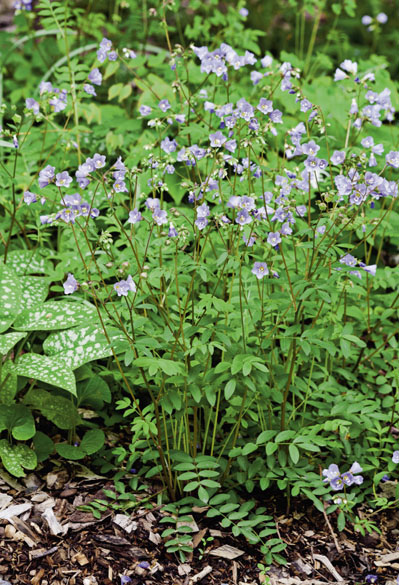
Polemonium reptans
Polemonium yezoense
• blue
• early summer
• 6–16 in. × 12 in.
• sun, part shade
• Z5–8
Jacob’s ladder. Japan. Young foliage is deep purple, but becomes green with a silvery sheen as the season progresses; very fragrant, powder-blue flowers. Best in moist soil, but not fussy; sun loving. Combines well with woodland phlox, coral bells, foamflowers, and later-blooming toad lilies.
‘Bressingham Purple’ (‘Polbress’) has upright, dark purplish stems that carry dark, purplish leaves. Fragrant, lavender-blue flowers. Vigorous and heat tolerant. Probably a hybrid; from Blooms of Bressingham. 15 in. Z4–9.
Purple Rain Strain has similar foliage but dark blue flowers. 12–18 in.
Asparagaceae
Solomon’s seal
Combining toughness with an offbeat elegance, the polygonatums are an asset to any shady planting. Their charming bell-shaped flowers dangle in rows like miniature carillons from the arching stems. But it is the foliage effects—the alternate, lanceolate leaves that climb the stems like rungs on a ladder—that give the plant its greatest visual impact. It contributes a precise architectural note often lacking in wild and woodland plantings, and that is always welcome in perennial borders.
Although Solomon’s seals prefer rich, moist but well-drained soil in partial shade, they tolerate wet or fairly dry conditions, and make do in full shade. Though not aggressive, over time their rhizomatous roots spread to form dense but compact colonies. They mix well with other woodlanders including arisaemas, ferns, and May apples. Susceptible to deer browsing.
Sow seed in containers in autumn; overwinter outdoors. Germination is slow; up to a year. Otherwise divide established plants.
Polygonatum biflorum
• greenish white
• midspring
• 1–3 ft. × 1–1.5 ft.
• part shade, shade
• Z3–8
Small Solomon’s seal. Eastern United States, south-central Canada. Rhizomatous; mounds of arching, unbranched stems with parallel-veined leaves to 4 in. long, that turn attractive yellow in fall. Flowers, usually borne in pairs dangling from leaf axils, are small and greenish white; blue-black berries follow. Native peoples ate the starchy rhizomes.
var. commutatum, giant Solomon’s seal, regarded as a separate species by some authorities, has also been listed as Polygonatum commutatum, P. canaliculatum, and P. giganteum. Considerably more robust (though less heat tolerant) than P. biflorum, with stout, arching stems, 6- to 7-in. leaves; flowers cluster two to ten per leaf axil, followed by blue-black berries. Useful for erosion control, as well as in woodland and cottage gardens, and naturalized areas. Needs room to show to best advantage. 3–7 ft. × 3–4 ft. Z3–7.
Polygonatum humile
• white
• late spring
• 6–12 in. × 1–3 ft.
• part shade, shade
• Z5–8
Dwarf Japanese Solomon’s seal. Native to mountains in Hokkaido, Japan. A petite counterpart to American Solomon’s seals. Rhizomatous, develops slowly expanding clumps of arching stems with ovate leaves. Pendent, tubular flowers dangle from leaf axils, followed by round, blue-black fruits in fall. Prefers fertile, humus-rich, moist but well-drained soil. Drought tolerant once established. Shady borders, rock gardens, or woodlands. Occasional attacks by slugs and sawfly larvae.
Polygonatum odoratum
• white
• spring to early summer
• 18–36 in. × 6–18 in.
• part shade, shade
• Z3–8
Fragrant Solomon’s seal. Europe, Asia. Clusters of arching stems bear elliptic leaves with one or two fragrant, tubular, green-tipped, creamy-white flowers hanging from each axil. Spherical black fruits follow contrasting with yellow autumn foliage. Occasional problems with slugs and sawfly larvae.
‘Fireworks’, to 2 ft., egg-shaped, green leaves, flecked with creamy white and developing creamy-white borders as they mature.
‘Variegatum’ has soft green leaves tipped and rimmed with white; good fall color.
Rosaceae
potentilla, cinquefoil
Best known to gardeners as tough, floriferous shrubs, Potentilla also includes a number of fine herbaceous perennials. Typically, these share the bright, cup-shaped, five-petaled flowers and fingered leaves that are the hallmarks of their shrubby relatives. However, the perennials have a more sprawling growth habit. They are most effective as groundcovers for sunny spots, especially where soils are poor and dry, as border edgings, or for inserting into crevices in walls or stone pavements.
Potentillas are easily grown in average, moderately moist, well-drained soils and several tolerate drought well. Their foliage may be as attractive as the flowers; few other perennials are so free of pests, undemanding, and have as long a bloom season. Potentilla fanciers combine several different types, to secure bloom from midspring into late fall. Deer resistant.
Propagate hybrids and named cultivars by division (unless otherwise noted); species from seed.
Potentilla atrosanguinea
• red
• summer
• 1.5–2 ft. × 1–2 ft.
• sun
• Z5–9, HS
Ruby cinquefoil. Himalayas. Widely branched, leafy stems clothed with silvery gray leaves, covered with silky hairs. Sprays of blood-red, 1-in. flowers are long blooming. A parent of many superior hybrids, often listed as cultivars.
‘Firedance’ has red-centered, coral flowers. 10–15 in.
‘William Rollinson’ has semi-double, flame-colored flowers, with a yellow reverse. 15 in.
‘Vulcan’. Low mounds of foliage; long-blooming, double, deep red flowers. 12–16 in. Z4–9.
‘Yellow Queen’ has cheerful clean-yellow flowers above silvery leaves. 12 in.
Potentilla nepalensis
syn. P. coccinea
• pink
• late spring to late summer
• 15–18 in. × 24 in.
• sun, part shade
• Z5–8
Nepal cinquefoil. Western Himalayas. Clump forming with branching, wiry stems bearing five-fingered, strawberry-like leaves. Foliage blanketed with purplish red flowers. Only available as cultivars in the trade. Cottage gardens, rock gardens, front of borders, containers.
‘Miss Willmott’ bears crimson-eyed, deep pink flowers. 12–18 in. × 12–24 in.
‘Ron McBeth’ has carmine-rose, 1-in. flowers, with dark red centers. Reproduces mostly true from seed. 9–12 in. × 12–18 in.
Potentilla recta
• yellow
• summer
• 12–24 in. × 15 in.
• sun
• Z3–7
Sulphur cinquefoil. Europe, but has naturalized across the United States. Upright tufts of unbranched stems bear strawberry-like, petioled leaves, usually with five to seven leaflets; light yellow flowers. Seldom cultivated but replaced by a superior cultivar ‘Macrantha’ (syn. Potentilla recta var. warrenii) that displays loose clusters of 1-in., brilliant yellow flowers for several weeks.
Grow in average, medium-moisture, well-drained soil in full sun to part shade. Prefers moist, cool soils in full sun. When grown as a groundcover, it can be mowed occasionally on a high setting to trim up the plants.
Potentilla thurberi
• red
• early to late summer
• 1–2.5 ft. × 1–2 ft.
• sun, part shade
• Z5–9
Scarlet cinquefoil. Coniferous forests of Arizona, New Mexico, and Mexico. Sprawling mounds of erect stems bear leaves with five to seven toothed, ovate-oblanceolate, 1- to 2-in. leaflets. Red flowers with dark blotches at the petal bases. Tolerates drought.
‘Monarch’s Velvet’ has deep raspberry-colored flowers. Mostly true from seed.
Other Notable Cultivars
‘Arc en Ciel’ bears double, crimson flowers, with yellow-edged petals. 12–16 in. Z4–8.
×hopwoodiana (Potentilla nepalenses × P. recta). Bicolored, dark red–eyed flowers of pale salmon-pink and cream. 16–20 in. × 16–18 in. Z5–9.
×tonguei (P. anglica × P. nepalensis) is fast growing, evergreen in mild climates. Apricot flowers blotched with red. Resents high heat and humidity. 4–6 in. × 12–18 in. Z5–8.
Primulaceae
primrose
Although diminutive in size, primroses pack such a wallop of charm that they are beloved by gardeners everywhere. One of the earliest flowers to bloom in spring, primrose can almost be translated as “the first rose.” Not even related to roses, however, more than 400 species fit into this diverse genus. It is so varied that botanists have split it into sections, grouped according to their probable relationships. Some of the most important for gardeners are the following:
Acaulis Section. Mostly derived from Primula vulgaris, with solitary flowers or sometimes umbels in a wide range of colors. Divide just after bloom time, or start from seed.
Auricula Section. Contains low-growing, evergreen species with flat, salverform flowers, smooth, leathery leaves. Often dusted with white farina (a mealy or granular covering like Farina cereal). Primula auricula belongs here. Divide after bloom time.
Candelabra Section. Flowers are held in tiers of whorls on leafless stems. Primula japonica and P. pulverulenta belong here. Moisture is critical. Divide or seed after bloom time.
Juliana Section. Solitary or umbels of flowers derived from P. juliae × P. veris or P. juliae × P. vulgaris. A wide color range, evergreen or semi-evergreen. Divide just before or just after bloom time.
Vernales Section. Includes P. veris (cowslip), P. elatior (oxslip), and P. vulgaris (English primrose) as well as polyantha types. Divide just after bloom time, or start from seed.
Primroses do best in climates with relatively cool summers. They do not care for southern heat and humidity, although they will sometimes tolerate but rarely thrive in the dry heat of southern California. Soil should be rich in moisture-retentive humus, well-drained, not prone to excessive drying out; many species will not survive wet feet in winter due to root rot. Provide neutral to slightly acid soil; P. vialii favors sweet, alkaline soil. Most prefer partly shaded sites but enjoy sunny spots in regions where light levels are low.
Primroses are lovely in woodlands and rock gardens, where the alpine species shine. For generations, assorted primroses have been planted out in blocks and patterns in public parks and gardens for colorful spring displays. Perhaps more attractive is to insert them in groups as punctuation in beds and borders, with spring-blooming tulips, daffodils, or hyacinths. Later-blooming perennials shade the primrose foliage. In woodlands, mix with ferns, violets, lungworts, and columbines for spring displays. Similar combinations are perfect for containers. Potted primroses are sold for interior decoration in late winter or very early spring; transplant to the garden when weather warms.
Seldom browsed by deer, squirrels, or rabbits. Primroses are susceptible to aphids, weevils, and spider mites (the latter particularly in greenhouses). Gray mold, rust, and viruses are sometimes a problem.
Primula auricula
syn. P. alpina, P. balbisii, P. ciliata, P. lutea
• yellow
• early spring
• 6–10 in. × 12 in.
• sun, part shade
• Z3–8
Auricula, mountain cowslip, bear’s ears. European Mountain ranges, including the Carpathians, Alps, and Apennines. Section Auricula. Evergreen, grayish basal rosettes of 2- to 4-in., fleshy, leathery, paddle-shaped leaves often dusted with gray farinose on both surfaces; tough, wavy margins variably equipped with teeth. A plump scape, 2–6 in. long, is topped with an umbel of up to 20 mostly fragrant, 0.5-in. flowers on 0.5-in. pedicels. Each deep yellow bloom consists of a long perianth tube that flares into a flattish corolla at the mouth. Shallow rooted; needs gritty, free-draining but moist soil.
Primula denticulata
syn. P. cachemiriana
• lilac, white
• early spring
• 8–12 in. × 9 in.
• part shade
• Z4–7
Drumstick primrose, Himalayan primrose. Moist, alpine regions of the Himalayas in Afghanistan to southeastern Tibet, Myanmar, and China. Section Denticulata. Robust rosettes of 3- to 6-in., spatulate leaves, finely toothed along the margins, white mealy beneath, elongate after bloom time to 12 in. or more on broadly winged petioles. As the leaves emerge in early spring, sturdy, upright, 4- to 12-in. stems appear topped with crowded 2-in. globes of funnel-shaped, 0.5-in. flowers in shades of lavender, lilac, and purple, or white, accented with a yellow eye. Supply protective winter mulch. Moderate moisture. Best from seed.
‘Alba’ has white flowers. 12 in.
Ronsdorf Hybrids is a seed strain of mixed colors. 18–20 in.
Primula florindae
• yellow
• early to late summer
• 2–3 ft. × 2 ft.
• part shade
• Z6–8
Florinda primrose, giant cowslip, Tibetan primrose. Native to shaded, marshy areas along streams in southeastern Tibet. Section Sikkimensis. This vigorous late bloomer has rosettes of 9-in.-long, lustrous, broadly ovate leaves, heart shaped at the base, on long, channeled, red petioles. Pendant and fragrant, tubular, bright yellow, 0.5- to 1-in. flowers gather into large umbels of 40 or more, all dusted with white farina, atop sturdy, 1- to 3-ft. scapes. Best in damp soil, or in drifts beside streams, ponds, or lakes.
Primula japonica
• pinks, reds
• late spring
• 18 in. high and wide
• part shade
• Z5–7
Japanese primrose, fairy primrose. Japan. Section Candelabra. Whorls of 8 to 12 flowers arranged in tiers, one on top of the other, topiary style. There are countless cultivars as the flowers are quite promiscuous. Plant at streamside, or beside moving ponds.
‘Miller’s Crimson’ has intense rosy-red flowers. Comes true from seed. 1–2 ft. Z6.
‘Postford White’ is a good white, possibly superior to ‘Alba’.
‘Rosea’ has rose and pink flowers that seed true.
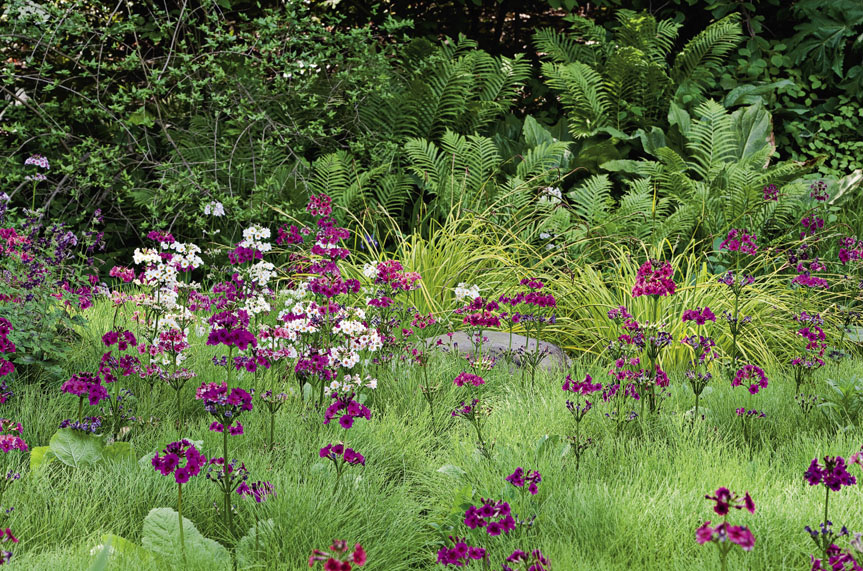
Primula japonica
Primula ×polyantha
• various
• spring
• 8–15 in. × 9 in.
• sun, part shade
• Z3–8, HS
Polyanthus primrose. Of hybrid origin with mixed parentage of Primula veris, P. vulgaris, and P. juliae. Section Vernales. This fantastic group of plants have often fragrant, single or double flowers that come in all colors, plain, bicolored, or sometimes with contrasting eyes. Umbels of upfacing, tubular flowers flared and flattened at the mouth (salverform) to 1.5 in. across top stems to 12 in. Neat rosettes of wrinkled, spatulate leaves, sometimes rimmed with teeth. The polyantha hybrids have been bred extensively for bedding, for the greenhouse florists’ potted-plant trade, and recently for fall landscaping displays. They prefer cool climates and struggle with heat and humidity. Moist soil. Excellent in the cool, damp northwestern parts of North America, where public parks and gardens host them widely.
Pacific Giant Strain comes in all colors with large flowers. Not as cold hardy as some.
Regal Strain. This Tasmanian strain tolerates a wide range of conditions.
Primula sieboldii
• pinks, purples
• late spring
• 4–8 in. × 8 in.
• sun, part shade
• Z4–8
Japanese star primrose, Siebold primrose. Japan. Section Cortusoides. Long petioled, wrinked, and scalloped, the 2- to 4-in.-long, ovate leaves are hairy on both sides. Umbels of six to ten showy flowers rise on slender, hairy scapes; flattish, white, mauve, or pink blooms may have deeply notched or frilled corolla lobes, and a white eye. Often summer dormant. Excellent in moist northeastern woodlands.
‘Alba’ has white flowers.
Barnhaven Strain. This superior seed strain comes in a variety of colors. The history of Barnhaven is most interesting.
Primula veris
syn. P. officinalis
• pale yellow
• early spring
• 4–12 in. × 9 in.
• sun, part shade
• Z5–7
Cowslip. The British Isles, temperate Europe, and Asia. Section Vernales. Oblong, 2- to 3-in. leaves, wrinkled and hairy beneath, are held on winged petioles as long as the leaf blades. One-sided, several-flowered umbels of fragrant, nodding, bright yellow blooms rise on downy, upright scapes, to 8 in. long. Each lobed, bell-shaped flower is restricted at the mouth where it emerges from a pale green, slightly inflated, five-angled calyx. Moist soil.
‘Katy McSparron’ has double flowers.
Sunset Shades is a seed mix of orange and red flowers, with bright yellow throats. 8 in.
Primula vialii
syn. P. littoniana
• red violet
• late spring
• 12–15 in. × 12 in.
• part shade
• Z5–7, HS
Chinese pagoda primrose, Vial’s primrose, orchid primrose. Northwest Yunnan, southwest Szechwan, China. Section Muscariodes. Short lived, with 12-in. basal leaves, pointed, lance shaped, and dentate, tapering to a winged petiole. Stiff, white, mealy stems hoist dense, conical, 3- to 6-in. spikes of bright red flower buds that open to fragrant, 0.5-in. flowers; slightly nodding with violet tubes, and pointed, lilac-blue corolla lobes. Best massed in dappled deciduous shade in boggy ground, pond- or lakeside. Requires moist soil with high pH; add lime if soil is acid.
Primula vulgaris
syn. P. acaulis, P. ×hybrida
• light yellow
• midspring
• 6–9 in. × 9 in.
• sun, part shade
• Z5–8
English primrose, common primrose. British Isles, western and southern Europe. Section Vernales. Synonymous with spring in rural England, this lightly fragrant species of hedgerows and woodlands is a major player in primula breeding programs. Blunt-tipped, ovate leaves are wrinkled, softly hairy beneath, and rimmed with round teeth; they elongate to about 6 in. on short, winged petioles by bloom time. Solitary, 1- to 1.5-in. salverform flowers of primrose yellow, blotched with a darker eye, rise on slender, fuzzy, pink stems, reddish at the base. Typical of primroses, stigma and styles vary in length: when the stigma is prominent like a pinhead with shorter stamens, the flower is said to be “pin-eyed”; if the stamens are longer than the stigma, the flower is “thrum-eyed.” Fertilization can only occur between pin-eyed and thrum-eyed flowers. Flowers and leaves are edible; flowers are sometimes made into primrose wine. Maybe the easiest to grow; tolerates short droughty periods.
Belarina Strain has fully double flowers in a wide color range. Long blooming.
‘Blue Jeans’ has grayish blue flowers, brushed with dark blue stripes.
‘Jack-in-the-Green’, pale yellow flowers within a loose ruff of large green sepals.
‘Quaker’s Bonnet’ produces double, deep rose pink flowers
Spectrum Series has lacy flowers edged with white.
Lamiaceae
self-heal
This genus is yet another in which a well-known weedy species, in this case Prunella vulgaris, has caused gardeners to neglect its better-behaved relatives. Aside from their supposed medicinal value—the self-heals, as the common name suggests, were formerly used to stop bleeding—a number make excellent floral groundcovers. In particular, P. grandiflora and its hybrids furnish handsome mats of evergreen foliage, with opposite pairs of leaves on square stems. Flowers are borne in verticillasters of six-blossom whorls interrupted by leafy bracts at stem tips. Common to mint family members, self-heal’s individual flowers are two lipped, hooded, about 1 in. high; the upper lip is two lobed, the lower three lobed.
Self-heal thrives in moist, average soil in sunny or partly shaded spots; protect from intense sun in hot regions. It tolerates dryish soil in part shade under deciduous trees or shrubs. Probably too vigorous for rock gardens, although it looks well in such sites if kept under control. Valuable as an edging at the front of beds and borders, alongside pathways, in coastal gardens, and in wildlife gardens, where it attracts honeybees and butterflies. Resists deer and rabbits. Self-seeds freely; remove spent flower spikes immediately after bloom time.
Increase cultivars by division.
Prunella grandiflora
• violet-blue
• early to midsummer
• 6–12 in. × 12–18 in.
• sun, part shade
• Z3–8
Bigflower self-heal, large self-heal. Europe. Low-growing mats of dark green, rough-hairy leaves, 3–4 in. long, heart shaped at the base. Flower spikes to 3 in. tall.
‘Alba’ has white flowers
Freelander Mixture is compact, early, and very vigorous. It blooms the first season from early seeding. 2006 Fleuroselect Gold Medal winner. Currently available in single colors: blue, pink, and white. 6–8 in. Z5–8.
The Loveliness Group is probably of hybrid origin, and is correctly Prunella ×webbiana. 6–8 in. Z5. ‘Loveliness’ has dense spikes of deep lavender flowers; ‘Pink Loveliness’ is rosy pink; ‘White Loveliness’ has white flowers that often brown prematurely at the tips.
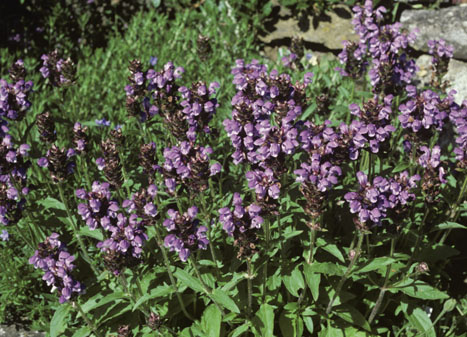
Prunella ×webbiana
‘Rosea’ has rosy pink blooms. 6–12 in. Z4–8.
Papaveraceae
rock fumewort
A new genus composed of two species formerly considered members of the Fumeworts, the genus Corydalis. Like the fumeworts, pseudofumarias have fleshy roots and finely divided leaves. The flowers are tubular and spurred, usually held in loose clusters at the stem tips. The pseudofumarias require a consistently cool, moist soil, high in organic matter; in cold climates, mulch the plants well in winter. Most species excel in the cool climate of the Pacific Northwest, and do not tolerate high summer heat and humidity. Where they flourish, they combine well with hostas, ferns, epimediums, lilyturf, and other shade lovers in woodlands, along pathways, and in rock gardens. Deer resistant; tubers are sometimes dug and devoured by squirrels and chipmunks.
Propagate by seed sown outdoors in fall, or indoors with stratification followed by bottom heat (65–75°F).
Pseudofumaria alba
syn. Corydalis ochroleuca
• cream
• late spring
• 12 in. × 12 in.
• part shade
• Z5–8
Native to rocky European woodlands, this species makes a mound of gray-green foliage that contrasts well with the yellow-throated, spurred, cream blooms. Sometimes repeat blooms, self-seeds freely. Create a color echo vignette with cream-edged basket-of-gold ‘Dudley Neville Variegated’.
Pseudofumaria lutea
syn. Corydalis lutea
• yellow
• spring to fall
• 12–18 in. × 12–15 in.
• sun, part shade
• Z4–8
Yellow corydalis. Southern Alps. Easier to grow than Pseudofumaria alba or its former relatives in the genus Corydalis. Produces succulent mounds of light green, ferny leaves and abundant clusters of bright yellow flowers. Best in regions with temperate summers, although it can be kept going elsewhere with adequate moisture. Short lived at best. Self-seeds freely but easy to weed out. Naturalizes well with forget-me-nots and Welsh poppies for a striking spring display.
Pseudofumaria lutea
Boraginaceae
lungwort
The common name sounds like a smoker’s malady, but in fact the lungworts are an invaluable, if often overlooked, group of garden perennials. They offer early season flowers—as early as late winter in mild climates—that have the intriguing habit of changing color as they mature. Their attractive, bristly, bold-textured foliage is often spotted, splashed, or painted with silver, and unlike that of many spring flowers, it remains attractive throughout summer and fall.
Natives of Europe and Asia, the slowly spreading, rhizomatous roots of pulmonarias prefer cool, moist conditions, and dappled shade. Average garden soil is fine, as long as it drains well and does not dry out; waterlogged soil is fatal. Aside from slugs, they suffer from few pests, resisting even deer. Powdery mildew can be serious, especially in dry summer conditions, but many recent introductions are resistant.
Pulmonarias bloom before or as the new foliage emerges in spring. Individual flowers are funnel shaped, divided into five shallow lobes at the mouth; some 0.25 in. across, they are held in drooping terminal clusters well above the leaf rosette. Flower color varies from purple and violet to blue, shades of pink and red, and white. Commonly, flowers are pink in bud and subsequently mature to blue or violet. After flowers fade, the basal leaves expand. Individual leaves are long, and narrowly lanceolate to oval in shape; stem leaves are smaller and usually sessile.
Lungworts combine well with early spring hellebores, lilyturfs, and crested iris; their foliage contrasts well with ferns. Elegant as a woodland groundcover, they offer a deer- and rabbit-resistant, but not woodchuck-resistant, alternative to hostas. Deadhead to the base. Amend soil with compost; mulch in summer. May prove short lived; extend lifespan by dividing plants every three to five years.
Propagate by division in fall, root cuttings taken in spring, or sow seed of species in spring. Lungworts commonly self-seed, but because they hybridize spontaneously, offspring of named cultivars rarely duplicate parents.
Pulmonaria angustifolia
• blue
• early spring
• 6–12 in. × 12–15 in.
• part shade, shade
• Z3–7
Blue lungwort, narrowleaf lungwort. Northeastern to eastern Europe. Lanceolate, dark green leaves; terminal cymes of flowers open pinkish, mature to deep, bright blue. Some authorities insist that plants in nursery trade are not botanically true Pulmonaria angustifolia; nevertheless, an outstanding perennial.
‘Blaues Meer’ bears heavier crops of bright blue flowers.
Pulmonaria longifolia
• blue
• early to midspring
• 6–16 in. × 18–36 in.
• part shade, shade
• Z3–8
Longleaf lungwort. Western Europe. Semi-evergreen, with long, narrow leaves, dark green with silver spots. Blue-purple to deep blue flowers. More sun tolerant than most species. Good powdery mildew resistance.
‘Bertram Anderson’ (‘E. B. Anderson’) has brilliant dark blue flowers. Somewhat slug resistant.
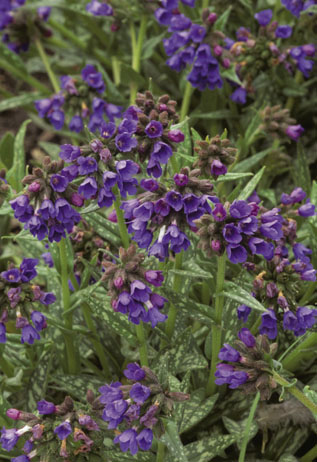
Pulmonaria longifolia ‘Bertram Anderson’
‘Dordogne’ has electric-blue flowers; silver-streaked leaves.
subsp. cevennensis has silver-spotted leaves to 2 ft. long; dark violet-blue flowers.
Pulmonaria mollis
• pink, blue
• early to midspring
• 2 ft. high and wide
• part shade, shade
• Z4–7
Central Europe to Asia. Largest of the species, forms robust clumps of green leaves 12–18 in. long. Deep blue flowers age to purplish pink. Among the heaviest blooming pulmonarias in a Chicago Botanic Garden trial. Exceptional sun tolerance.
‘Royal Blue’ has rich blue flowers.
‘Samobor’ has violet-red flowers that mature to a blue-purple.
Pulmonaria officinalis
• pink, violet, blue
• early spring
• 12–18 in. × 15–18 in.
• part shade, shade
• Z4–8
Common lungwort. Europe. Bristly, broad, semi-evergreen or deciduous, medium green leaves, spotted with greenish white. Flowers open pink, darken to violet, then fade to blue. More susceptible to powdery mildew than most other species.
‘Blue Mist’ has lavender-pink flowers that mature to light blue.
‘White Wings’ has large, white flowers; superior to older ‘Sissinghurst White’.
Pulmonaria rubra
syn. P. angustifolia ‘Rubra’, P. officinalis var. rubra
• red
• early spring
• 16 in. × 24 in.
• part shade, shade
• Z4–9
Southeastern Europe. Rosettes of light green, unspotted, elliptical leaves; clusters of red, tubular flowers. One of the earliest species to bloom.
‘David Ward’ has white-margined, light green leaves; brick-red flowers.
‘Redstart’ has apple-green leaves with petunia-red flowers.
• pink, violet, blue
• early to midspring
• 1–1.5 ft. × 1.5–2 ft.
• part shade, shade
• Z3–8
Lungwort, Bethlehem sage. Europe. Bristly, 4–12 in., elliptical leaves, medium to dark green blotched or speckled with silver, persist into late fall or early winter in cold regions, semi-evergreen where milder. Pink, violet, or blue buds open to slightly nodding, blue flowers. Tolerant of deep shade, but with less vigorous growth.
‘Excalibur’ has nearly solid silver leaves with irregular green margins, pink buds opening to blue flowers. Mildew resistant.
‘Leopard’ has coral-pink flowers.
‘Mrs. Moon’ has leaves heavily spotted with silver; light pink buds open to bright blue flowers. Largely replaced by superior cultivars.
‘Pierre’s Pure Pink’ has pure pink flowers that retain their color; spotted light green foliage. Somewhat slug resistant.
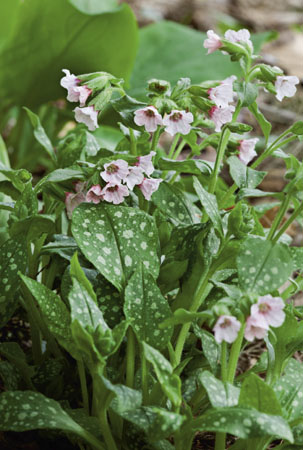
Pulmonaria saccharata ‘Pierre’s Pure Pink’
Other Notable Cultivars
The following are hardy in Z4–8 unless otherwise noted.
‘Apple Frost’ has leaves heavily splashed with silver, and green midribs; soft pink flowers mature to violet-blue. Mildew resistant. 12 in. × 18 in.
‘Berries and Cream’ has mostly silver leaves with slightly ruffled, mottled green margins; raspberry-pink flowers. 12 in. × 18 in.
‘Bubble Gum’ has mildew-resistant, silver leaves, topped with rose-pink flowers that hold their color. 14–16 in. × 12 in.
‘Roy Davidson’ sports silver-spotted leaves. Very tolerant of heat and humidity; among the heaviest bloomers in a Chicago Botanic Garden trial. 12 in. × 18–24 in. Z4–9.
‘Silver Bouquet’ combines outstanding heat and humidity tolerance with mildew resistance. Leaves mostly silver, large coral to pink to violet flowers. 7–10 in. × 20 in. Z4–9.
Lamiaceae
American mountain mint
Wonderfully aromatic foliage is the chief attraction of this genus of North American natives; mountain mints have long been used for minty teas and for treatment of digestive ailments. They grow wild mostly in open meadows and woodlands; very easy to cultivate.
Mountain mints have running roots that may spread aggressively, especially in moist, partly shaded spots. Withholding water helps control invasive tendencies. Wiry, square stems are vertical and fibrous, clothed with opposite pairs of fragrant, softly hairy leaves, mostly narrowly lance shaped, and sessile or on short petioles. Stems branch from the upper leaf axils also. Small, 0.5-in. flowers typical of mint: two lipped, the upper lip two lobed, the lower three lobed. These crowd into dense heads accompanied by leafy bracts. The fruits are nutlets. All part of the plants smell refreshingly of mint.
Plant mountain mints in sun or part shade in loamy, consistently moist soil. Other than controlling their spreading habit, they need little maintenance. The stems are good for cutting and look especially well as filler with blousy hydrangeas; the minty aroma is pleasant indoors on a hot summer day. Although many gardeners prefer to cut most perennials to the ground, dormant mountain mints provide cover for insects, seeds for birds, and are particularly attractive dusted with snow. Rust may sometimes be a problem and need treatment. Deer and rabbits ignore these strongly aromatic plants.
Herb and kitchen gardens are improved by the addition of mountain mints for teas, potpourri, and other uses. Mix with shrubs in light woodlands where they can spread without trespassing on smaller specimens, or mass them on difficult banks.
Propagate by division in summer, or start from seed in place in spring or fall.
syn. P. tenuifolium
• white
• early to midsummer
• 24–36 in. × 15–18 in.
• sun, part shade
• Z5–8
Appalachian mountain mint, slender mountain mint, Savanna mountain mint. Native to the southeastern coastal plains of the United States. The tough rhizomatous clumps that this species develops are valued for soil erosion control. Upright stems clothed with pairs of fragrant leaves, often rimmed with red, are topped with fluffy, globular, silver-white heads, with white flowers and white-tipped bracts. An important larval food for caterpillars of grey hairstreak butterflies. Drought tolerant.
‘Cat Springs’ is a selection that is reportedly superior to the species. Masses of heads of white flowers. 36 in. Z6–8.
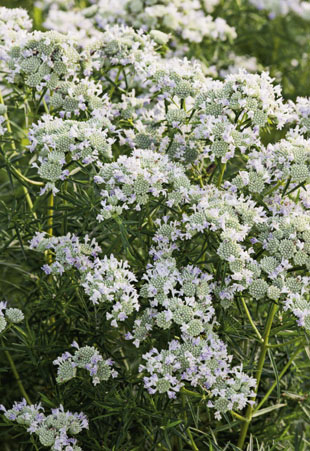
Pycnanthemum flexuosum
Pycnanthemum muticum
• pink, white
• summer to early fall
• 2–3 ft. × 15–24 in.
• sun, part shade
• Z4–8
Clustered mountain mint, short-toothed mountain mint, big leaf mountain mint. Native to damp woods and meadows from Massachusetts to Michigan, and south to Georgia, Louisiana and Texas. Differs from Pycnanthemum virginianum by having broader, lustrous leaves with very showy, silvery bracts; in summer the plants appear to have been heavily dusted with silver. Excellent nectar and pollen plant for insects and butterflies; long blooming. Seldom spreads unduly. Leave the spent heads as winter cover for insects. Outstanding in native plant gardens with beebalm, coneflowers, purple coneflowers, and obedient plants. Lovely at woodland edges, perhaps with white-variegated sedges such as Carex morrowii ‘Ice Dance’. Reputedly toxic as a tea.
Ranunculaceae
buttercup
This Jekyll and Hyde genus includes a number of fine garden perennials, but also some particularly invasive species, that despite their attractive flowers, should never be planted outside their natural range.
The weedy species include creeping buttercup (Ranunculus repens), a European native that has naturalized on wet soils across North America, and lesser celandine (R. ficaria, Ficaria verna), native to Europe and western Asia, that has proven a very troublesome weed in the Pacific Northwest, and from Missouri east and north to Virginia and Quebec. Cultivars of the latter species, including better-behaved ‘Brazen Hussy’, are fairly common in the nursery trade, but outside the species’ native range should be avoided in favor of less-aggressive relatives.
In general yellow or white, occasionally orange flowers, with five lustrous petals and a central knot of stamens, characterize members of this species. The leaves are alternate, commonly or entirely basal, and often palmately compound or finely dissected; basal leaves are usually long stalked, stem leaves short stalked or sessile. Buttercups’ acrid sap makes them distasteful to grazing animals, and to deer and rabbits, in particular, which enhances the plants’ invasiveness. All parts should be considered toxic.
Propagate by seed or divide.
Ranunculus aconitifolius ‘Flore Pleno’
• white
• late spring to early summer
• 24 in. × 18 in.
• sun, part shade
• Z5–9
White bachelor’s buttons. Mountains of central and southern Europe. Vigorous, forms a neat clump of palmately divided, dark green leaves; branching stems bear 0.75-in., double, button-like, white flowers that bloom over two months. Non-spreading: roots do not run and flowers are sterile, producing no seed. Provide humus-rich, fertile, and moisture-retentive but well-drained soil. Good for cottage gardens, beds and borders, and as cut flowers.
Ranunculus asiaticus
• various
• early spring to early summer
• 1–2 ft. high and wide
• sun
• Z8–10
Persian buttercup. Southern Europe, southwestern Asia. Tuberous rooted, with finely cut, parsley-like leaves in mounds, to 12 in. high. Cup-shaped, poppy-like flowers, to 2 in. across, have purple-black anthers, and are held on 1- to 2-ft. stems. Countless hybrids, some with bicolored and double flowers, and to 4 in. across have been developed. Well adapted to mild-winter regions, long, cool springs, and dryish but not too hot summers. Plant the tubers in fall; bloom begins in early spring, and extends over a long season. Elsewhere, grow as annuals planted out around the last spring frost date, or in containers overwintered in a cool, dry, frost-free spot. Prefers moderately moist, well-drained soils; does not tolerate waterlogged soils, especially in winter. Good for beds and borders; superb cut flowers.
Bloomingdale Strain is compact, to 10 in., with pale orange, pink, red, yellow, and white, double flowers.

Mixed Ranunculus asiaticus Bloomingdale Strain
Tecolote Strain has mostly fully double flowers, 3–6 in. across, in bicolored picotee, gold, pastel mix, pink, red, rose, salmon, sunset orange, white, and yellow. A visit to the the Flower Fields in Carlsbad, CA, at bloom time is unforgettable.
Ranunculus californicus
• yellow
• late winter to midspring
• 2 ft. high and wide
• sun, part shade
• Z6–10
California buttercup. British Columbia, south through California. Undemanding perennial native to chaparral, coastal scrub, and open woodlands. Dissected leaves and 0.75-in., bright yellow flowers with 7 to 22 teardrop-shaped petals on long, leafless stems. Prefers clay soils but adaptable; summer dormant without irrigation. When irrigated, cut back hard after bloom to force out new growth and second flush of flowers. Self-seeds.
Asteraceae
prairie coneflower, Mexican hat plant
This native prairie genus of five or six species includes two garden-worthy perennials. The genus differs from other coneflowers in having an elongated central cone or disk, usually tan colored to black; the surrounding slender ray “petals” often droop. Mexican hat plant is so named for its supposed resemblance to a sombrero, with the central flower cone forming the crown, and the ray flowers, the brim. Leaves are roughly hairy, pinnately divided into lobes.
Provide well-drained, average garden soil and a sunny spot for prairie coneflowers. These tough plants tolerate heat and humidity and thrive in inhospitable terrain. Leave spent flowerheads for seed-eating birds. Bruised leaves emit the smell of anise; deer seldom browse the foliage, though they may try a flowerhead or two. Reportedly rabbits also shun these plants.
Mass prairie coneflowers in meadows, and wild or native plant gardens with grasses and other natives. Also useful in sunny beds and borders, and as cut flowers.
Mexican hats self-seed freely. Increase by seed sown in late spring.
Ratibida columnifera
syn. R. columnaris, Rudbeckia columnifera, Lepachys columnifera
• yellow, red-and-yellow
• mid- to late summer
• 24–36 in. × 12–24 in.
• sun
• Z3–8, HT
Upright prairie coneflower. Southwestern Canada, west and central United States to New Mexico. This prairie native has showy, butterfly-attracting daisies with three to seven slightly drooping ray flowers, and a broadly cylindrical, 2-in.-long, dark brown or purplish central cone. The hairy leaves are about 5 in. long, each lobe linear and toothless. Does not tolerate clay soils well. Short lived.
‘Buttons and Bows’ has frilly, double, rusty flowers with wider rays edged with gold. 18–23 in. Z6–9.
‘Red Midget’ sports the typical tall cone and widely reflexed ray flowers in deep auburn, orange, and yellow. Good heat tolerance. Compact at 18–24 in. Z3–8.
var. pulcherrima has brownish red-purple rays surrounding an ocher cone.

Ratibida columnifera
Ratibida pinnata
• yellow
• mid- to late summer
• 3–5 ft. × 18 in.
• sun, part shade
• Z3–8, HT
Prairie coneflower, gray-headed coneflower. Native to the US midwestern prairies. Leaves to 5 in. long with three to five lobes, each slender, ovate, pointed, and toothed. Solitary flowerheads rise on stiff, upright stems. Central cones are usually grayish, shorter than the rays, surrounded by 6 to 13 drooping, yellow ray petals, 2–3 in. long. Tolerates clay, and poor dry soils.
Phrymaceae
Chinese foxglove, Beverly bells
In traditional Chinese medicine, Chinese foxgloves are used as a popular tonic for strengthening the liver and replenishing vitality, as well as treatments for various other ailments. Do-it-yourselfers should beware that all parts of this plant are poisonous if ingested without proper processing and supervision. What is less well known are the horticultural benefits of the unusual and charming flowers of Chinese foxglove. Similar in appearance to those of penstemons and foxgloves, rehmannia blooms are showier and last longer.
Chinese foxglove prefers a fertile, loose, moist soil that drains well; irrigate during dry periods. Plant in full sun in regions where sunlight is less intensive, but provide part shade elsewhere; they do not tolerate wet feet in winter, and require protection from winter winds. In harsh winter areas, treat as biennials, or pot up and overwinter with protection. Fertilize lightly in spring. Deer and rabbit resistant.
Propagate from fresh seed (collect from your own plants if possible) or take root cuttings in fall to winter. Root softwood cuttings of young spring growth, or remove and transplant runners.
Rehmannia elata
syn. R. angulata
• pink
• late spring to midsummer
• 24–36 in. × 20–24 in.
• sun, part sun
• Z6–10
Beverly bells. China. Underground runners form colonies of low, mat-like rosettes of hairy, oblong, gray-green leaves, usually lobed or toothed. Stem leaves are alternate with conspicuous venation. Nodding, softly hairy, pinkish purple flowers with yellow-dotted throats collect in loose spikes atop red stems and in leaf axils. The plants enjoy a maritime climate; bloom is best in cool-summer regions; protect from winter wet. Frequently self-seeds, or collect seeds in fall for replacements. Good for cut flowers. Rehmannia glutinosa is less often grown, except for medical purposes. Its flowers are yellow, flushed with purple, and the whole plant is much more hairy than Chinese foxglove.

Rehmannia elata
Polygonaceae
ornamental rhubarb
Most Americans are familiar with the culinary rhubarb that furnishes a filling for pies; fewer are aware that rhubarbs also include several bold and beautiful garden perennials. These have the outsized leaves and plume-like flowerheads of their kitchen-garden cousins, but are more refined and often more colorful. They provide a strong architectural note to beds or borders. Moreover their expansive foliage makes dramatic counterpoint to plants such as airy-foliaged meadow rues, whose dainty purplish pink flowers harmonize nicely with those of the rhubarbs. Other dramatic combinations include white-flowered penstemons, summer phloxes, and delphiniums backed by burgundy-leaved rhubarbs. For a tropical foliage effect on a grand scale, substitute rhubarbs as cold-hardy alternatives to Gunnera; similarly, rhubarbs thrive alongside ponds and streams. Unlike culinary rhubarb, ornamental rhubarb stems are not edible; all parts are toxic.
Provide deep, humus-rich, evenly moist soil that drains well; mulch in summer to protect against drought. Provide midday part shade where sun is intense; elsewhere, full sun is fine. Adapts poorly to combined heat and humidity. Where drainage is poor, crown rot may be a problem; occasionally attacked by rhubarb curculios. Be alert for leaf spots that mar the leaves but are seldom serious. Deer relish them.
Divide in early spring. For the patient, sow seed in fall.
Rheum alexandrae
• yellow
• late spring to midsummer
• 4 ft. × 2 ft.
• sun, part shade
• Z5–8, HS
Alexander’s rhubarb. China, Tibet. Lustrous, long-petioled, white-veined, lanceolate leaves to 8 in. long arise from deep roots. Tall stalks carry insignificant flowers that are concealed by hand-sized, creamy-yellow bracts, streaked with burgundy as they mature. Foliage becomes bright wine-red and orange in autumn.
Rheum palmatum
• pink, red
• early to midsummer
• 6–8 ft. × 4–6 ft.
• sun, part shade
• Z4–7, HS
Turkish rhubarb, Chinese rhubarb. Northwestern China, Tibet. The reference to Turkey in the common name is a misnomer dating to earlier times, when this species’ highly esteemed medicinal roots entered Europe through Turkey. Large domed mounds of rounded, palmately lobed, dark green leaves, each 2–3 ft. across. Pink to red flowers are individually tiny, six tepaled, and carried in 1- to 2-ft.-long, terminal panicles on stout, tall stems.
‘Atrosanguineum’ (‘Rubrum’) has bright red young leaves; only red beneath at maturity.
var. tanguticum (syn. Rheum tanguticum) has reddish bronze young leaves that mature to dark green, purplish red underneath. Soft pink flowers; red autumn foliage color.
Other Notable Cultivars
‘Ace of Hearts’ (Rheum kialense × R. palmatum) has spade-shaped, 3-ft. leaves, lustrous and crinkly when young, but mature dark green with prominent red veins, burgundy beneath. Deep pink flowers. 4–5 ft. × 3–4 ft. Z4–9.
Melastomaceae
meadow beauty, deer grass
This wonderful native genus is the most northerly member of a mostly tropical family that also includes glory bush (Tibouchina) and princess flower (Centradena). A common denominator of the family is the conspicuous, parallel veins on the leaves. Some meadow beauty species are rare, even endangered, but those described here may be spotted during a hike through the New Jersey pinebarrens or sandy swamps of the Carolinas and similar sites along the Mid-Atlantic seaboard. In gardens, meadow beauties provide a vibrant display of color toward the end of summer, when other flowers may be scarce.
The flowers have four oblique petals and four pairs of curved petals. They are pollinated by bees that buzz the flowers, shaking out the pollen from pores at the tips of the anthers. Curiously, the flowers’ prominent stamens change color over the day after opening, changing from bright yellow to red. Urn-shaped fruits are tan colored.
In the wild, meadow beauties grow in acid, moist soils in open places. Grow them in damp meadows, in bog gardens beside ponds or lakes, and even in rock gardens where soil remains damp. Improve heavy or poor soils by adding generous doses of coarse, gritty sand and organic matter. Probably seldom browsed by deer or rabbits.
Propagate by division in spring or fall, or start from seed. Seeds must be dry and ripe before harvesting.
Rhexia mariana
• pale pink, white
• summer to early fall
• 8–18 in. × 12 in.
• sun
• Z6–9
Maryland meadow beauty, dull meadow-pitchers. Native to sandy swamplands and bogs of the eastern coastal plain and south-central United States. Rhizomatous roots give rise to rounded stems bearing pairs of lanceolate, pointed leaves, 1–2 in. long, covered with stiff hairs. Pale pink or white flowers similar to those of Virginia meadow beauty are borne in 2-in.-long, terminal racemes.
Rhexia virginica
• magenta-pink
• summer to fall
• 12–20 in. × 12 in.
• sun
• Z3–9
Virginia meadow beauty, deer grass, handsome Harry. Native to sandy swamplands and bogs of the eastern coastal plain, south to Florida. Although uncommon in gardens, Virginia meadow beauty deserves wider use. Rising from tubers, square stems with prominent wings at each corner and bristles at the nodes, are furnished with pairs of sessile, pointed, ovate leaves, 2–3 in. long. These are distinctly marked with three or five parallel veins, and are rimmed with hair and tiny teeth. Loose clusters of outward-facing, bright rose-purple, 1- to 1.5-in. flowers with notched petals, crowd the top of the stems. Although moist, acid soil is ideal, this species tolerates average garden soils well.
Rhodohypoxidaceae
red star
To succeed with the red stars, it’s essential to reproduce the dry winters and moister summers of the South African grasslands and rocky mountainsides where these plants evolved. If these conditions can be duplicated, red stars will prove valuable as edging plants at the front of rock-edged borders, along paths and walkways, or in well-drained rock gardens. They make excellent container plants. Flower colors are variable, including a wide range of reds, pinks, and white; the blossoms show off well against the grassy foliage covered with gray hairs.
These Southern Hemisphere gems do best in moderately fertile, well-drained soils where they get plenty of water during the growing season, but remain dry during their winter dormancy; some gardeners protect the plants with a piece of slate or split pot set on a slant. In containers, allow them to dry out after bloom finishes, and water only sparingly until growth recommences the following spring. Red spider mites may attack plants grown under glass. Deer and rabbit tolerant.
Increase by removing offsets or dividing clumps in fall. Start from seed in spring.
Rhodohypoxis baurii
• pink, white
• late spring to early summer
• 3–6 in. × 4 in.
• sun
• Z7–10
Spring star flower, red star, rosy posy. Native to rocky areas of the Drakensberg Mountains, South Africa. Small tubers, covered with fibers, produce basal clusters of hairy, 4-in.-long, grassy, gray-green leaves. Solitary, pink to red, or white, 0.75-in., star-shaped flowers bloom through most of the summer on 2- to 4-in. stems.
‘Glitterbug’ has deep rosy-pink blooms.
‘Pintado’ blooms with pale pink flowers tipped and centered with deep rose.
‘Venetia’ has vivid magenta-pink flowers.
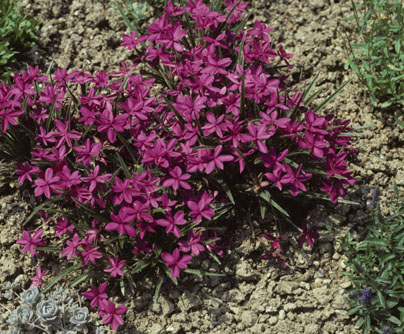
Rhodohypoxis baurii
Saxifragaceae
Rodger’s flower
Plants in this seriously underused genus are unmatched for making statements in moist beds or borders; furthermore they provide bold foliage effects in open woodlands, pond- and streamsides or bog gardens, where there is simply nothing more effective than these hardy eastern Asian natives. Naturals for rain gardens. These are not plants for confined spaces, however: from rhizomatous roots rise mounds of expansive, fingered, pinnate leaves with deep-set veins; individual leaves may, depending on the species, measure 16 in. across, with the aggregate mound spanning 3–5 ft. Flower stalks as much as 4–6 ft. tall soar above in summer carrying huge sprays of tiny, pink or white flowers, somewhat like giant astilbes. Star-like seed capsules may turn red as temperatures cool, accenting the yellow hues of rodgersias’ fall foliage.
In the wild, rodgersias inhabit damp sites alongside streams, ponds, or the edges of wet woods and meadows. Provide consistently moist, humus-enriched soil, and full to part sun. Select a spot protected from strong winds that damage the large leaves. Pest and disease problems are few, except for slugs and snails, and powdery mildew if plants dry out. Rabbit and deer resistant.
Propagate by division, or sow seed of species.
Rodgersia aesculifolia
• white, pink
• early to late summer
• 3–5 ft. × 3–5 ft.
• sun, part shade
• Z5–7
Native to China. Thick, black rhizomes support a clump of palmate, coarsely toothed, crinkled, dark green leaves tinted bronze, to 12 in. across. These resemble those of horse chestnut (Aesculus), and have five to nine leaflets. Fragrant flowers, creamy white or light pink, gather in 18- to 24-in., terminal panicles atop long stems. Flower stalks, stems, and leaf margins are clad with brown hairs. Leaf margins crisp and brown if soil dries out.
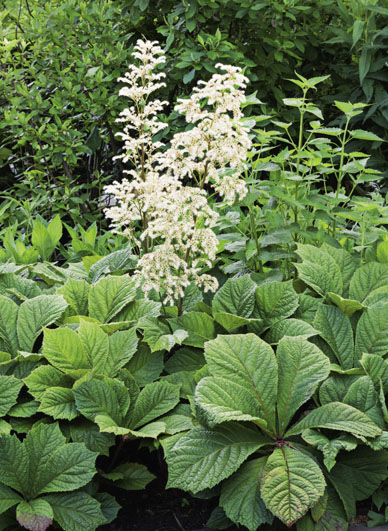
Rodgersia aesculifolia
Rodgersia pinnata
• pink, red
• late spring to early summer
• 3–4 ft. high and wide
• sun, part shade
• Z5–7
Southwestern China. Pinnately compound leaves with six to nine leaflets, each 6–8 in. long. Apetalous flowers, varying from creamy pink to red, borne on erect stalks in branched panicles well above foliage. Reddish bronze fall foliage. Prefers light shade.
‘Alba’ has bright green leaves; white flowers.
‘Chocolate Wings’ has deep cocoa-bronze spring foliage that matures to dark green; deep pink flowers.
‘Fireworks’ has cherry-red flowers and extra-large (leaflets to 10 in.) foliage with bronze spring hue.
Rodgersia sambucifolia
• pink, white
• early summer
• 2–3 ft. high and wide
• sun, part shade
• Z4–7
China. Pinnately compound, dark green leaves similar to those of elderberries (Sambucus); each leaflet to 8 in. long. Erect stems rise from 3- to 4-ft. foliage mounds to bear pink or creamy-white flower plumes. Vigorous and spreading; may form extensive colonies over time. Tolerates full sun only in cooler climates; provide a protective winter mulch in northern part of its range. Flourishes in boggy, wet soils.
Other Notable Cultivars
‘Big Mama’ bears tall plumes of fragrant, shell pink flowers in early to midsummer. Palmately compound leaves, each usually with seven leaflets. Sun, part shade. 3–5 ft. high and wide. Z5–7.
Asparagaceae
Nippon lily, sacred lily
If you are seeking a deer-resistant alternative to hostas, consider Nippon lilies. These Asian evergreens may not be quite as varied as hostas—the genus includes just one species—but their foliage is bold and tropical looking. Moreover, they are tough and easy to grow, thriving even beneath black walnut trees.
Nippon lilies do best in slightly moist, shaded spots, but tolerate dry shade well and manage to shine even in deep shade. Their glossy foliage remains attractive all year round; remove old, spent leaves from the outside of the plant by pulling them outward from the base. Otherwise they require little maintenance, and this, together with their ability to flourish in difficult circumstances, is winning them increasing popularity. Mass Nippon lilies under trees as a groundcover, or cultivate them in large containers; their persistent bright berries make them welcome through the holidays and beyond, even providing a brilliant counterpoint to early spring bulbs. Appropriate companions include shade-loving astilbes, ferns, hellebores, and Hakone grass. Due to their huge popularity in Japan, hundreds of selections have been made. Some of these have been introduced in this country; the species is readily available. Watch for slugs in moist shade locations. Deer do not browse.
Divide in spring or fall, or start from seed in containers in fall.
Rohdea japonica
syn. Orontium japonicum
• whitish yellow
• late spring to summer
• 9–24 in. × 24 in.
• part shade, shade
• Z6–10
Nippon lily, sacred lily, lily of China. China, Japan. Slow growing from fibrous roots, this evergreen perennial makes vase-shaped tufts of broad, glossy foliage that rises from the central crown. Strap shaped and slightly arching, the dark green leaves may be 12–18 in. long and 2–3 in. wide. Nestled low among them, the stubby inflorescence is pineapple-like, 1–2 in. long, with tiny, whitish yellow flowers; red fruits follow later in the season and persist through winter.
‘Chirimen-boshi’ (‘Asian Valley’) has rounded tips to overlapping leaves, irregularly edged with cream.
‘Fuji No Yuki’ (‘Snow on Mt Fuji’). Very handsome, with 18-in.-long leaves, edged with a wide white border.
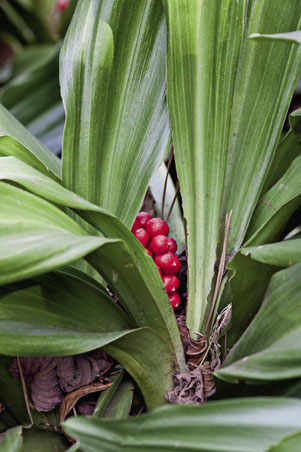
Rohdea japonica
Papaveraceae
Matilija poppy
This iconic plant of Californian gardens is also reported as far north as Vancouver, in the upper southeastern United States, and the British Isles. Arising from aggressive rhizomes, it is too assertive for borders, so only plant matilija poppies where there is space to spread. Other California natives such as flannelbush (Fremontodendron californicum), or drought-tolerant rosemaries, sages, and ‘Coronation Gold’ yarrow are appropriate companions.
Matilija poppies are useful as low-maintenance, free-flowering subshrubs, particularly in hot, dry locations. They are ideal for xeriscapes and harsh areas where other garden plants don’t flourish. Outside of their native soils they require very well-drained soil, preferably light and sandy; they are likely to require repeated attempts to establish in clay soils. Very heat and drought tolerant once rooted in; moderate early summer irrigation prolongs bloom in dry climates, but overwatering is fatal. Dislikes winter wet, and resents disturbance.
Propagate by seed, or by transplanting rooted suckers.
Romneya coulteri
• white
• early to midsummer
• 3–8 ft. × spreading
• sun
• Z7–10
Matilija poppy, tree poppy. Native to chaparral in southern California and Baja California. Upright, deciduous subshrub that spreads aggressively by rhizomes. Glaucus, gray-green leaves to 5 in. long, are pinnatifid with three to five lanceolate to ovate lobes. Flowers solitary, saucer-shaped to 6 in. across, with six crepe-like, white petals, and a prominent central boss of golden stamens.
var. trichocalyx (syn. Romneya trichocalyx) is often sold as a separate species but is almost identical, except for fuzzy calyx and slightly narrower leaves.
Zingiberaceae
roscoea
With their exotic, orchid-like flowers, roscoeas are much sought after, and the difficulties of their care only seem to add to their éclat. They are adapted to climates with cool summers and mild winters, which, in the United States, limits their outdoor cultivation to parts of the Pacific Coast. Elsewhere, they are best grown under glass. In the wild they grow in open woodlands and grasslands in mountain regions of eastern Asia.
Of some 17 species, only a few roscoas are offered for sale. They grow from fleshy, tuberous roots, with “pseudostems” (stems composed of the leaf bases or leaf sheaths) like other ginger family members. From the upper sheaths of stem-clasping leaves, flamboyant blossoms emerge; each sports a wide upper lip that serves as a hood, and a conspicuous, usually pendulous, lower lip.
Roscoeas do best in cool woodland gardens and moist, shaded borders, where they mix well with wild gingers, and low ferns. Provide fertile, humus-rich soil that drains well but never dries. Plant tubers at least 5–6 in. deep. Apply an organic, moisture-retaining mulch, and provide extra cold-weather protection; dormant in winter. Be alert for slug damage. Aside from the species described below, purple, yellow, pink, or white Roscoea humeana from China and Himalayan purple and violet R. alpina are worth trying, especially for rock gardens or with protection.
Increase by dividing the tubers in spring, or start ripe seed in containers in a cold frame.
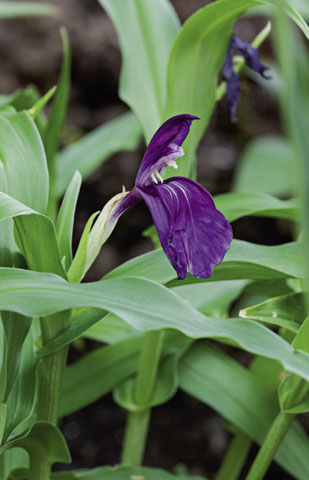
Roscoea alpina
Roscoea cautleoides
syn. R. cautleyoides
• yellow
• late spring to early summer
• 12–16 in. × 6 in.
• sun, part shade
• Z6–9
Alpine pine forests, meadows, and grasslands of Yunnan and Sichuan Province, China. Relatively easy to grow, this variable species usually has short spikes of two to five creamy-yellow, 3-in. flowers, held well above lanceolate, 5-in.-long leaves.
‘Jeffry Thomas’. Pale yellow flowers with a cream lip, crumpled along the edges. 16 in. tall.
‘Kew Beauty’ (‘Grandiflora’) has large, pale yellow flowers.
Roscoea purpurea
• rosy purple
• summer
• 6–20 in. × 6 in.
• sun, part shade
• Z6–9
Himalayas. Among the easiest species to grow, usually with three or four bright purple flowers that emerge one at a time from the upper leaf sheaths. The upper petal is slender, the two-lobed lower lip is 1–2 in. long, sometimes white veined, and wrinkled along the edges. Clasping, narrowly lance-shaped leaves, 6–10 in. long.
‘Cinnamon Stick’. Striking deep red stems and red-tinted foliage contrast dramatically with the large, lavender flowers.
‘Spice Island’ has red stems and leaf undersides, set against lavender-purple blooms.
Asteraceae
coneflower, black-eyed Susan
With their bright flowers, tolerance for drought, and prolonged bloom, these North American natives are a mainstay of midsummer and fall gardens. What they lack in subtlety, rudbeckias make up with their reliability and vigor. When massed in borders or meadows, their prolific daisy-like blooms in shades of yellow, chestnut, mahogany, or bronze are like bursts of distilled sunshine. Ranging in height from 1–7 ft., they fit many niches, and provide a generous source of showy cut flowers. Their warm floral tones make them excellent complements for the purples, mauves, and pinks of purple coneflowers and New England asters.
Rudbeckias grow from clumps of simple or branched stems, clothed with spirally arranged, somewhat coarse, hairy, entire to deeply lobed leaves, 2–10 in. long. The daisy-like flowerheads consist of gently drooping, petal-like ray florets arranged around a central cone of dark purplish brown to orange, yellow, or green disk florets. Flowerheads may be single, semi-double, or fully double.
Provide any average, dry to medium, well-drained soil; avoid overly rich ones and too generous fertilization, both of which promote soft, floppy growth. Best in full sun; tolerates hot and humid summers. Deadhead to encourage prolific bloom, leaving some seedheads to remain as winter food for seed-eating birds. Disease resistant; attracts butterflies. Deer resistant, but important rabbit food.
Other garden-worthy species not described here include cut-leaf coneflower (Rudbeckia lacinata).
Propagate by seed or division.
Rudbeckia fulgida
• orange, yellow
• early summer to midfall
• 2–3 ft. × 2–2.5 ft.
• sun
• Z3–9, HT
Black-eyed Susan. Southeastern United States. Upright, rhizomatous, and clump forming, with oblong to lanceolate leaves. Prolific bearer of 2.5-in.-wide, yellow-rayed, daisy-like flowereads with brownish purple central cones. Adapts to wide range of soils, including clays, dry soils, and shallow or rocky ones. Naturalizes readily. Tolerates air pollution. Mostly available in the form of cultivars.
var. deamii (Deam’s black-eyed Susan) grows to 36 in., with slender, orange-yellow rays surrounding dark brown centers; late summer to midfall. Z4–9.
var. sullivantii ‘City Gardens’ displays golden, daisy-like flowerheads, in mid- to late summer. Suitable where space is limited. Compact at 12 in.
var. sullivantii ‘Goldsturm’ is uniform and bushy, 30–36 in., with blackish brown-centered, golden-yellow inflorescences. Seed-produced Goldsturm Strain is not uniform.
‘Viette’s Little Suzy’ is similar but in a tidy, compact plant. 12–18 in. × 9–12 in.
Rudbeckia hirta
• yellow
• early to late summer
• 2–3 ft. × 1–2 ft.
• sun
• Z3–7
Gloriosa daisy, black-eyed Susan. Central United States. Biennial or short-lived perennial in mild regions, often grown as an annual where winters are cold. Hairy, lanceolate leaves, 3–7 in. long; 3-in.-wide inflorescences with yellow-orange rays and chocolate-brown central disks on stiff, erect stems. Prefers moist, organic-rich soils, but adapts to most well-drained ones. Tolerates heat and drought. Short lived, but self-seeds freely, supplying its own replacements.
‘Cappuccino’ blooms heavily from late spring to fall; 4-in. flowerheads are orange at the margin, red toward the center. 18–20 in. × 12 in. Z5–8.
‘Indian Summer’ bears huge, 6- to 9-in., single and semi-double, golden yellow flowerheads with brown centers. Z3–7.
‘Maya’ has fully double, chrysanthemum-like, yellow flowerheads with brown centers on 18 in. × 12 in. plants. Z5–8.
‘Prairie Sun’ displays 4- to 5-in., single flowerheads, with yellow-tipped, orange rays surrounding a green cone.
Rudbeckia maxima
• yellow
• early summer
• 5–7 ft. × 3–4 ft.
• sun
• Z4–9
Large coneflower. Central and southern United States. Basal clumps of dramatic waxy, blue-green, cabbage-like leaves to 24 in. long and 10 in. wide; evergreen in mild-winter regions. Sturdy, sparsely leaved stalks bear 3-in.-wide inflorescences with drooping yellow rays and 2- to 6-in.-tall, dark brown central cones. Somewhat coarse but striking; good for wildflower meadows, prairies, and larger borders. Adapts to a wide range of soils. Be alert for snails and slugs on young foliage; susceptible to powdery mildew. Self-seeds in hospitable conditions, if seeds not eaten by goldfinches.
‘Golda Emanis’ has bright gold young foliage that matures to chartreuse; orange-yellow flowerheads.
Rudbeckia nitida
• yellow
• late summer to early fall
• 5–6 ft. × 3 ft.
• sun, part shade
• Z4–9
Shining coneflower. Native in Georgia and Florida, west to Texas. Tall, hairy stems support 3- to 4-in. flowerheads with drooping, yellow ray flowers surrounding a greenish disk. Oval, toothed leaves are mostly basal. Rhizomes spread freely. Deadhead for further bloom.
‘Herbstonne’ (‘Autumn Sun’) is perhaps the showiest of the rudbeckias. Yellow-rayed heads centered with green disks may reach 4 in. across. Sometimes listed as a cultivar of Rudbeckia laciniata, or as a hybrid. 7 ft. tall.
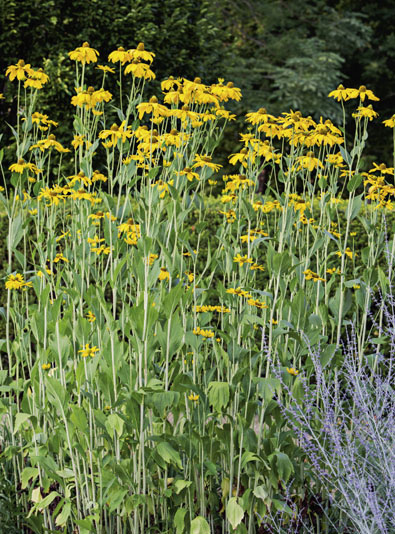
Rudbeckia nitida
Rudbeckia subtomentosa
• yellow
• early summer to midfall
• 3–4 ft. × 1–2 ft.
• sun, part shade
• Z4–8, HS
Sweet coneflower. Central United States. Toothed, gray-green leaves, downy beneath and three lobed at base of plant. Anise-scented, 3-in. flowerheads with yellow rays and dark brownish purple cones, are borne on branching stems. Thrives on average to clay soils, but intolerant of drought. Stake if necessary. Watch for snails and slugs, powdery mildew. Appropriate in borders, meadow and prairie plantings, and cottage gardens.
‘Henry Eilers’ bears bright yellow flowers with narrow, quilled rays, and reddish brown cones.
Rudbeckia triloba
• yellow
• early summer to midfall
• 2–3 ft. × 1–1.5 ft.
• sun
• Z4–8
Brown-eyed Susan. Eastern and central United States. Biennial or short-lived perennial that self-seeds freely and often naturalizes. Clumps of densely branched stems bear three- or sometimes five- or seven-lobed, rough, coarse leaves. Yellow-rayed, 1- to 1.5-in. flowerheads with purple-brown disks bloom profusely through summer and fall. Prefers moist, humus-rich soil but adapts to any well-drained soil. Tolerates light shade, heat, moderate drought. Perfect for meadow and prairie plantings, good for cottage gardens. Deadhead to control self-seeding.
‘Prairie Glow’ has chocolate-centered heads with bicolored rays of burgundy, bronze, or reddish orange shades, always tipped with gold. 5 ft. × 3 ft.
Acanthaceae
wild petunia
Although not related to the petunias commonly grown as summer annuals, the so-called wild petunias do have a similar-looking bloom. Many species are tropical subshrubs with large, exotic flowers mostly held in the upper leaf axils. Those described below are perennial, suitable for cottage and wild gardens, watersides, rock gardens, and informal borders; native species are ideal for native plant gardens. Where not hardy, they may be grown as annuals or container plants.
The foliage of ruellias is undivided, often with lightly toothed rims. The leaves, stalked or sessile, are carried in opposite pairs, and often are wrinkled, possibly with attractive, conspicuous deep veining. Trumpet-shaped flowers flare at the mouth with five petal-like lobes; typically, individual blossoms last just one day, but usually there are plenty of buds.
Ruellias prefer moist, fertile soils that drain well; some, however, tolerate much wetter conditions. They grow best in full sun, but provide some shade in intense sun regions. Several species are nectar sources or larval food for butterflies; common buckeyes, Texan crescents are frequent visitors, as are bees. Deer mostly ignore ruellias, although during dry spells, succulent young growth may be browsed by deer and rabbits. The leaves are sometimes infected with rust; waterlogged soil encourages root rot.
Sow seed in spring. Spring or early summer softwood cuttings root readily.
Ruellia brittoniana
syn. R. tweediana
• lavender
• summer
• 3 ft. high and wide
• sun
• Z8–10, HT
Mexican petunia. Mexico. Upright, branching stems, slightly woody at the base, are clothed with dark green, 0.5-in.-wide, linear leaves, 6–12 in. in length. Axillary clusters of 1- to 2-in., lavender to violet, trumpet-shaped flowers have broadly rounded lobes. Note that this species has escaped cultivation in parts of the southeastern United States, including Florida, where is it considered an exotic invasive, pushing out native plants, especially in wetland areas. Check with your local Cooperative Extension office prior to planting.
The following selections are hardy in Z7–10:
‘Colobe Pink’ (Bonita pink) is dwarf, with pink flowers. Non-invasive. 8 in. × 24 in. ‘Chi Chi’ (hardy pink ruellia) has pink flowers. Good for rustic and water-wise gardens; invasive in moist, tropical and semi-tropical climates. 24 in.
‘Katie’ (Katie’s dwarf ruellia) is a dwarf form from Texas. Blooms continuously through the summer with 1.5-in., purple trumpet flowers. Reseeds in good conditions, but is not invasive. 6 in. × 12 in. Similar ‘White Katie’ has clean, white flowers. 8 in. × 12 in.
Ruellia elegans
• red
• late spring to fall
• 12–24 in. × 24 in.
• sun, part shade
• Z8–10, HS
Brazilian petunia, Thai ruellia, elegant ruellia. Brazil. This tough but elegant, upright perennial attracts hummingbirds and butterflies, and is a larval food source for Texas crescent butterflies. Clusters of five to six coral-red, tubular flowers top long, slender stems. Evergreen foliage provides winter interest in cottage or woodland gardens, and beside ponds and lakes. Tolerates wet boggy sites. Spreads moderately but not invasive. Mulch heavily in zone 7; grow in containers, outside its hardiness zones.
Ruellia humilis
• lavender
• early to late summer
• 18–36 in. × 18–24 in.
• sun, part shade
• Z4–8
Wild petunia, fringeleaf wild petunia. Dry, open woods and prairies from Pennsylvania to Indiana, and south to Alabama. Erect and bushy, with bright green, sessile, oval to elliptic leaves, to 3 in. long. Solitary, lavender flowers about 2 in. across are petunia lookalikes. Pollinated by nocturnal hawk moths and bees, the plants also produce less showy, closed, self-pollinating flowers as insurance for seed production. Suitable for open wild and native plant gardens, perhaps with prairie grasses, milkweeds, purple coneflowers, and evening primroses.
Rutaceae
rue
Traditionally grown in herb gardens for medicinal purposes, rue is exceptionally adaptable. Today, this woody-based subshrub is more likely to find a spot in contemporary gardens by virtue of its attractive foliage. It thrives in moderately fertile, moist, well-drained soils, but tolerates shallow and rocky ones, as well as drought and heat. When bruised or crushed, the foliage releases a pungent odor; the oils irritate sensitive skins. A useful foliage note in borders and rock gardens; the blue-green leaves make an energizing contrast to yellow-flowered neighbors.
No serious pests or diseases; susceptible to root rot where drainage is poor. Deer resistant. Tolerates light shade. Cut back to old wood in spring to promote healthy, bushy growth.
Propagate by seed or cuttings.
Ruta graveolens
• yellow
• early summer
• 2–3 ft. high and wide
• sun
• Z4–8
Common rue, herb of grace. Southeastern Europe, but naturalized as a garden escapee in parts of the United States, notably the Northeast. Feathery mounds of waxy, blue-green, 3- to 5-in. leaves, pinnately twice divided into rounded, oblong, or spatulate segments. Small, four- to five-petaled, dull-yellow flowers appear in flattened clusters above the leaves.
‘Blue Mound’ has a shapely, mounding habit; deep blue-green foliage. 12–15 in.
‘Jackman’s Blue’ has lush, metallic-blue foliage. 24 in. × 30 in.
‘Variegata’ has bluish green leaves splashed with white; excellent for floral arrangements.
Caryophyllaceae
pearlwort
This moss lookalike plant can be used as a lawn substitute in cool areas as it tolerates light foot traffic. Excellent between pavers or flag stones, and in rock gardens, perhaps with Mazus reptans and woolly thyme. Taller species, including low dianthus, also make good companions.
Increase by division.
Sagina subulata
syn. Sagina pilifera, Arenaria caespitosa
• white
• early to late spring
• 1–4 in. × 10–12 in.
• sun, part shade
• Z4–8
Irish moss, Corsican pearlwort, health pearlwort. Mountains of Sardinia and Corsica. Tiny, white, four- or five-petaled flowers crown the bright green, evergreen carpet of 0.5-in.-long leaves. Best in acid or neutral, well-drained but evenly moist soil; protect from intense sun in hotter regions. Often confused with Minuartia verna (syn. Arenaria verna var. caespitosa), also commonly called Irish moss.
‘Aurea’ (Scotch moss, syn. Arenaria caespitosa ‘Aurea’) has slender stems that form a golden carpet. Nice as a textural contrast with golden creeping Charlie.
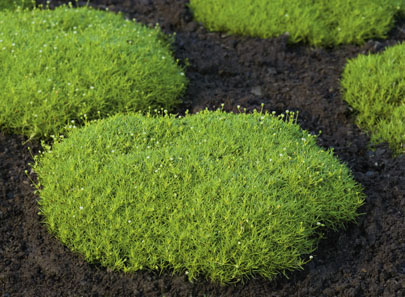
Sagina subulata ‘Aurea’
Lamiaceae
sage
This enormous genus is most familiar to gardeners in the form of the ubiquitous scarlet sage (Salvia splendens), a frost-intolerant species with spikes of hot-red flowers, commonly grown for bedding. With some 750-plus species, however, the sages also offer many fine hardy and tender perennials. These have become mainstays of beds, borders, and cottage gardens across the country. In particular, the southwestern and central US species have become invaluable in hot, dry gardens, and a critical source of color for containers, xeriscapes, and water-wise landscapes across the country. Many make fine cut flowers.
Sages exhibit the stems, square in cross section, opposite leaves, and racemes or panicles of two-lipped flowers, typical of the mints. Flower colors include blues, pinks, and reds, or less often white or yellow. Usually foliage is entire, but sometimes pinnately divided, often toothed along the margins; the leaves may be coated with hairs that protect them from water loss, and increase drought tolerance. Leaves are often aromatic. Seldom affected by pests and diseases, although occasionally infestations of whiteflies, aphids, mealybugs, spider mites, and powdery mildew occur. Grazing deer and rabbits mostly avoid sages.
Sow seed of species in spring or early fall. Increase cultivars by softwood cuttings or divide mature clumps, both in spring.
Salvia argentea
• white
• summer
• 24–36 in. × 24 in.
• sun
• Z5–8, HS
Silver sage. Southern Europe, northern Africa. Grown mostly for its beautiful furry, silver leaves; short lived, behaves as a biennial. Basal rosettes of oblong, 7- to 8-in.-long, toothed leaves. Spikes of whitish flowers appear the second year in many-branched, terminal panicles. Self-seeds. A great accent plant.
Salvia chamaedryoides
• blue
• early summer to fall
• 18–24 in. × 24–48 in.
• sun, part shade
• Z7–10
Germander sage, blue oak sage. Mexico. Broad rhizomatous mounds of woody stems and quilted, downy, sage-green leaves. Spikes of sky-blue flowers bloom heavily in early summer, then intermittently until a fall flush. This fast-growing species thrives in sun and heat, prefers loamy, moist, well-drained soil; drought tolerant once established. Attracts hummingbirds and butterflies. Good for beds and borders, container plantings, and suitable for cottage or desert gardens, xeriscapes, and rock gardens.
Salvia farinacea
• blue
• late spring to early fall
• 1–3 ft. × 1–2 ft.
• sun, part shade
• Z7–10
Mealycup sage. Texas, Mexico. Commonly grown as a warm-weather annual, but an invaluable perennial where hardy. Shrubby, clumping with branching stems. Serrate, ovate-lanceolate, gray-green leaves, to 3 in. long. Violet-blue flowers, with white-powdered (“mealy”) calyxes, are borne in 4- to 8-in., terminal and axillary racemes. Prefers evenly moist, well-drained soil, but tolerates clays, moderate drought, and dryish soils, but not winter wet. Attracts butterflies. Adaptable and valued for beds and borders, meadows, cottage and cutting gardens.
‘Augusta Duelberg’ blooms heavily with silvery-white flowers from late spring until frost. 2.5 ft. × 4 ft.
‘Strata’ is a seed strain with blue-and-white, bicolored flowers. 18 in. × 12 in.
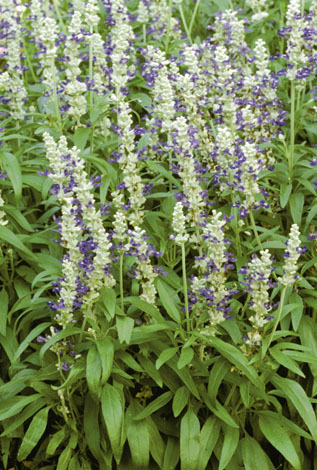
Salvia farinacea ‘Strata’
‘Victoria Blue’ is compact with deep violet-blue flowers. 16 in. × 12 in.
Salvia greggii
• red, pink, purple, yellow
• early spring to fall
• 1–3 ft. high and wide
• sun
• Z8–10, HT
Autumn sage. Upland areas of southwest Texas to central Mexico. Evergreen, upright or mounding with stems woody at the base; medium green leaves are glabrous, simple, and elliptical to 1 in. long. Blooms over an extended season, profusely in fall, with 0.25- to 1-in. flowers. Adapts to a wide range of well-drained conditions; quite drought tolerant but bloom is best with weekly irrigation. Thrives in the hot, humid southeastern United States and the humid Pacific Northwest. Attracts hummingbirds.
‘Big Pink’ has large, violet-pink flowers with dark maroon calyxes. 2.5–3.5 ft. Z7–10.
‘Lowry’s Peach’. Yellow-throated, reddish orange blooms with creamy-peach lower lips. Glossy foliage. 3 ft. × 3 ft. Z7–9.
‘Maraschino’ has bold scarlet-red flowers. Blooms almost non-stop. 3–4 ft. × 2–3 ft. Z7–10.
‘Variegata’ (desert blaze Texas sage) has white-edged leaves; bright red flowers. 2 ft. × 3 ft. Z8–10.
‘Wild Thing’ produces spectacular coral-pink flowers. Vigorous. Z5.
Salvia guaranitica
• blue
• summer to fall
• 4–6 ft. × 4.5 ft.
• sun
• Z7–10
Blue anise sage. Argentina, Brazil. Dark green, 4- to 6-in. leaves are barely hairy. Brilliant deep blue flowers in whorls of three to eight, on very long spikes. Upper flower petals appear to hover above shorter lower petals. Nectar source for hummingbirds.
‘Argentine Skies’ has spikes of pale blue flowers.
‘Black and Blue’ produces spikes to 12 in. long; flowers are deep blue, with black calyces. 3–6 ft. ‘Costa Rica Blue’ is very similar.
‘Van Remsen’ is a stunning giant selection. Spikes of cobalt-blue flowers. 6–7 ft.
Salvia officinalis
• blue
• late spring to early summer
• 12–24 in. × 24–30 in.
• sun
• Z4–8
Common sage, culinary sage. Mediterranean region. Wrinkled, strongly aromatic, 3- to 4-in., gray-green leaves on woody stems. Whorls of 0.5- to 1-in., lavender-blue flowers borne in erect spikes. This standard culinary species can be used as a hardy ornamental in borders, or cottage, herb, and kitchen gardens. Prefers average, medium-moist, well-drained soils, but tolerates dry, rocky ones.
‘Aurea’ has leaves variegated gold and light green. 12–18 in.
‘Berggarten’ has deep blue flowers; large, broad, gray-green leaves. 24 in.
‘Icterina’ (golden variegated sage) has foliage irregularly splashed with gold. 8–16 in.
‘Purpurascens’ has purplish leaves. 12–24 in. tall.
‘Tricolor’ has marbled gray-green, white, and purple foliage edged with pink. 12–18 in.
Salvia patens
• blue
• summer to fall
• 18–24 in. × 12 in.
• sun, part shade
• Z8–10
Gentian sage. Whorls of 1-in. flowers in the most glorious shades of gentian blue. Erect, bushy stems, clothed with aromatic, ovate leaves, rise from tuberous roots. Tolerates heat and drought. May need staking.
‘Oceana Blue’ (‘Salsyll’) has deeper blue flowers. 24–36 in.
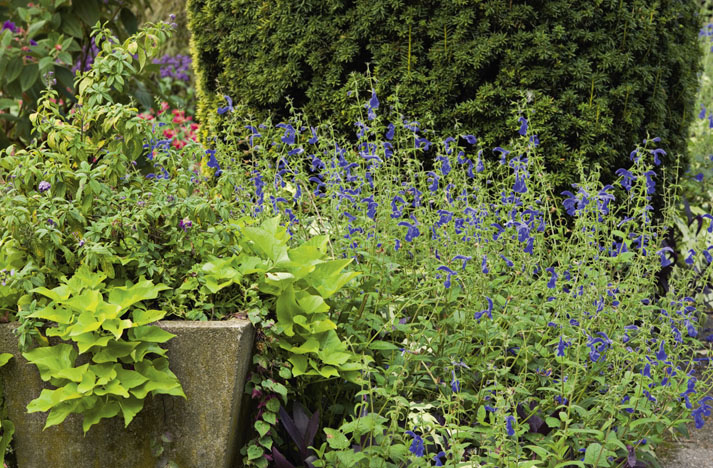
Salvia patens in a border setting with Ipomoea battatus ‘Margarita’
Salvia pratensis
• lavender-blue
• late spring to late summer
• 1–3 ft. high and wide
• sun
• Z4–8
Meadow sage, meadow clary. Europe. Clump forming with mildly aromatic, 6-in., dull gray-green leaves. Upright, dense, spike-like racemes of tiny, deep lavender-blue flowers, often with sporadic rebloom through summer, if cut back as first flush fades. Thrives in average, well-drained soil. Tolerates drought and very light shade. Mostly available as cultivars.
‘Eveline’ produces an abundance of pink-flowered spikes from early to midsummer. Glossy foliage; compact, bushy. To 24 in.
‘Rhapsody in Blue’ is a prolific bearer of blue-and-violet flowered spikes. Broad, gray-green leaves; compact, bushy habit. 20–24 in.
‘Swan Lake’ has wrinkled, light green leaves; 20-in. spikes of pure white flowers.
Salvia ×sylvestris
syn. S. nemorosa
• purple, white, pink
• early summer to fall
• 3 ft. × 2 ft.
• sun
• Z4–8
Hybrid sage. Of garden origin. Clump forming with wrinkled, aromatic, green, lanceolate leaves, to 3 in. long. Spikes of showy flowers all season. Prefers moist, well-drained soil, but tolerates dry, poor ones. Available in the trade mostly as cultivars, which are many. Although European Salvia nemerosa is listed as a synonym, there is much taxonomic confusion; some selections are more likely to belong to the latter species than to S. ×sylvestris.
‘Blue Hill’ has true blue flowers. 18–24 in.
‘Caradonna’. Abundant spikes of violet flowers, on deep purple stems. 24 in.
‘East Friesland’ (‘Ostfriesland’) has bluish green foliage; narrow spikes of violet flowers in late spring to early summer, repeats in early fall. Sterile. 16–20 in.
‘Marcus’ (‘Haeumanarc’) is dwarf, long blooming with deep violet flowers. 8–10 in.
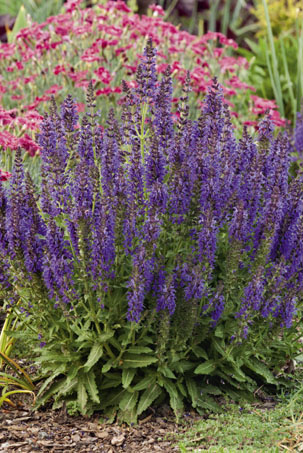
Salvia ×sylvestris ‘Marcus’
‘New Dimension Rose’ is dwarf, with bright rose-pink flowers from early to midsummer. 8–10 in. Z5–7.
‘Snow Hill’ produces white flowers in early summer; cut back for later rebloom. 18 in.
Salvia verticillata
• lilac-blue
• early summer to late summer
• 18–30 in. × 18–24 in.
• sun
• Z5–7
Lilac sage. Europe, western Asia. Clumps of erect to arching stems, with hairy, coarse, and broadly ovate-triangular, medium green leaves, to 5 in. long. Terminal racemes of small, lilac-blue flowers all summer. Prefers average, moderately moist to dry, well-drained soils. Overly fertile soils encourage soft, lax growth. Drought tolerant. Shear plants after flowering to encourage neater growth and possible fall rebloom.
‘Endless Love’, 14–20 in., has medium purple flowers; heavier blooming, improved form of the Piet Oudolf introduction, ‘Purple Rain’.
‘White Rain’ has a rounded, spreading habit; pure white flowers. 20 in. × 36 in.
Other Notable Cultivars
‘Indigo Spires’ (Salvia farinacea × S. longispicata) is bushy, with twisting, 24- to 36-in.-long spikes of 0.5-in., purple flowers; late summer to fall. 3–4 ft. Z7–11.
‘Mystic Spires Blue’ (‘Balsalmisp’) is similar in color but on much more compact plants.
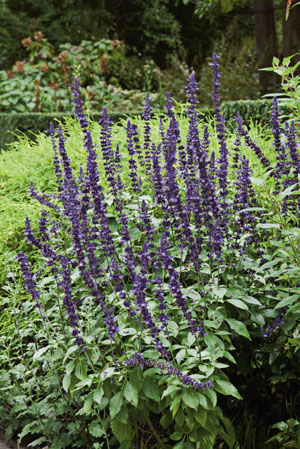
Salvia hybrid ‘Mystic Spires Blue’
‘Wendy’s Wish’ has dark maroon stems that bear brilliant non-fading, cherry-red flowers. Sterile, long blooming. Fine for containers. 40 in. Z9–11.